Toshiba Information Systems RG4-E01 GSM/UMTS/HSDPA Mobile Phone User Manual
Toshiba Information Systems (UK) Ltd, Mobile Communications Division GSM/UMTS/HSDPA Mobile Phone
Contents
- 1. User Manual for SP2RG4E01
- 2. User Manual
User Manual
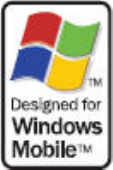
TOSHIBA
RG4-E01
User Manual Version 1.0
Copyright©2006 TOSHIBA CORPORATION, All rights reserved.
INTRODUCTION
Congratulations on choosing the TOSHIBA RG4-E01, which is
customized for Vodafone live!
We hope that you will be pleased with this new wireless phone incorporating 3G
technology, also known as UMTS. This phone provides advanced entertainment features
including video telephony, video messaging and high-speed access to Vodafone live!
The TOSHIBA RG4-E01 has a sophisticated design, high-quality 65,000 colour display
and 2 mega pixel camera. Furthermore, you can rotate the colour display to suit your
needs.
NETWORK SERVICES
To use the phone you must have service from a wireless service provider. Many of the
features in this device depend on features in the wireless network to function. These
Network Services may not be available on all networks or you may have to make specific
arrangements with your service provider before you can utilize Network Services. Your
service provider may need to give you additional instructions for their use and explain
what charges will apply. Some networks may have limitations that affect how you can use
Network Services. For instance, some networks may not support all language dependent
characters and services.
This wireless device is a 3GPP GSM Release 99 terminal supporting GPRS service, and
is designed to support also Release 97 GPRS networks. However, there may be some
compatibility issues when used in some Release 97 GPRS networks. For more
information, contact your service provider.
IMPORTANT SAFETY INFORMATION
• The device is not charged when you take it out of the box. The battery should be
charged for at least 8 hours before first use. Do not remove the battery while charging.
• Do not use batteries, which have not been specified by the manufacturer, as this may
cause leakage or rupture.
• Do not charge the battery with an unspecified AC Adapter, as this may cause damage to
both the device and the battery.
• When discarding the batteries, dispose of them in a proper manner, according to the
battery manufacturer’s instructions and your local laws.
• Power off the device and remove the battery before inserting SIM card. Make sure the
SIM card snaps correctly into the SIM socket.
• Do not open or tamper with the device cover, as it will void your warranty.
• Do not press hard on this product, as it may cause damage to the screen or the internal
components.
• Do not use the device at gas or refuelling stations, chemical plants, and places
containing explosives or flammable materials.
• Do not strike, shake, or heat the device in a way which may cause battery leakage or
rupture and damage to the device.
• Do not scratch the screen with hard objects.
• Do not clean the screen with chemical detergents. Only use cloths, specifically designed
for cleaning liquid displays, to wipe the device screen.
• Do not expose the device to direct sunlight, or leave the device in a humid environment,
for extended periods of time, as this may cause damage to the device and battery.
• Do not immerse the device in water.
• The device may interfere with the navigation and/or communication systems on aircraft.
The use of the device on aircraft is prohibited by laws in most countries.
• Use hands-free devices, if you need to use the telephony services, while driving a
vehicle.
Care and Maintenance
If you maintain your phone in good condition, the quality of your phone usage as well as
the phone life span will be greatly enhanced.
If you follow the suggestions below, this will also help you to fulfill warranty obligations.
• Keep the phone and all the parts and accessories out of the reach of small children.
• Keep the phone dry as moisture of any kind can contain minerals that will corrode the
electronic circuits.
• Do not use or store the phone in dusty or dirty locations as the moving parts of the
phone can be damaged.
• Do not use or store the phone in hot areas. High temperature will shorten the life span of
the phone, damage the battery or warp/ melt the plastic used in the phone’s manufacture.
• Do not store the phone in cold areas. When there is a difference in temperature
between the room and the phone, condensation can form inside the phone, causing
damage to the electronic circuits.
• Do not open the phone unless absolutely necessary, for example, to install the battery
or SIM card. We recommend that you go to your dealer when problems arise with either
of these items and allow their experts to handle the phone instead.
• Do not mishandle or abuse the phone. Dropping it, knocking or shaking it can damage
the internal circuits.
• Do not use harsh chemicals, strong detergents, or cleaning solvents to clean the phone.
If you must clean it, then use a soft, clean, dry, lint-free cloth.
• Do not apply paint or other such substances to the phone. This could clog the phone’s
moving parts.
• If the phone or any of the accessories are not working as they should, please consult
your dealer who can provide you with the expert assistance that you require.
• Interference may affect your phone’s performance. This is perfectly normal and once
you move away from the source of the interference, the phone should operate as usual.
• Do not attempt to disassemble your product. Only Toshiba authorized personnel should
perform service.
FCC Notice
This device complies with Part 15 of the FCC rules. Operation is subject to the following
two conditions: (1) This device may not cause harmful interference, and (2) This device
must accept any interference received, including interference that may cause undesired
operation. Changes or modifications not expressly approved by the party responsible for
compliance could void the user's authority to operate the equipment.
Information to User
This equipment has been tested and found to comply with the limits of a Class B digital
device, pursuant to Part 15 of the FCC Rules. These limits are designed to provide
reasonable protection against harmful interference in a residential installation. This
equipment generates, uses and can radiate radio frequency energy and, if not installed
and used in accordance with the instructions, may cause harmful interference to radio
communications.
However, there is no guarantee that interference will not occur in a particular installation;
if this equipment does cause harmful interference to radio or television reception, which
can be determined by turning the equipment off and on, the user is encouraged to try to
correct the interference by one or more of the following measures:
1. Reorient/relocate the receiving aerial.
2. Increase the separation between the equipment and receiver.
3. Connect the equipment into an outlet on a circuit different from that to which the
receiver is connected.
4. Consult the dealer or an experienced radio/TV technician for help.
Caution: Changes or modifications not expressly approved by the manufacturer
responsible for compliance could void the user's authority to operate the equipment.
INTERFERENCE WITH MEDICAL EQUIPMENT FUNCTIONS
This product may cause medical equipment to malfunction. The use of this device is
forbidden in most hospitals and medical clinics.
NONIONIZING RADIATION
This product should be operated in the suggested normal condition only to ensure the
radiative performance and safety of the interference. As with other mobile radio
transmitting equipment, users are advised that for satisfactory operation of the equipment
and for the safety of personnel, it is recommended that no part of the human body be
allowed to come too close to the antenna during operation of the equipment.
TRADEMARK INFORMATION
Microsoft, MS-DOS, Windows, Windows NT, Windows Server, Windows Mobile,
ActiveSync, Excel, Internet Explorer, MSN, Outlook, PowerPoint, and Word are either
registered trademarks or trademarks of Microsoft Corporation in the United States and/or
other countries.
DANGER
•Do not disassemble, modify or repair the handset, battery pack, charger, Stereo
Earphone or BluetoothTM Stereo Headset
•Doing so may cause overheating, rupturing, fire, electric shock, injury or malfunction.
Modification of the handset is prohibited by Japanese Radio Law. For repair, contact your
nearest SoftBank Shop or SoftBank Customer Assistance (page 21-53).
•Do not dispose of the handset, battery pack, charger, Stereo Earphone or BluetoothTM
Stereo Headset in a fire or expose it to heat. If the handset or battery pack is exposed to
water, do not dry it artificially in heating equipment (microwave oven, etc.)
•Doing so may cause overheating, rupturing, fire or malfunction.
•Do not charge, use or leave the handset, battery pack, charger, Stereo Earphone or
BluetoothTM Stereo Headset in hot places such as near a fire or heater
•Doing so may cause overheating, rupturing, fire or malfunction.
•Do not expose the handset, charger, battery pack , Stereo Earphone or BluetoothTM
Stereo Headset to fluids such as water, perspiration or seawater
•Doing so may cause overheating, rupturing, fire, electric shock or malfunction. If the
handset is dropped accidentally in water or any other fluid, immediately turn off the
handset.
•Do not leave the handset, charger, battery pack, Stereo Earphone or BluetoothTM
Stereo Headset outdoors, in a bathroom or wherever water or any other fluid is used Do
not place the handset, charger or battery pack near cups, vases or other containers of
fluids
Exposure to water or other fluids may cause electric shock, overheating, rupturing or fire.
•Do not use excessive force when inserting the battery pack into the handset or
connecting the handset to the charger Do not connect any cords with reverse polarity
•Doing so may cause the battery pack to leak, rupture, overheat or catch fire, as well as
cause electric shock or malfunction.
•Do not touch the battery pack connectors (metal parts) with any metal objects (necklace,
hairpin, etc.)
•Doing so may cause the battery pack to overheat, rupture or catch fire, as well as the
metal object to overheat.
•Do not use a battery pack other than one supplied with or designated for the handset Do
not use the battery pack for any other handset
•Doing so may cause overheating, rupturing, fire or malfunction.
•Do not use a charger other than one supplied with or designated for the handset to
charge the battery pack Do not use the charger for any other handset
•Doing so may cause overheating, rupturing, fire or malfunction.
•Do not charge, overheat, disassemble or short the dry battery of BluetoothTM Stereo
Headset or put it into a fire.
•Doing so may cause ignition, rupturing, malfunction or fire.
If electrolyte fluid leaking from the dry battery of BluetoothTM Stereo Headset comes into
contact with your skin or clothes, wash it immediately with clean water as this may hurt
your body. And if it gets into your eyes, do not rub them, and have them immediately
treated by an ophthalmologist after washing them with clean water. If the fluid sticks to
the equipment, wipe it out without touching it directly.
If the fluid is left as it is, your skin may get irritated or there may be fear of losing your
sight.
WARNING
•Do not charge the battery pack while it is wet or damp
•Doing so may cause overheating, rupturing, fire, electric shock or short circuit. If the
battery pack is exposed to fluids such as water, unplug the rapid charger immediately.
•Do not use the handset while driving Do not make or receive a call and do not use other
functions (messaging, game, camera, video, music, mobile light, etc.)
•Doing so may cause a traffic accident. Use of the handset while driving is prohibited by
law. Before using the handset, stop the vehicle in a safe area where parking is
permitted.
•Do not use the handset wherever there is the risk of a fire or explosion such as in a
petrol station
•Doing so may ignite the gases and start a fire or explosion. Turn off the handset and do
not charge it wherever gases may be present (petrol station, etc.).
•Do not swing the handset by its strap, a video output cable, the Stereo Earphone or
BluetoothTM Stereo Headset
•Doing so may cause an injury, accident or damage.
Turn off the handset while you are near any precision electronic equipment. Radio waves
may adversely affect the operation of electronic equipment. Examples of such equipment:
medical electronic equipment such as cardiac pacemakers and hearing aids or fire
alarms and automatic doors. If you use medical electronic equipment, consult with the
equipment manufacturer or distributor about the influence of radio waves.
Remove the power plug from the outlet if the rapid charger is not to be used for a long
period of time or before cleaning
Failing to do so may cause an electric shock, fire or malfunction.
Turn off the handset wherever its use is prohibited such as on an aircraft Cancel schedule
and alarm settings before turning handset power off
Use of the handset on an aircraft is prohibited by law.
Check your surroundings to confirm that it is safe to make/receive calls, send/receive
messages, take pictures or record videos
Failing to do so may cause you to trip over or cause a traffic accident.
Do not use the handset with any power voltage other than the specified voltage
Doing so may cause a fire. The power voltages are 100 to 240 V AC for the rapid charger
and 12 or 24 V DC (for a negative ground car only) for an In-Car Charger.
Wipe away any dust on the plug of the rapid charger with a dry cloth after removing the
plug from the outlet
Dust on the plug or outlet may cause a fire.
Follow the instructions below when installing and wiring in-vehicle devices
・Make sure that devices do not interfere with driving and safety equipment such as
airbags
・Make sure that wires are not caught in seatbelt buckles, doors or other moving
parts
Any wire caught around a foot, brake pedal, accelerator pedal, etc. may interfere with
driving and cause a traffic accident. If any part of an in-vehicle device drops onto the floor,
it may startle you into abrupt braking or steering, leading to a traffic accident.
If electrolyte fluid leaking from the battery pack gets into your eyes, wash your eyes
immediately with clean water and have your eyes treated by an ophthalmologist
Failing to receive treatment for your eyes may result in eye injury.
When thunder is heard outside, stop using the handset immediately Turn off the handset
and do not touch it
Failing to do so may attract lightning and cause electric shock. When thunder is heard,
stop using the handset and move to a safe place such as inside a building.
If the battery pack fails to charge in the specified time, stop charging immediately failing
to do so may cause overheating, rupturing or fire.
When inserting the rapid charger plug into an AC household outlet, make sure that a
metal strap or any other metal object does not touch the plug
Failing to do so may cause electric shock, short circuit or fire.
If something unusual happens to the handset, battery pack or charger; for example, it
emits smoke or an unusual odour or is damaged, perform the following steps immediately
1. If the battery pack is charging, unplug the rapid charger from the AC household outlet
or unplug the In-Car Charger from the cigarette lighter socket.
2. Make sure that the handset is not hot, then turn it off and remove the battery pack.
Failing to do so and continuing use (charging) may cause the battery pack to overheat,
rupture or catch fire or the handset to overheat.
Do not drop the handset or battery pack or subject it to excessive shock
Doing so may cause overheating, rupturing, fire or malfunction.
Do not sit down with the handset in your trousers pocket
Excess weight may damage the display, battery pack or other parts resulting in
overheating, fire or injury.
If the handset is used near an implanted cardiac pacemaker, defibrillator or other
electronic medical equipment, radio waves may interfere with such a device or equipment
Observe the following guidelines
1. If you have an implanted cardiac pacemaker or defibrillator, carry and use the handset
at a distance of at least 22 centimetres away from the implanted device.
2. Turn off the handset in crowded places such as packed trains because a person with
an implanted cardiac pacemaker or defibrillator may be nearby. Radio waves can
interfere with the operation of a cardiac pacemaker or other medical device.
3. Follow the precautions below in medical institutions.
ٛ ・Do not bring the handset into an operating room, intensive care unit or coronary
care unit.
ٛ ・Turn off the handset in a hospital ward.
ٛ ・Turn off the handset in a lobby or other location close to medical equipment.
ٛ ・Observe the instructions of individual medical institutions and do not use the
handset in or bring it into prohibited areas.
ٛ ・Turn off the handset after cancelling any settings such as schedule and alarm
settings that turn on the handset automatically.
4. When using electronic medical devices other than an implanted cardiac pacemaker or
defibrillator outside of medical institutions (such as at home), consult with the individual
medical device manufacturer about the possible influence of radio waves.
The above information conforms to "The Guidelines on Use of Mobile Phones and
Other Devices to Prevent Electromagnetic Wave Interference with Electronic Medical
Equipment" (Electromagnetic Compatibility Conference Japan, April 1997), as well as
refers to "The Investigative Research Report on the Influence of Electromagnetic
Waves on Medical Equipment" (Association of Radio Industries and Businesses,
March 2001).
Do not use the rapid charger with any power supply other than a 100 to 240 V AC
household power supply
Doing so may result in a fire, as well as cause the charger to overheat, catch fire or
malfunction.
Do not insert the dry battery of BluetoothTM Stereo Headset with wrong polarity [(+) &
(-)].
Doing so may cause the malfunction of the equipment as well as cause the dry battery to
leak.
Do not use the dry battery of BluetoothTM Stereo Headset after the “Recommended
Use-by Date” displayed on the battery expired, or do not leave the used-up dry battery as
being inserted.
Doing so may cause the malfunction of the equipment as well as cause the dry battery to
leak.
Keep the dry battery of BluetoothTM Stereo Headset out of the reach of small children.
If it is mistakenly swallowed, consult a doctor as soon as possible because this may
cause suffocation or injury to stomach etc.
CAUTION
Do not use or leave the handset or battery pack in places where it will be exposed to
direct sunlight or in hot places such as inside a car in the sun
Doing so may cause overheating, fire or malfunction.
Keep the handset, battery pack and charger away from infants and small children
Failing to do so may result in the battery pack or memory card being accidentally
swallowed or cause an injury.
Make sure that the charger terminals (metal parts) do not come into contact with wires or
other metal objects
Failing to do so may cause overheating or burns.
Do not pull the cord when unplugging the rapid charger or In-Car Charger from an AC
household outlet or socket
Damage to the cord may cause electric shock, overheating or fire. Hold the plug when
unplugging the rapid charger or In-Car Charger.
Do not pull, bend with excessive force or twist the cords of the rapid charger and In-Car
Charger Do not damage or modify them Do not place objects on them Do not apply heat
and keep them away from heaters
Damage to a cord may cause electric shock, overheating or fire.
Do not plug or unplug the rapid charger with wet hands
Doing so may cause electric shock or malfunction.
Keep magnetic cards away from the handset and make sure that a magnetic card is not
trapped when closing the handset
Failing to do so may cause the magnetic data on a cash card, credit card, telephone card
or floppy disk to be lost.
Do not use the handset in a vehicle if it affects in-vehicle electronic devices
Use of the handset in some types of vehicles may, in some rare cases, affect in-vehicle
electronic devices and interfere with safe driving.
Do not place the handset on an unstable or unlevel surface
Doing so may result in the handset falling and causing injury or malfunction. Be
particularly careful when vibration is set.
Do not dispose of the used battery pack with ordinary garbage
Insulate the connectors with tape and then dispose of the used battery pack separately
from ordinary garbage or take it to your nearest SoftBank Shop. Be sure to observe local
regulations on the separate collection of used batteries, wherever applicable.
Do not touch the handset with sweaty hands or place it into a pocket of sweaty clothes
Sweat and humidity may erode the internal components of the handset and cause
overheating or malfunction.
Do not use the In-Car Charger when the car engine is not running
Doing so may result in a flat battery.
If the fuse for the In-Car Charger blows, replace it with a designated fuse
Replacing the fuse with other than a designated fuse may cause overheating and fire.For
details on replacing the fuse, refer to the instruction manual of the In-Car Charger.
If fluid leaking from the battery pack comes into contact with skin or clothing, wash it away
immediately with clean water
Failing to do so may cause skin irritation.
Do not use any other dry batteries than the AAA battery for BluetoothTM Stereo Headset.
Doing so may cause the malfunction of the equipment as well as cause the dry battery to
leak.
If your skin becomes irritated, immediately stop using the handset and consult with a
dermatologist
The following materials and surface treatments have been used for the handset. Some of
these materials may cause itching, irritation, eczema, etc. in some rare cases depending
on the individual's constitution and physical condition.
Before using the handset, make sure that no metal objects (such as pins) are stuck to the
earpiece
Failing to do so may result in a metal object causing an ear injury, etc.
If you have a weak heart, be careful with the call vibration and ringtone volume settings
Failing to do so may startle you and may be harmful to your heart.
Be careful not to trap your fingers or objects when closing the handset and not to trap
your fingers in the hinge when opening the handset
Failing to do so may cause injury or damage to the LCD display.
Do not use the mobile light and flashlight for purposes other than taking pictures,
recording videos or lighting
Doing so may dazzle the eyes and cause impaired vision or other injury.
Make sure things like paper, cloth and bedding are not placed on the handset during
charging using a USB connection, AC adapter, etc.
Failing to do so may cause overheating, fire, burns or malfunction.
Do not turn the volume up too high while using the Stereo Earphone or BluetoothTM
Stereo Headset Do not use Stereo Earphone or BluetoothTM Stereo Headset
continuously for long periods of time
Exposure to high sound levels may impair hearing and prolonged use may cause hearing
defect regardless of the volume level. Sound leakage may annoy other people and
surrounding sounds may not be heard clearly resulting in an accident.
Do not insert objects other than the memory card into the memory card slot
Doing so may cause overheating, electric shock or malfunction. Cover the slot with the
cap at times other than when you are inserting or removing the memory card.
Keep your face away from the memory card slot when inserting or removing the memory
card Keep the memory card out of the reach of small children
If the memory card is let go of suddenly, it may fly out and hit your face resulting in injury.
Do not subject the memory card to vibration or shock or remove it from the slot or turn off
the handset while data is being written to or read from the memory card
Doing so may cause data loss or malfunction.
Use only the memory card supported by the handset
Failing to do so may cause data loss or malfunction.The handset supports memory cards
with a storage capacity of up to 2 GB (as of XXX, 2006).
Do not let children use cables such as a video output cable, the Stereo Earphone or
BluetoothTM Stereo Headset unsupervised and keep cables out of infant's reach
An injury may be caused if, for instance, the cable is wrapped around a neck.
Do not use the mobile light close to eyes
Doing so may cause eye damage. Be especially careful not to take pictures or record
videos with the mobile light too close to the eyes of infants.
Do not use excessive force when inserting or removing the USIM card
Doing so may cause malfunction. Be careful not to injure a hand or finger when
removing the card.
Use only a USIM card designated for the handset
Failing to do so may cause data loss or malfunction.
Do not remove the polyester film from the external display
Using the handset without the polyester film to protect against shattering of the reinforced
glass may result in an injury if the external display is damaged.
Content
TOSHIBA............................................................................................................................................... 1
RG4-E01 .............................................................................................................................................. 1
User Manual Version 1.0.................................................................................................................... 1
INTRODUCTION.................................................................................................................................. 2
NETWORK SERVICES....................................................................................................................... 2
IMPORTANT SAFETY INFORMATION ............................................................................................ 2
INTERFERENCE WITH MEDICAL EQUIPMENT FUNCTIONS................................................... 4
NONIONIZING RADIATION ............................................................................................................... 4
TRADEMARK INFORMATION........................................................................................................... 4
DANGER ............................................................................................................................................... 5
WARNING ............................................................................................................................................. 6
CAUTION............................................................................................................................................... 9
Content ................................................................................................................................................ 12
Chapter 1 Knowing your device ....................................................................................................... 18
1.1 Getting Started ........................................................................................................................ 18
1.2 Status Indicators...................................................................................................................... 19
1.3 Entering Information............................................................................................................... 19
Input methods ..................................................................................................................... 19
Method indicators ............................................................................................................... 20
Multi-press Mode ................................................................................................................ 20
T9 Mode............................................................................................................................... 20
Numeric method ................................................................................................................. 21
To enter numbers in text.................................................................................................... 21
More tips on text entry ....................................................................................................... 21
Chapter 2 Personalizing your phone ............................................................................................... 22
2.1 Home Screen........................................................................................................................... 22
To copy an image to your phone for use as a Home screen ....................................... 22
Changing the Home screen appearance........................................................................ 22
An alternative method to set an image as the Home screen....................................... 23
2.2 Ring Tone ................................................................................................................................ 23
Specifying the sound for an event.................................................................................... 24
To change the current profile ............................................................................................ 24
Customizing a Profile......................................................................................................... 24
2.3 Settings.................................................................................................................................... 25
To set the alarm .................................................................................................................. 25
Entering owner information ............................................................................................... 25
Changing accessibility settings ........................................................................................ 26
Changing regional settings ............................................................................................... 26
Changing power management settings .......................................................................... 26
2.4 Security ................................................................................................................................... 26
Enabling your SIM PIN ...................................................................................................... 27
Disabling your SIM PIN ..................................................................................................... 27
Changing your SIM PIN..................................................................................................... 27
Enabling the Keypad lock.................................................................................................. 27
Unlocking the Keypad........................................................................................................ 28
Enabling the Device lock................................................................................................... 28
Disabling the Device lock .................................................................................................. 28
Chapter 3 Using your phone............................................................................................................. 28
3.1 Making a call........................................................................................................................... 28
Make a call by entering a phone number........................................................................ 28
Make a call by entering a contact name ......................................................................... 29
Make a call from an open contact.................................................................................... 29
Making a call from the contact list.................................................................................... 29
Making a call from Call History......................................................................................... 30
Making a call using a recently dialed phone number.................................................... 30
Making an emergency call ................................................................................................ 30
Dialing the last number called .......................................................................................... 30
Creating a speed dial ......................................................................................................... 30
Using a speed dial.............................................................................................................. 31
Viewing and editing a speed dial...................................................................................... 31
Deleting a speed dial ......................................................................................................... 31
3.2 Receiving a call....................................................................................................................... 31
Answering a call by pressing any key ............................................................................. 31
Answering or ignoring a call.............................................................................................. 31
3.3 In-Call Options........................................................................................................................ 32
Answering or postponing a second call .......................................................................... 32
Making a second call while already in a call .................................................................. 32
To join two or more calls together in a conference........................................................ 32
To put a call on speakerphone ......................................................................................... 33
3.4 Special Dialing requirements .................................................................................................. 33
Insert a manual pause in a dialing sequence................................................................. 33
Insert a three-second pause in a dialing sequence....................................................... 33
Insert an international country code ................................................................................ 34
3.5 Video Telephony ..................................................................................................................... 34
Making a video call............................................................................................................. 34
Answering a video call by pressing any key................................................................... 34
Answering or ignoring a video call ................................................................................... 34
Chapter 4 Getting connected............................................................................................................ 34
4.1 Automatic setup of your data connections .............................................................................. 35
4.2 Manual setup of your data connections................................................................................... 35
Introduction.......................................................................................................................... 35
Create a GPRS connection............................................................................................... 35
Create a dial-up connection.............................................................................................. 36
Create a proxy connection ................................................................................................ 36
Create a VPN connection.................................................................................................. 37
Connect to intranet URLs.................................................................................................. 38
Use a specific connection to connect to the chosen networks.................................... 38
4.3 Bluetooth................................................................................................................................. 39
Turn Bluetooth On and Off ................................................................................................ 39
To create a Bluetooth partnership from your device to another device...................... 40
To make your device visible to other Bluetooth users................................................... 40
End a Bluetooth partnership ............................................................................................. 41
Make your device visible to other Bluetooth devices .................................................... 41
Accept a Bluetooth partnership ........................................................................................ 41
Overview of Bluetooth virtual COM ports........................................................................ 41
Set up an incoming Bluetooth COM port ........................................................................ 42
Set up an outgoing Bluetooth COM port......................................................................... 42
4.4 Beams...................................................................................................................................... 42
To Beam an item................................................................................................................. 42
Receive beamed information............................................................................................ 43
Configuring your device to receive beamed information .............................................. 43
To receive beamed information ........................................................................................ 43
Chapter 5 Messaging......................................................................................................................... 43
5.1 Text message ........................................................................................................................... 44
Create a text message ...................................................................................................... 44
Insert predefined text into message ................................................................................ 44
Reply to a message ........................................................................................................... 45
Forward a message ........................................................................................................... 45
Delete a message .............................................................................................................. 46
5.2 Email ....................................................................................................................................... 46
Set up an Internet email account automatically............................................................. 46
Set up an Internet email account manually .................................................................... 47
Now you’re ready to set up your account ....................................................................... 49
Caution................................................................................................................................. 49
Set up an Outlook e-mail account.................................................................................... 50
View the Inbox message list ............................................................................................. 51
Create an e-mail message................................................................................................ 51
Insert predefined text into message ................................................................................ 52
Create and add a signature to message......................................................................... 52
Reply to a message ........................................................................................................... 52
Send and receive Internet e-mail messages.................................................................. 53
Download a complete e-mail message ........................................................................... 53
Download an attachment................................................................................................... 54
View an attachment............................................................................................................ 54
Add a picture to an e-mail message................................................................................ 55
Digitally Sign a message................................................................................................... 55
Change between e-mail folders and accounts............................................................... 55
5.3 MMS ....................................................................................................................................... 55
Running the MMS program............................................................................................... 56
Creating and sending MMS .............................................................................................. 56
Add a recipient .................................................................................................................... 56
Adding a Picture or Video ................................................................................................. 56
Adding text to the message .............................................................................................. 57
Templa t e .............................................................................................................................. 57
Selecting a message background colour........................................................................ 57
Additional items .................................................................................................................. 57
Receiving MMS messages ............................................................................................... 57
Setting up the MMS account............................................................................................. 58
Setting up a data connection ............................................................................................ 58
Defining the server ............................................................................................................. 59
5.4 Pocket MSN ............................................................................................................................ 59
About MSN Hotmail............................................................................................................ 60
Pocket MSN overview........................................................................................................ 60
Getting started with MSN Messenger.............................................................................. 60
Sign in to Pocket MSN or Hotmail.................................................................................... 60
View your Hotmail Inbox.................................................................................................... 61
Write and send E-mail ....................................................................................................... 61
Reply to an E-mail Message............................................................................................. 61
Keep your Hotmail Inbox always up-to-date .................................................................. 62
Delete an E-Mail Message................................................................................................ 62
Option and Settings............................................................................................................ 62
Set up an Account .............................................................................................................. 63
Add and Delete Contacts .................................................................................................. 63
Manage Contacts ............................................................................................................... 63
Change Your Display Name.............................................................................................. 63
Check your own Messenger Status................................................................................. 63
Subscribe to status updates for selected Contacts ....................................................... 64
Let Contacts know you are not available ........................................................................ 64
Read a Message ................................................................................................................ 64
Send a Message................................................................................................................. 64
Sign In and Out................................................................................................................... 65
Chapter 6 Synchronizing................................................................................................................... 65
6.1 About ActiveSync ................................................................................................................... 65
6.2 Install and set up ActiveSync .................................................................................................. 66
Change ActiveSync settings ............................................................................................. 71
Change settings for an information type ......................................................................... 71
Connect the phone............................................................................................................. 72
Connect to a PC using Bluetooth..................................................................................... 72
Mixed synchronization settings between Exchange Server and PC .......................... 73
Set up an Exchange Server connection.......................................................................... 74
Start and stop synchronization ......................................................................................... 75
Synchronizing your Media................................................................................................. 75
Chapter 7 Application & Multimedia................................................................................................. 75
7.1 Contacts................................................................................................................................... 76
Create a new contact ......................................................................................................... 76
Create a SIM contact ......................................................................................................... 76
View and edit a contact information................................................................................. 76
Delete a contact.................................................................................................................. 77
Add a picture to a contact ................................................................................................. 77
Remove a picture from a contact ..................................................................................... 77
Assign a ring tone to a contact ......................................................................................... 78
Send contact information................................................................................................... 78
Assign a category to a contact ......................................................................................... 78
7.2 Calendar .................................................................................................................................. 78
Schedule an appointment ................................................................................................. 79
Make an appointment recurring ....................................................................................... 79
Update an appointment ..................................................................................................... 79
Delete an appointment ...................................................................................................... 79
Change the display of the work week.............................................................................. 80
Change the reminder time................................................................................................. 80
View today’s agenda.......................................................................................................... 80
View your agenda for a specific date .............................................................................. 81
View your schedule for the month.................................................................................... 81
7.3 Tasks........................................................................................................................................ 81
Create a task....................................................................................................................... 81
Delete a task ....................................................................................................................... 82
Mark a task as complete ................................................................................................... 82
Change a completed task to incomplete......................................................................... 82
Locate a task....................................................................................................................... 82
7.4 Camera and Video Recorder ...................................................................................................83
Capturing a photograph..................................................................................................... 83
To take a picture ................................................................................................................. 83
Capturing a video ............................................................................................................... 84
Location for Storing Pictures and Videos........................................................................ 84
Precautions when using the Camera .............................................................................. 84
7.5 Pictures and videos.................................................................................................................. 85
To use Pictures and Videos .............................................................................................. 85
Previewing pictures ............................................................................................................ 85
Functions in Pictures & Videos......................................................................................... 85
To open a picture ................................................................................................................ 86
7.6 Windows Media Player ........................................................................................................... 86
Overview of Windows Media Player Mobile ................................................................... 86
This includes files with the extensions .asf, .wma, .wmv, and .mp3. The phone can
also play back H.263(.3gp) and .mp4 files. .................................................................... 86
Overview of the controls.................................................................................................... 87
Overview of screens and menus...................................................................................... 87
Overview of Now Playing screen commands................................................................. 88
Overview of Library screen commands........................................................................... 89
Overview of licenses and protected files ........................................................................ 89
Play items on your phone.................................................................................................. 90
Play an item on a network................................................................................................. 90
Copy files to your phone.................................................................................................... 91
To synchronize content to your phone automatically, do the following: ..................... 94
Change Player appearance .............................................................................................. 97
Troubleshooting .................................................................................................................. 98
7.7 Internet Explorer Mobile......................................................................................................... 98
Open Internet Explorer ...................................................................................................... 98
Go to a link .......................................................................................................................... 98
Go to a Web page .............................................................................................................. 98
Change the size of text on Web pages ........................................................................... 99
Go to a Web page in the History list ................................................................................ 99
Show or hide pictures on Web pages.............................................................................. 99
View a favorite .................................................................................................................. 100
Clear history, cookies, or temporary files...................................................................... 100
Send a link via email ........................................................................................................ 100
7.8 Using Java............................................................................................................................. 100
To start the Java program ............................................................................................... 100
To install a Java application ............................................................................................ 101
Selecting the Jad or Jar................................................................................................... 101
To run a Java MIDlet ........................................................................................................ 101
To Exit the JAVA application............................................................................................ 101
7.9 Wireless Manager.................................................................................................................. 102
To turn the telephony element on and off ..................................................................... 102
To disconnect the current active data connection ....................................................... 102
To turn Bluetooth On and Off.......................................................................................... 103
To make your device visible to other Bluetooth users................................................. 103
To enable and disable all wireless elements ................................................................ 103
7.10 TOSHIBA Sharing Application........................................................................................... 103
Preparation for using TOSHIBA Sharing Application .................................................. 104
To start sharing ................................................................................................................. 104
7.11 TOSHIBA Zoom Application.............................................................................................. 106
7.12 TOSHIBA VoIP Application ............................................................................................... 107
7.13 SIM Manager ...................................................................................................................... 109
7.14 Remote Lock....................................................................................................................... 110
Chapter 8 Maintaining your phone................................................................................................. 111
8.1 Maintaining your phone ........................................................................................................ 111
8.2 Restarting your device .......................................................................................................... 111
To restart the phone ......................................................................................................... 112
Hard Resetting your Device............................................................................................ 112
To hard reset your phone ................................................................................................ 112
Appendix Other Applications .......................................................................................................... 112
A.1 Battery Information.............................................................................................................. 112
Battery life estimates (approximations)......................................................................... 113
To check the battery power ............................................................................................. 113
To optimize the power performance .............................................................................. 113
To manage a low battery ................................................................................................. 113
A.2 PC requirements to run ActiveSync 4.2 ............................................................................... 114
Supported Operating Systems ....................................................................................... 114
The following mobile device operating systems are supported by ActiveSync 4.2 114
A.3 Regulatory Notices............................................................................................................... 115
Agency identification numbers ....................................................................................... 115
European Union Notice ................................................................................................... 115
Compliance with these directives implies conformity to the following European
Norms:................................................................................................................................115
Important Health and Safety Information ...................................................................... 116
Heed service markings .................................................................................................... 119
Use product with approved equipment.......................................................................... 119
Cleaning............................................................................................................................. 120
WEEE Notice .................................................................................................................... 120
RoHS Compliance............................................................................................................ 120
A.4 Screen Resolution................................................................................................................. 120
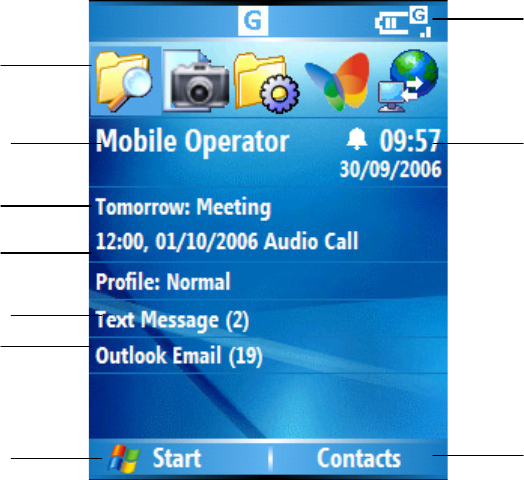
Chapter 1 Knowing your device
1.1 Getting Started
Important information such as current date, time, status indicators, appointments and
profile are displayed on the Home screen. You can open a program directly by selecting
its icon and pressing Enter (the key in the middle of the navigation pad). The Home
screen can be accessed from anywhere by pressing the Home key.
1. Recently-used programs are shown here. Click on an icon to run it again.
2. Your wireless service provider’s name
3. The Date and time
4. Click to access the details of missed calls
5. Display of appointments
6. The current profile
7. Click here to read new messages
8. Click to display all program icons
9. Display the status indicators – these are described in the next section
10. Click to open messages, Contacts or Call History. The function of this button
depends on what events have occurred on the device previously.
1
2
4
5
6
7
8
9
3
10
TBD
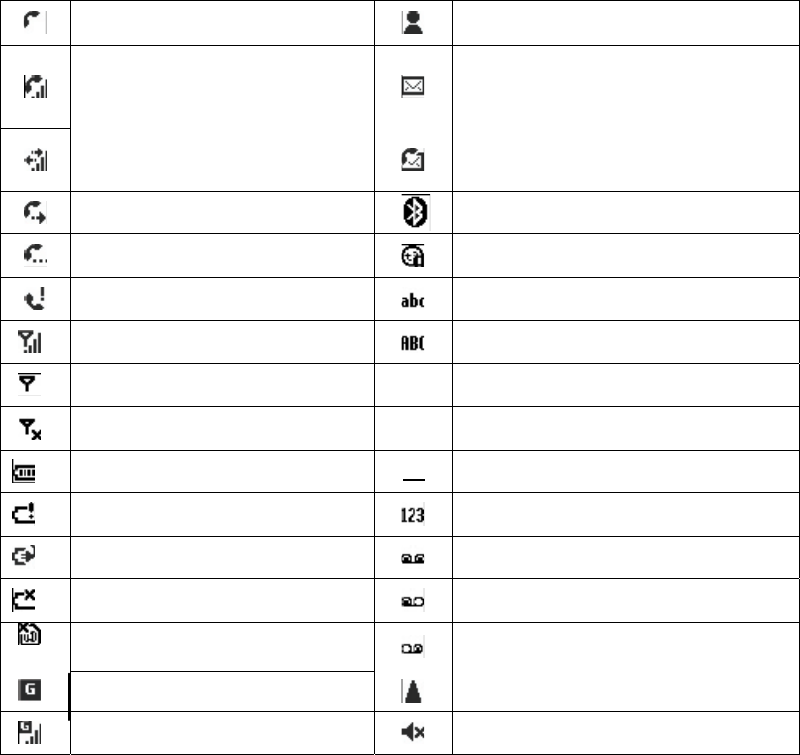
1.2 Status Indicators
You will find the below indicators on your screen.
Voice call New instant message
Voice call in progress
New email or text message
Data call in progress New voice mail
Calls forwarded
Bluetooth is on and/or device
is visible
Call on hold Sync error
Missed call Multi-press text input mode,
lowercase
Signal strength Multi-press text input mode,
uppercase
Radio connected or no
signal T9 T9 text input mode, uppercase
Radio off t9 T9 text input mode, lowercase
Battery level T9 T9 text input mode, caps lock
Very low battery Numeric input mode
Battery charging Voice mail at both lines
No battery or battery fault Voice mail at line 1
No SIM card installed Voice mail at line 2
GPRS available
Roamin
g
GPRS connected Ringer off
1.3 Entering Information
Input methods
The phone has three input methods for text editing: Multi-press, T9, and Numeric mode.
Multi-press and T9 are used for text, and Numeric mode is for numbers entry.

Method indicators
When you move the cursor into a field that requires you to enter text or numbers, it will
auto-select an appropriate input method. The present input method status indicator will
appear in the top right corner of status bar.
abc Multi-press text mode in lower case
Abc Multi-press mode, initial letter is up-
per case and subsequent letters are
lower case
ABC Multi-press text mode in upper case
ABC Multi-press text mode with caps lock
123 Numeric mode
t9 T9 input mode, lowercase
T9 T9 input mode, initial letter upper-
case, subsequent letters are lower
case
T9 T9 input mode with caps lock
Multi-press Mode
In this mode, you select the character you require by tapping a certain number of times
on a key. For example, to type the letter ‘b’, you need to tap the ‘2 ’ key two times. To type
the word ‘box’, you would press:
2, 2-> 6,6,6 -> 9,9
To select another character from the same key as you have just been using, you need to
pause before starting to type again. For example, to type the word ‘cab’ you would type:
2, 2,2 (wait) ->2 (wait) -> 2, 2
You can set the amount of time you need to pause from Start > Settings > Accessibility >
Multi-press Timeout
T9 Mode
To create a word using the T9 mode, you press the numbers that contain the letters to
form the word. For example, to type the word ‘any’:
Tap2 -> 6 -> 9
The word ‘any’ will be displayed. Notice though that other words appear in a window
below ‘any’. These are words that could be created by pressing the keys2 ,6 and 9 in that
sequence.
For example, to type the word ‘box’ you must also type2 ,6,9. Although the word ‘any’ is
shown initially, scroll down the list of words until you reach ‘box’ and then press in on the
joystick to choose that word. After a little practice this method of input can be much
quicker than the conventional multi-press mode.
Note: If the word you wish does not exist, scroll down to the bottom of the list to ‘add

word’ and select that option. Now type the word you wish to insert into the dictionary. The
next time you type that word, it will appear in the suggestions list.
Numeric method
In Numeric method, you can just tap a key in order to enter the corresponding number
into a field. Typically the input mode changes to Numeric for the entry of telephone
numbers in the Phone application, for address entry in the SMS and MMS applications.
To enter numbers in text
1 Press and hold the * to change it to Numeric mode
2 Enter numbers with the keypad
3 Press the * again and hold to back to T9 mode
To enter numbers without changing to ‘123’ mode, press and hold the corresponding
key for 1 second.
More tips on text entry
In both Multipress and T9 mode, the first letter of a sentence/phrase is capitalized.
• To switch among Uppercase, Lowercase and Caps lock
Press * to switch among Uppercase, Lowercase and Caps lock
• Deleting characters
Press Back to delete a single character
Press and hold the Back key to delete all the characters in the area where you are
currently typing.
• Entering space & symbols
In Multipress or T9 mode, press # briefly to enter a space.
Press and hold # to show miscellaneous symbols and characters. Press navigation keys
to move to the required character, and then press the CSK Key to insert it.
• Entering the ‘+’ character for international calls
Press and hold the ‘0’ key in order to gain the ‘+’ symbol while dialing a telephone
number.
Chapter 2 Personalizing your phone
2.1 Home Screen
The Home screen is the screen displayed on the phone when you press the Home key .
Please refer to Chapter-1 for details on status indicators which are displayed in the Home
screen. You are able to customise the Home screen and this is described in the next few
sections below.
There are two categories of file that can be used to create a Home Screen for your
device:
• A picture file on its own
• A prepackaged unit that includes a picture, a colour scheme and a new layout
For the first option you may use a .bmp (Bitmap), a .jpg (JPEG) or a .gif format picture.
For the second option you may find prepackaged files with the extension of .hme or .cab.
The guideline document ‘How to install a cab file on your smartphone’ will guide you
through the installation process.
To copy an image to your phone for use as a Home screen
1. If necessary, please install the ActiveSync software on your PC first which is
available in the accompanying CD (Chapter 6). Connect the phone to your PC using
a USB cable is probably the simplest method.
2. On your PC, copy the image file you want. The file format must be .gif, .jpg, or .bmp.
3. In ActiveSync on your PC, click Explore and double-click My Windows Mobile
device .
4. Do one of the following:
Note: For best results, use images with the same screen resolution for your phone’s
screen resolution, which is 240 x 320 pixels
• Double-click My Documents, double-click the folder My Pictures and paste the image
file into that folder.
• If you plan to use the image as your Home screen background, double-click Application
Data, double-click Home, and paste the image into that folder.
Changing the Home screen appearance
1. On the Home screen, click Start > Settings > Home Screen.
2. Under Home screen layout , Color scheme , and Background image, select the options
you want, and click Done.
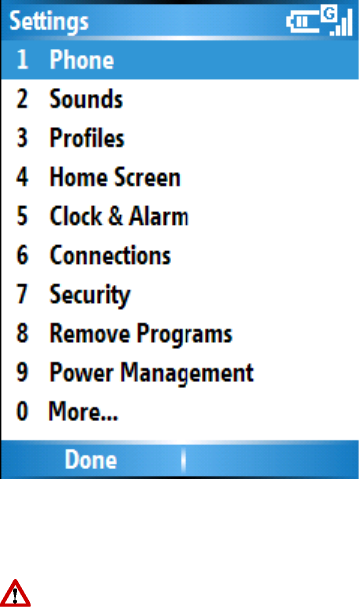
Note: This applies throughout the rest of the document whenever you access any phone
settings which shows numbers listed. Also, you may need to press 0 (More…) if the
setting is hidden in the next page.
Simply press one of the numbers (here it is 4) on the keypad for fast selection of a
menu item or you can use the NAVIGATION button to scroll down the list.
An alternative method to set an image as the Home screen
1. On the Home screen, click Start > Pictures & Videos.
2. Select the picture to set as the background.
3. Click Menu > Use as Home Screen .
4. Use NAVIGATION button to select the portion of the picture you want to use, and click
Next .
5. Under Adjust the transparency , select a higher percentage for a more transparent
picture or a lower percentage for a more opaque picture.
6. Click Finish .
2.2 Ring Tone
A ring tone is a sound made by the phone to indicate an incoming call. This sound can be
different for different persons according to your contacts list. The ring tone is made up
from the sound file. This sound file can also be used for other events such as notification
or reminders when a calendar appointment is due.
Copying a sound to your phone
After a sound file is copied to your phone, you can use it as a ring tone, notification, or

reminder.
1. Connect the phone to your PC using a USB connection (see the chapter on ActiveSync
setup for your PC).
2. On your PC, copy the sound file you want.
3. In ActiveSync on your PC, click Explore and double-click My Windows Mobile device .
Note: For ring tones, the sound files can be in either midi, wma, mp3, mmr or wav file
format. For notifications or reminders, use either midi, wma, mp3, mmr or wav files.
When you select a sound, let the sound plays. To hear it again, select Menu > Play.
4. Do one of the following:
• To save the sound file on your phone, double-click Application Data , double-click
Sounds , and paste the file into that folder.
• To save the sound file on your storage card, double-click Storage Card , and paste the
file into the folder you want.
Specifying the sound for an event
1. On the Home screen, click Start > Settings > Sounds .
2. Under an event, click a sound. The phone plays each sound as you select it. Click
None if you don’t want to hear a sound.
3. Repeat for each event, and click Done .
To change the current profile
The Profile feature defines how your phone notifies you of incoming calls, alarms etc. For
example
Normal – For day-to-day use. Device will ring.
Silent – Device will not ring or vibrate.
Meeting – vibrates as you are in a meeting
1. On the Home screen, click Profile [Type] . Example: Profile Normal .
2. Click a new profile, and click Done.
Note:Some profiles are selected by the device depending how it is being used at the
time. For example, the device will move to ‘Headset’ profile when you plug in a headset
You can also change the profile by using the Quick List. Long-press the Volume Up
key on the side of the phone to select the desired profile.
The Automatic profile has special features. If you choose this profile the phone will act as
if in ‘Normal’ mode. However, if you have set up a calendar appointment, then the phone
will move to ‘meeting’ profile when the appointment takes place.
Customizing a Profile
1. On the Home screen, scroll down the screen then select and click Profile [Type] .
Example: Profile Normal .
2. Select the profile to edit.
3. Click Menu > Edit .

4. Do one of the following:
• Modify the settings, and click Done .
• To cancel without saving changes, click Cancel .
To revert to the default profile settings, click Menu > Reset to default.
2.3 Settings
Although these are not mandatory to use the phone, for optimum use it is advised that
you go through and set them up.
Setting the date and time
1. On the Home screen, click Start > Settings > Clock & Alarm > Date and Time .
2. In Time Zone , select your time zone.
3. In Date , edit the month, day, or year using the navigation button to get to each field.
4. In Time , edit the hour, minute, and second.
5. Click Done .
Note: These settings are lost if you hard reset your phone. Your settings will be
remembered of you power off the device. If the battery is fully discharged, then your
personal settings are also preserved.
To change the format of the date for your region, set this using the ‘Regional
Settings’ menu described later on.
To set the alarm
1. On the Home screen, click Start > Settings > Clock & Alarm > Alarm .
2. In Alarm , choose one of the following:
• Off to turn the alarm off.
• On to turn the alarm on.
3. In Alarm time , enter the time(*) for the alarm to go off.
4. Click Done .
Entering owner information
Entering and displaying owner information may be a good practice to follow; they could
allow someone to return the phone to you in case it is lost.
1. On the Home screen, click Start > Settings > More > Owner Information .
2. Complete the following:
• In Name , enter your name.
• In Telephone, enter a number where you can be reached.
• In E-mail address, enter your e-mail address.
• In Notes, enter any other information you want to include.
3. Click Done .

Changing accessibility settings
1. On the Home screen, click Start > Settings > More > Accessibility .
2. Select your preference for the following:
• System font size to set the size of the font that is displayed on the screen.
• Multipress time out to set the length of time between keypresses when entering text in
Multipress mode.
• Confirmation time out to set the delay before an unconfirmed action times out.
• In-call alert volume to set the volume of sounds that play when you are in a call.
3. Click Done.
Note: The format of the time(*) is dependent on the time format setup in your phone
settings under Regional Settings, i.e. 24-hour format or hh:mm:ss AM or PM
Changing regional settings
You can specify the language, locale, date and time format, as well as number and
currency formatting options.
1. On the Home screen, click Start > Settings > More > Regional Settings .
2. In Language, select your preferred language.
3. In Locale, select the locale for the language you selected. The locale option
automatically changes the format of the remaining options (such as date, time, and
currency) according to the locale you specify.
4. Click Done.
Note: The phone automatically warns you that the phone must be powered off and on
again for the changes to take effect.
Changing power management settings
You can use Power Management to check the battery and configure settings that prolong
battery life.
1. On the Home screen, click Start > Settings > Power Management.
2. Adjust the following:
• In Backlight time out on battery , select the amount of time for the phone to be idle
before the backlight turns off.
• In Backlight time out on AC , select the amount of time for the phone to be idle before
the backlight turns off when using AC power.
• In Display time out , select the number of minutes for the phone to be idle before the
screen turns off.
3. Click Done.
Main battery indicates the amount of battery life remaining.
2.4 Security
It is advisable to place some security in your phone and the SIM card in the event that it is

lost or stolen. However some security features can also be applied to prevent the phone
from unauthorised use. The security which can be applied to the phone is –
• Keypad lock – to prevent the phone from making a call if the device keypad is
accidentally pressed when it is placed in a hangbag or a pocket
• Device lock – prevents unauthorised use of the phone
• SIM PIN enable – prevents unauthorised use of the SIM card in any phone
Enabling your SIM PIN
Be sure to make a note of your personal identification number (PIN). When the SIM PIN
is disabled, you must provide this PIN to enable the SIM. The PIN associated with your
SIM card is provided when you obtained the SIM card originally from your Service
provider.
1. On the Home screen, click Start > Settings > Security > Enable SIM PIN
2. Enter the current PIN and click Done
Disabling your SIM PIN
This option is available only if your SIM PIN has been enabled first.
1. On the Home screen, click Start > Settings > Security > Disable SIM PIN
2. Enter your current PIN, and click Done.
Note: If you fail to enter the correct PIN for your SIM card after 3 attempts, you will need
to contact your Service Provider for the Personal Unblock Key (PUK). Do NOT attempt to
guess the PUK thereafter as it will render your SIM card permanently inoperative after a
10 incorrect PUK attempts.
Changing your SIM PIN
This option is available only if your SIM PIN has been enabled first.
1. On the Home screen, click Start > Settings > Security > Change SIM PIN
2. Enter your current PIN and New PIN including its confirmation
3. Click Done.
Enabling the Keypad lock
Locking the keypad turns off keypad functionality. This is a helpful feature if, for example,
the phone is turned on and in your pocket, and you want to prevent accidental
keypresses.
• On the Home screen, press and hold the Home key.
• Once the keypad is locked, the left soft key label changes to Unlock .
Note: You can still receive and make emergency calls when the keypad is locked.
Press POWER button on the left side of the phone to display the Quick List and click
Key lock.

Unlocking the Keypad
Simply press the Unlock key in the Home screen and the screen prompts you with the
correct key press required to unlock the keypad.
Enabling the Device lock
This complements the SIM PIN feature to provide additional security to your phone. It
means that the phone is protected from unauthorised use.
1. On the Home screen, click Start > Settings > Security > Device Lock .
2. In Lock phone after, select the amount of time for the phone to be inactive before
automatically locking.
3. Enter and confirm your password - simple PIN or Alphanumeric(this can include
punctuation chars)
4. Click Done.
Disabling the Device lock
1. On the Home screen, click Start > Settings > Security. > Device Lock
2. You will be prompted for the password
3. Uncheck the “Prompt if device unused for” field
4. Click Done.
Note: Please make a note of the password. Otherwise, to make use of the phone again
would require the phone to be hard reset and your personal data erased during the
hardware reset!
To lock the phone quickly, press and hold the volume up key to display the Quick List,
select Device lock, and repeat steps 2 – 4 above.
Chapter 3 Using your phone
3.1 Making a call
You can make calls from one of a number of screens in your phone – Home screen,
phone screen, Contacts and SIM contacts (contacts which have been setup in the SIM
card), Speed dial and Call history. These are described in the following pages.
Make a call by entering a phone number
From the Home screen, click either the green Phone button or any key on the numeric
keypad to get a screen button to call that number similar to one of the screenshots below
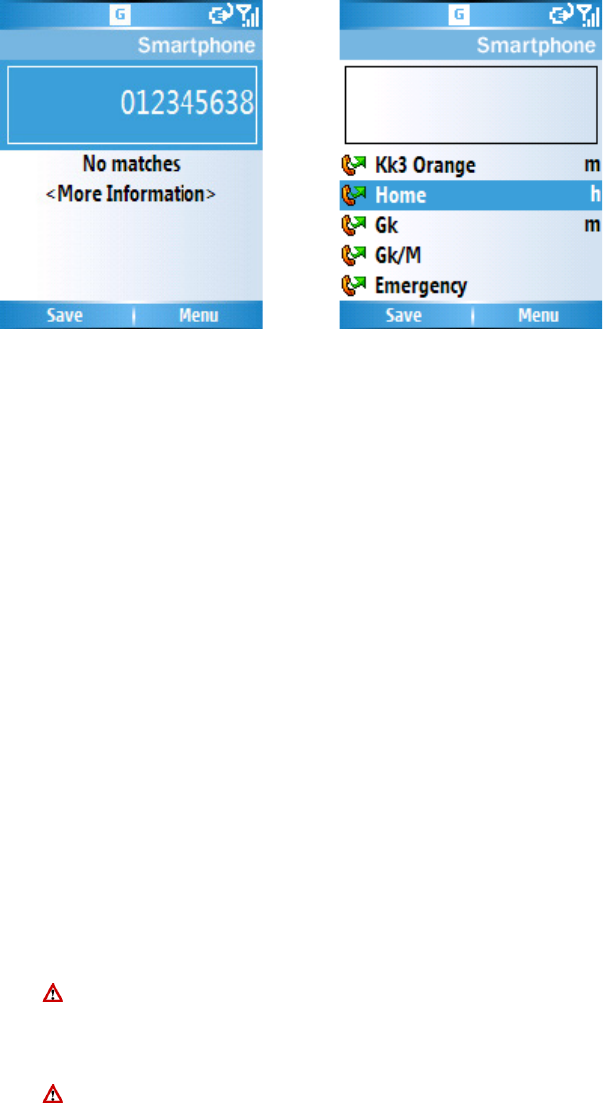
–
Enter the number you wish to call and then press the Phone button to dial
Alternatively, scroll down the list to the item required and press the Phone button to dial.
Make a call by entering a contact name
1. On the Home screen, begin entering the contact name.
2. A list of contacts matching your keystrokes will be displayed. When you see the
contact name, scroll down the list to select it and then either press TALK or Enter
key twice.
Make a call from an open contact
1. On the Home screen, either click Contacts soft key if available or click Start >
Contacts
2. Select and click the contact to call
3. A list of numbers will be shown to select and call with either the Phone or Enter key
Making a call from the contact list
1. On the Home screen, click Start > Contacts .
2. Select the contact, and press TALK.
If you have a long list of contacts, you can use a shortcut to find the contact you
want. Enter the first few letters of the contact’s name. When you do this, the phone
searches through the contact list and displays the name. To call the contact, press
TALK.
Alternatively, you can get your Contacts by pressing the right softkey from the
Home screen.
Note: A contact may be setup with a work phone number (w), mobile phone number (m)
and a home phone number (h). By default, if the contact is dialed from the contact list, the
phone will select the mobile phone number unless you expand this list and scroll down to
the phone number required.
Note: You can change the default number called for each contact. In the Contacts
application, highlight a contact. You may press the left and right navigation keys to
change the number that will be called. The letter on the right of the contact will indicate
the default number being dialed.
Making a call from Call History
Call History displays calls you have made, received, and missed recently.
1. On the Home screen, click Start > Call History .
2. Select the name or phone number to call.
3. Press TALK.
Making a call using a recently dialed phone number
1. On the Home screen, press TALK.
2. Select the name or phone number to call.
3. Press TALK.
Making an emergency call
• Enter the emergency phone number for your location and press TALK.
Note: You can make calls to emergency service numbers under any circumstances, even
if you have enabled the SIM PIN and/or locked the phone.
Dialing the last number called
• On the Home screen, press TALK twice.
Creating a speed dial
A speed dial is a short cut using one or more digits of your numeric keypad to call a
frequently used phone number by pressing that number on the keypad. You can create a
speed dial for a phone number, e-mail address or Web page address that is stored in
Contacts.
1. On the Home screen, click Start > Contacts.
2. Click the contact for whom to create a speed dial.
3. Select the phone number, e-mail address, or Web page address for which to create a
speed dial.
4. Click Menu > Add to Speed Dial.
5. In Keypad assignment, select the speed dial number to use by scrolling thru the
desired speed dial.
6. Click Done.
Note: The digit 0 is reserved to bring up the ‘+’ symbol in international dial strings (the
equivalent of dialing ‘00’ in many countries) when you press and hold ‘0’. The digit 1 is
reserved for calling your voice mailbox as a speed dial option. The Voicemail Speed Dial
is normally pre-configured by the SIM card. If it is not set automatically you need to set
this up by going to Start > Settings > Phone > Call Options > Voice Mail Number. You can
find this number by calling your Service Provider.
Using a speed dial
On the Home screen, press and hold the number on the keypad that you have assigned
as a speed dial for the phone number, e-mail address, or Web page. If the speed dial is
two digits, press the first digit, then press and hold the second digit. The phone dials the
phone number, opens a new e-mail message, or goes to the Web page.
Viewing and editing a speed dial
1. On the Home screen, click Start > More > More > Speed Dial.
2. Select the speed dial and click Edit.
3. Make any changes and click Done.
Deleting a speed dial
1. On the Home screen, click Start > More > More > Speed Dial.
2. Select the speed dial to delete.
3. Click Menu > Delete.
3.2 Receiving a call
Answering a call by pressing any key
Normally, the green Phone button is the default button to answer an incoming call. To
override this and use any button to answer instead –
1. On the Home screen, click Start > Settings.
2. Click Phone > Call Options.
3. Select Any key answer until there is a tick in its box and click Done.
Answering or ignoring a call
• To answer the call, press TALK or click Answer .
• To reject the call, press END or click Ignore .
Note: Selecting END or Ignore will connect the caller to your voice mail if you have
subscribed to this service.
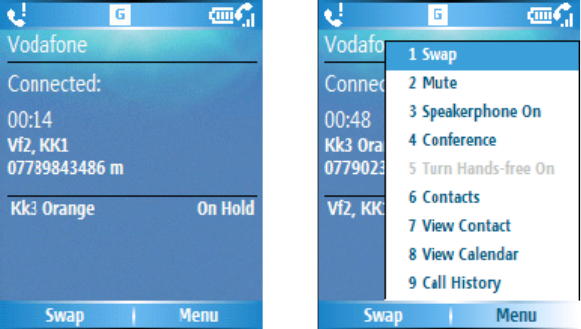
3.3 In-Call Options
Answering or postponing a second call
For this to work, you will first need to enable the call waiting option from your Home
screen by clicking Start > Setting > Phone > Provide Call Waiting notifications. After this
option this has been enabled on your phone and the settings have been sent
automatically by your phone and accepted by your Service Provider, you will receive an
audible and visual notification on your phone if another call comes in during your current
call.
• To put the first call on hold and answer the second call, press TALK or click Answer .
To switch between calls, click Swap.
• To avoid answering the call, click Ignore. Either the 2nd call is disconnected or it is
diverted to voice mail if you have subscribed to this service.
Making a second call while already in a call
It is possible to make a second call while you are already in a call. To do this, press Menu
> Hold to place the first call on hold. Then dial the second number and press the TALK
key.
Your first call will remain on hold. You may swap between the two calls by pressing the
TALK key or press Menu > Swap.
To join two or more calls together in a conference
You may join two or more calls together in order to make a conference call. To do this,
make sure you have two calls on your phone – one should be active and the other should
be on hold. Then select Menu > Conference. The two calls will be joined together and
each party will be able to hear the other.
You may now add another party to the conference by dialing another user and again
choosing Menu > Conference.
If you wish to have a private conversation with one of the callers, you may split the
conference call back up into its individual users. With the conference running choose
Menu > Private. Then select the caller with whom you wish to have the private
conversation.
Note: The conference feature is dependent on your Network Provider supporting it.
Please check to ensure you can use this function
To put a call on speakerphone
Your phone may also be used in Speakerphone mode which means that the caller’s voice
will be played back over the loudspeaker instead of the earpiece.
You must be in a call to enable the speakerphone. To enable, press Menu >
Speakerphone On or press and hold the green Call key for 2 seconds.
To switch off Speakerphone, select Menu > Speakerphone Off or press and hold the
green Call key for 2 seconds.
Note: Your next call will not be in Speakerphone mode automatically, even if you left the
function switched on in the previous call.
3.4 Special Dialing requirements
Insert a manual pause in a dialing sequence
Calls to certain networks may require a pause in between the dialed digits. To do this,
1. On the Home screen, click Start > Contacts.
2. Click the contact in whose phone number you want to insert a pause.
3. Select the phone number and click Menu > Edit.
4. Place the cursor where you want to insert the pause.
5. Click Menu > Insert Wait. The letter w appears where the manual pause will occur in
the dialing sequence.
6. Click Done.
Note: To resume dialing after reaching a manual pause, press TALK
Insert a three-second pause in a dialing sequence
1. On the Home screen, click Start > Contacts.
2. Click the contact in whose phone number you want to insert a pause.
3. Select the phone number and click Menu > Edit.
4. Place the cursor where you want to insert the pause.
5. Click Menu > Insert Pause. The letter p appears where the three- second pause will
occur in the dialing sequence.
6. Click Done.
Insert an international country code
To make an international call you must include a country code at the beginning of the
dialing sequence for the phone number.
• Enter the country code, press and hold 0 until a plus (+) sign appears, and then enter
the rest of the phone number.
Note: You can insert a plus (+) sign into a contact’s phone number or dial it directly from
the keypad.
3.5 Video Telephony
You can make video calls to your contacts. Detail descriptions are in the following
pages.
Making a video call
1. On the Home screen, press Talk key.
2. Input phone number in dial pad screen
3. Click Menu > Video call. Video call will be made immediately.
Answering a video call by pressing any key
Normally, the green Phone button is the default button to answer an incoming call. To
override this and use any button to answer instead –
1. On the Home screen, click Start > Settings.
2. Click Phone > Call Options.
3. Select Any key answer until there is a tick in its box and click Done.
Answering or ignoring a video call
• To answer the call, press TALK or click Answer .
• To reject the call, press END or click Ignore .
Chapter 4 Getting connected
Your device is built for connectivity. This chapter will guide you this set up.
4.1 Automatic setup of your data connections
Your device is able to configure itself for data services for many of the major operators
across the world. Simply insert your SIM card and switch on your device. When the
device powers on, it will configure itself or Web, WAP and MMS services. If the settings
are not known for your operator, the device will notify you and you will need to enter these
manually.
Note: The use of Web and WAP access and Multimedia Messaging Service is subject to
your Mobile Service Provider. You must ensure that your subscription has Web , WAP
and MMS enabled before using these services.
4.2 Manual setup of your data connections
Introduction
You may connect to the internet in using your mobile service provider’ s data network.
The mobile operator may offer you service through a GPRS connection (fast, but
generally billed by volume of data transferred), or through a Circuit Switched (slow,
generally billed by amount of time connected). You should check with your mobile service
provider how you may access the internet using their network.
Create a GPRS connection
GPRS is a packet-based wireless communication service which allows users to send and
receive data with their mobile phones in applications such as Email and web-browsing.
Normally, use of this service is charged by the Service Provider based on the data traffic
volume.
Every network connection is different. You should gather all of the relevant information or
network settings you need from your Mobile Service Provider before starting this process.
1. On the Home screen, click Start > Settings > Connections.
2. Click GPRS.
3. Click Menu > Add.
4. Enter the following information, and click Done.
• In Description , enter a name for the connection.
• In Connects to , select the type of network to which you will connect.
• In Access point , enter the access point name.
• In User name , enter your user name for the GPRS network, if required.
• In Password , enter your password, if required.
• In Primary DNS , enter the primary Domain Name System (DNS) address, if required.
• In Secondary DNS , enter the secondary DNS address, if required.
• In IP address , enter the Internet Protocol (IP) address for the device, if required.
The device uses this connection when you open a program that connects to the Internet.
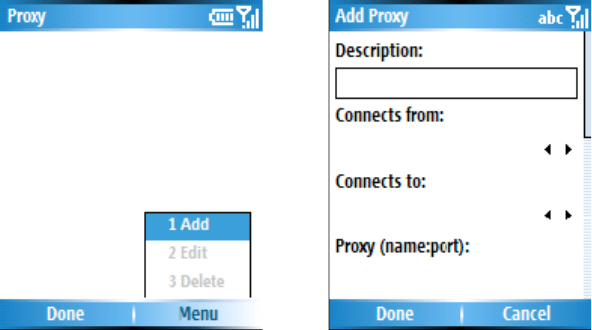
Create a dial-up connection
Every network connection is different. You should gather all of the relevant information or
network settings you need before starting this process.
1. On the Home screen, click Start > Settings > Connections.
2. Click Dial-up .
3. Click Menu > Add.
4. Enter the following information, and click Done.
• In Description , enter a name for the connection.
• In Connects to , select the network.
• In Phone number , enter the phone number to be used to dial the network.
• In User name , enter your network user name, if required.
• In Password , enter your password, if required.
• In Domain , enter the domain name, if required.
Create a proxy connection
Dependent on your Mobile Service Provider’s configuration, you may need to add a proxy
connection to allow your phone to access the internet or WAP services. Every network
connection is different and your service provider will be able to advise if there is a
requirement for this. You should gather all of the relevant information or network settings
you need before starting this process.
1. On the Home screen, click Start > Settings > Connections.
2. Click Proxy .
3. Click Menu > Add.
4. Enter the following information, and click Done.
• In Description , enter a name for the connection.
• In Connects from , select the type of network from which you will connect.
• In Connects to , select the type of network to which you will connect.
• In Proxy [name:port] enter the proxy server name and port number in this form: server
name:port number.
• In Type , select the type of proxy connection to create.
• In User name , enter your user name for the network to which you will connect.
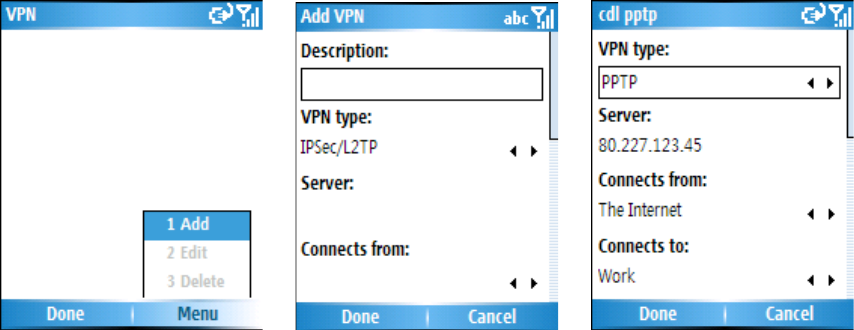
• In Password , enter your password.
Create a VPN connection
Please ensure that you have setup a successful GPRS connection first – the VPN
connection uses the GPRS connection for connection to your Work network. You should
gather all of the relevant information or network settings you need before starting this
process. For the VPN to work, please refer to the next section – Connect to intranet URL
also.
1. On the Home screen, click Start > Settings > Connections
2. Click VPN.
3. Click Menu > Add.
4. Enter the following information
• In Description , enter a name for the connection.
• In VPN type , select the type of VPN.
• In Server , enter the VPN server name.
• In Connects from , select the type of network from which you will connect to the VPN
(typically The Internet ).
• In Connects to , select the type of network to which you will connect (typically My
Work Network ).
• In User name , enter your user name for the VPN.
• In Password , enter your password.
• In Domain , enter the domain name, if required.
• If you selected IPSec in VPN type , in IPSec authentication , select the type of
authentication: Pre-Shared Key or Certificate .
• If you selected Pre-Shared Key in IPSec authentication , in IPSec Pre-shared key ,
enter the key.
• Click Done.
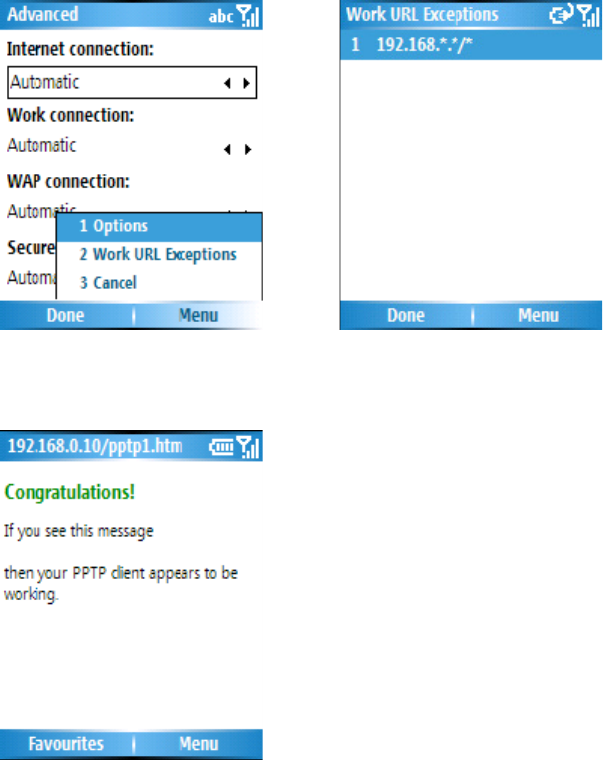
Connect to intranet URLs
Some companies use periods in their intranet URLs (for example, intranet.
companyname.com). A Work URL exception tells Internet Explorer Mobile and/or
Activesync to look on the Work network to find the URL instead of searching the Internet.
This has to be setup also if you wish to browse web sites in your intranet through your
VPN connection.
1. On the Home screen, click Start > Settings > Connections.
2. Click Menu > Advanced > Menu > Work URL Exceptions.
3. Click Menu > Add.
4. In URL Pattern, enter the URL, and click Done. Separate multiple URLs with a
semicolon (;).
Note: You should not create URL exceptions for URLs on the Internet. Above is an
example of an intranet URL which has been successfully. An intranet URL can be either
IP addresses in your work intranet or a FQDN (Fully Qualified Domain Name).
Use a specific connection to connect to the chosen networks
In order for the device to connect to the right access point for a particular type of data
transfer, you must define which connection connects to which network
1. On the Home screen, click Start > Settings > Connections.
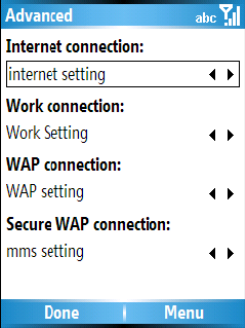
2. Click Menu > Advanced.
3. In Internet connection, select the connection you want to use for general Web access,
and click Done.
4. Similarly, select the connection you wish to use for the WAP network
5. The Work Network connection is used if you are planning to use a Virtual Private
Network connection.
4.3 Bluetooth
Bluetooth is a short-range radio frequency technology that connects devices together for
transmitting voice and data. The range is usually up to 10 metres, and typical applications
are for connecting your phone to Bluetooth wireless headphones and Bluetooth Global
Positioning System (GPS) units.
Bluetooth works by creating a pairing between two devices. This pairing is known as a
‘partnership’. This partnership exists if the devices are moved out of range of each other
or even if the devices are switched off. When the devices are switched back on or are
moved into range, they will be connected with each other without needing to bond them
again.
Bluetooth has 3 modes: Off, On and Visible. When the Bluetooth is Off, there is no power
to the Bluetooth radio and so it does not function. When Bluetooth is set to On, your
device will be connected to the devices it is already bonded with, but new devices will not
be able to find your device. In Visible mode your device will act as the On state, but it will
be also found by other devices and you will also be able to receive information being
beamed to it.
Turn Bluetooth On and Off
By default Bluetooth is turned off. If you turn it on, and then turn off your device, Bluetooth
also turns off. When you turn on your devide again, Bluetooth turns on automatically.
1. On the Home screen, click Start > Settings > Connections > Bluetooth.
2. Tick the box for ‘Turn on Bluetooth’ to activate it. Untick this box to deactivate.

3. If you wish to allow this device to be seen by other Bluetooth devices nearby, tick the
box for ‘Make this device Visible to other devices’.
Note: You can also turn Bluetooth on and off using the Wireless Manager described later
in this manual.
To create a Bluetooth partnership from your device to another
device
This method can be used to connect a Bluetooth headset to your device.
Ensure that the two devices are within close range, your device has Bluetooth turned On
and that the device you wish to connect to is in Discoveralble mode.
1. On the Home screen, click Start > Settings > Connections > Bluetooth.
2. Click Menu > Devices > Menu > Add new device. Your device searches for other
Bluetooth-enabled devices and displays them in the list.
3. Select the device with which you want to create a Bluetooth partnership, and click Add.
4. In Passcode, if you want to use a passcode (recommended for enhanced security),
enter an alphanumeric passcode between 1 and 16 characters, and click Done .
Otherwise, leave the passcode blank, and click Done.
5. Enter the same passcode on the other partner device and respond to any prompts from
it also.
To make your device visible to other Bluetooth users
Go to Menu > Bluetooth options. This will take you to the Bluetooth screen described in
chapter 4.3
Note: You can have more than one concurrent Bluetooth partnerships.
For situations where you wish to share the services of your own phone for another device
(for example Internet Sharing), you should follow the guidance in ‘Accepting a Bluetooth
Partnership’.
Once you create a partnership, the Bluetooth-enabled devices do not need to be
set to Discoverable to beam information between them; Bluetooth only needs to be
turned on.
End a Bluetooth partnership
1. On the Home screen, click Start > Settings > Connections > Bluetooth .
2. Click Menu > Devices.
3. Select the Bluetooth partnership you want to end.
4. Click Menu > Delete.
Make your device visible to other Bluetooth devices
Your device must be set to visible:
• To receive beamed information
• To allow beaming devices or computers to detect your device.
• For your device to offer services to other devices (such as Internet Sharing)
1. On the Home screen, click Start > Settings.
2. Click Connections > Bluetooth.
3. Select Make this device visible to other devices in the Bluetooth screen.
Other Bluetooth-enabled devices can now detect your device and attempt to beam
information to it, establish a Bluetooth partnership, or use a Bluetooth service.
Accept a Bluetooth partnership
1. Ensure that Bluetooth is turned on and that your device is visible.
2. When prompted to accept a Bluetooth partnership with the other devices, click
Yes .
3. In Passcode, if you want to use a passcode (recommended for enhanced
security), enter an alphanumeric passcode between 1 and 16 characters, and click
Done. You must enter the same passcode that was entered on the device requesting
the Bluetooth partnership.
The Bluetooth partnership is created. You can now exchange information with the
other devices the other device.
Overview of Bluetooth virtual COM ports
Some programs can connect only through a serial (COM) port. This can be true even
if the device itself is Bluetooth-enabled. To make it possible for such programs to use
a Bluetooth connection, you must set up a virtual COM port. Once created, this
virtual port can be used like any other COM port. You can use a virtual COM port for
programs that, for example, connect to a GPS receiver, or to connect to a
Bluetooth-enabled printer.
Set up an incoming Bluetooth COM port
1. Make sure that your device is currently connected to the other device via
Bluetooth.
2. On the Home screen, click Start > Settings > Connections > Bluetooth.
3. Click Bluetooth > Menu > COM Ports .
4. Click Menu > New Incoming Port.
5. Select a numbered COM port from the list.
6. To use this COM port to communicate only with devices with which your device
has a Bluetooth partnership, select the Secure Connection check box.
7. Click Done.
Set up an outgoing Bluetooth COM port
The New Outgoing Port menu command is available only if one or more
Bluetooth-connected devices support serial (COM) connections.
1. Make sure that your device is currently connected to the other devices via
Bluetooth.
2. On the Home screen, click Start > Settings > Connections > Bluetooth.
3. Click Bluetooth > Menu > COM Ports.
4. Click Menu > New Outgoing Port .
5. Select a numbered COM port from the list. If the port cannot be created, it is on
use. Select a different numbered port.
6. To use this COM port to communicate only with devices with which your device
has a Bluetooth partnership, select the Secure Connection check box.
7. Click Done.
4.4 Beams
The term Beam is used to describe the short range transferring of information between
two units. Beaming only refers to passing information via Bluetooth. An example of
beaming could be you wishing to send the details of a contact to another Windows Mobile
device.
To Beam an item
In the Calendar, Contacts, Notes, Tasks, and Pictures & Videos programs, you can beam
files and information to other devices using Bluetooth.
1. From the program, select the item you want to beam, such as an appointment in
Calendar, a task in Tasks, a contact in Contacts, or a picture in Pictures & Videos. In
Calendar, first open the appointment in Agenda view. Click Menu > Beam Appointment.
2. In the contacts application, you should go to Menu > Send Contact > Beam
Do one of the following:
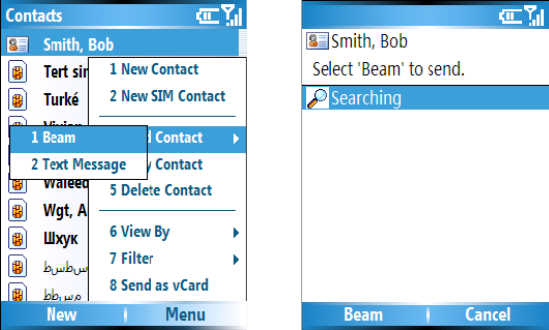
• If using Bluetooth, select the device to which you want to send the item.
3. Click beam.
Receive beamed information
Your device is set by default not to receive beamed information. This is for the security of
your device. In order to accept data you must make the one- off menu selection below.
Configuring your device to receive beamed information
1. On the Home screen, click Start > Settings.
2. Click Connections > Beam.
3. Select Receive incoming beams.
To receive beamed information
1. Do as the following:
Bluetooth is set with a tick against the option 'Make this device visible to other devices'
and is within close range.
2. You will be notified when data is being received on your device.
3. Once the information has finished being transferred, you will be asked whether you
wish to store the item. Click Yes to keep it, or No to discard.
Chapter 5 Messaging
This chapter describes how you can create or delete, send or receive, and organise or
store your messages in the phone –
• Text message (Text message) – you need not setup an account for this if your phone
has a valid SIM card unlike the other accounts below,
• Outlook Email

• Multimedia message (MMS)
A guide to the messaging application Messenger is also given – which allows online chat
over-the-air and access to your Hotmail account.
5.1 Text message
Text Message (also known as SMS) is a popular way of sending short messages to other
mobile phone users, and in some countries to land lines as well. Each text message is a
maximum of 160 characters long. In some countries the maximum size is 70 characters if
accented or other special characters are used. Several text messages can be joined
together to make one message, and your device will do this automatically.
Create a text message
1. On the Home screen, click Start > Messaging > Text message.
2. Click New .
3. In the To: field, enter the mobile phone number of recipients. Insert a semicolon (;)
between multiple recipients. You may also choose a contact by pressing Menu > Add
Recipient
4. Click Send. The Text messages is sent immediately.
In the To: field, you can enter phone numbers from your contact list quickly. Press
ENTER when the cursor is in this field. A new screen displays the contact list for your
selection. Press ENTER again for the selection and the phone returns to the text
message screen. Repeat this for as many contacts as you wish to send the Text
message to.
To cancel a message, click Menu > Cancel Message.
If you request Delivery notification, in the message creation screen , click Menu and
select Message Options to enable this.
Insert predefined text into message
To save time when entering text, you can insert predefined text into messages.
1. On the Home screen, click Start > Messaging > Text message
2. Click New.
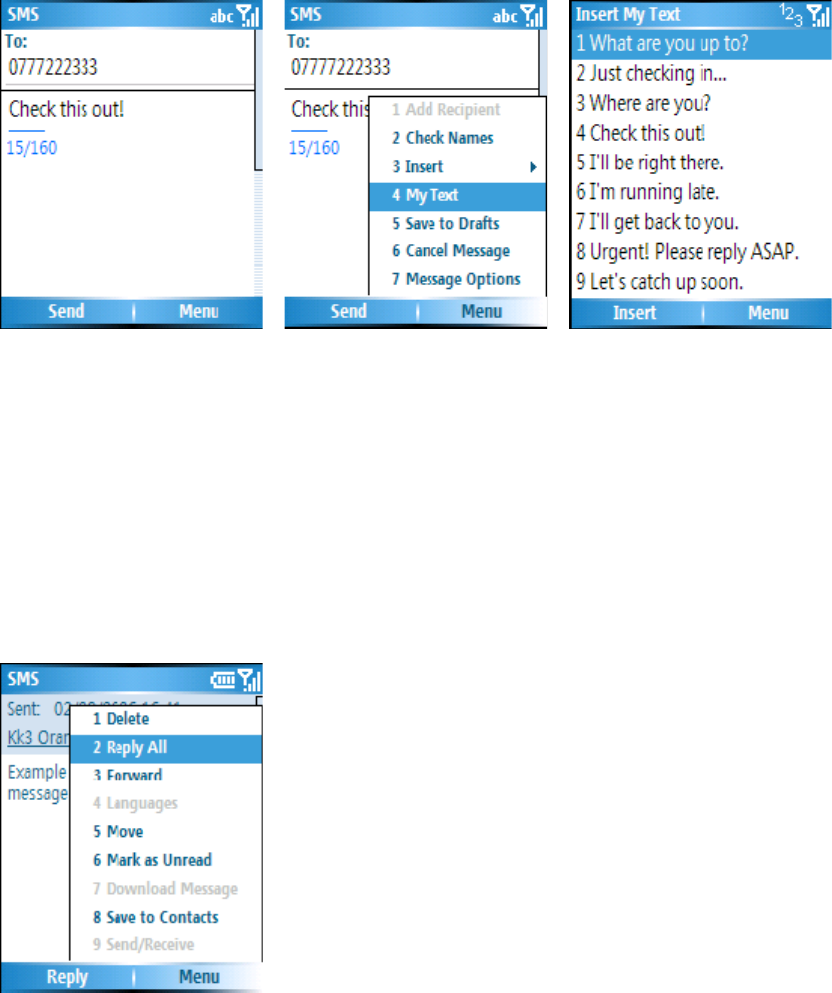
3. Click Menu > My Text .
4. Select the text you want to insert by keying the number corresponding to that in the list
above
Reply to a message
1. From an open message, click Reply on (bottom left corner) or Menu > Reply All
(bottom right corner)
2. Enter messages in the message area.
3. Click Send .
Forward a message
1. From an open message, click Menu > Forward.
. Enter a message in the message area.
3. Choose a recipient to send the message to; either type in the name or click Menu >
Add recipient
4. Click Send.

Delete a message
1. On the Home screen, click Start > Messaging and select an account.
2. Select the message to delete.
3. Click Menu > Delete.
5.2 Email
Before you can send or receive emails, you will need to setup an email account. There
are different types of email accounts supported by the phone. These are described in the
next few pages.
• Internet email account (POP3/IMAP)
• Exchange Server (Outlook)
Set up an Internet email account automatically
1. On the Home screen, click Start > Messaging.
2. Select New Account...
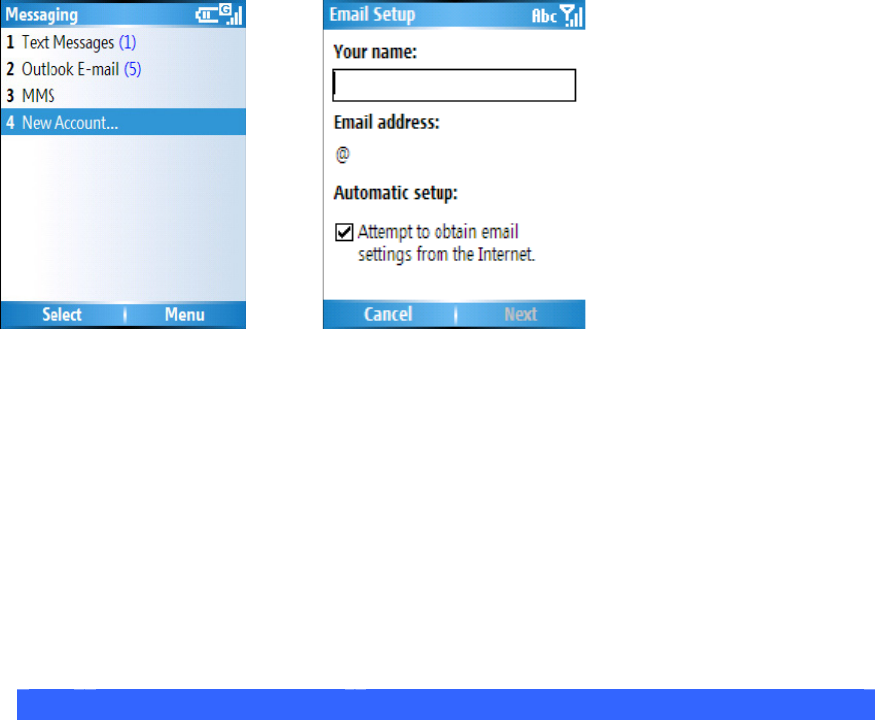
3. On the next screen choose the option Your Email provider: Other (POP3/IMAP)
4. In Your name, enter your display name for e-mail messages.
Note: If the account is set up successfully, you will be prompted to send and receive
e-mail. If not, you must click Next and set up the account manually which is described in
the following pages.
5. In E-mail address, enter the e-mail address for this account.
6. Select Attempt to obtain Email settings from the Internet and click Next.
Set up an Internet email account manually
No. SETTING DESCRIPTION
1
User name
Usually the first part of your e-mail address, which appears
before at the sign (@).
2
Password
Choose a strong password. You will have the option to
save your password, so that you do not need to enter it
each time you connect to your e-mail server.
3
Domain
The domain name. This may or may not be required by
your Internet Service Provider.
4
Server type
The type of e-mail server that hosts your mailbox (POP3
or IMAP).
5
Account name
A name for this account. You must use a different name for
each account that you set up.
6
Network
The type of network your e-mail server connects to.
7
Incoming mail
server
The name of your incoming Email server (POP3 or IMAP4).
8
Require SSL
connection
Select this to ensure you always receive e-mail for this ac-
count using an SSL connection. This enables you to
receive personal information more securely. Please note
that if you select this and your ISP does not support an SSL
connection, you will not be able to connect to receive
e-mail.
9
Outgoing mail
server
The name of your outgoing e-mail server (SMTP).
10
Outgoing server
requires au-
thentication
Your outgoing e-mail server (SMTP) may require
authentication. Note: Your user name and password from
above will be used.
11
Outgoing server
settings
Your outgoing e-mail server may require different
authentication settings than your incoming e-mail server.
12
Use different user
name for outgoing
server
A check box that lets you enter separate settings for your
outgoing e-mail server.
13
User name
Your user name for the outgoing e-mail server.
.
14
Password
Your password for the outgoing e-mail server.
15
Domain
The domain name of the outgoing e-mail server.
16
Require SSL
connection
(Outgoing mail
server only)
A connection that enables you to send personal information
more securely. Prompt that if you select this and your ISP
does not support an SSL connection, you will not be able to
send e-mail.
Before you set up your Internet e-mail account, ensure that you have the necessary
information as listed in the table above. Usually, the manual setup is needed if the
automatic setup failed as described in the previous section.
Now you’re ready to set up your account
1. On the Home screen, click Start > Messaging, and select an account.
2. Click Menu > Options > New Account. Select Other(POP3/IMAP),click Next
3. In Your name , enter your display name for e-mail messages.
4. In E-mail address, enter the e-mail address for this account.
5. Click Next.
6. Enter the information above as appropriate until setup is complete, and click Finish.
Caution
If you save your password and then lose your phone, someone finding your phone might
be able to gain access to your e-mail.
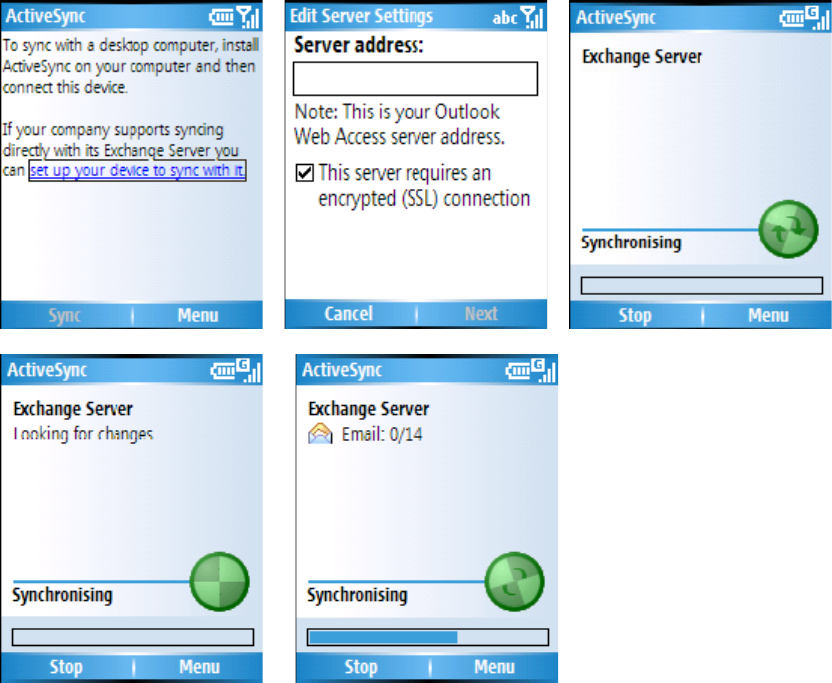
Set up an Outlook e-mail account
An Outlook e-mail account is created and managed by Microsoft’s Exchange Server. You
will need to have this account setup first before carrying on with the other steps described
in this section.
For sending and receiving messages with your Exchange Server, click Start >
ActiveSync
You will get this prompt on your phone if your Exchange Server is qualified to install the
feature called MSFP – Microsoft Messaging and Security Feature Pack. For example,
Exchange Server 2003 with SP2 has the option to install this. One of the benefits is the
ability for the Server to push new e-mails as they arrive to the Outlook client in the phone.
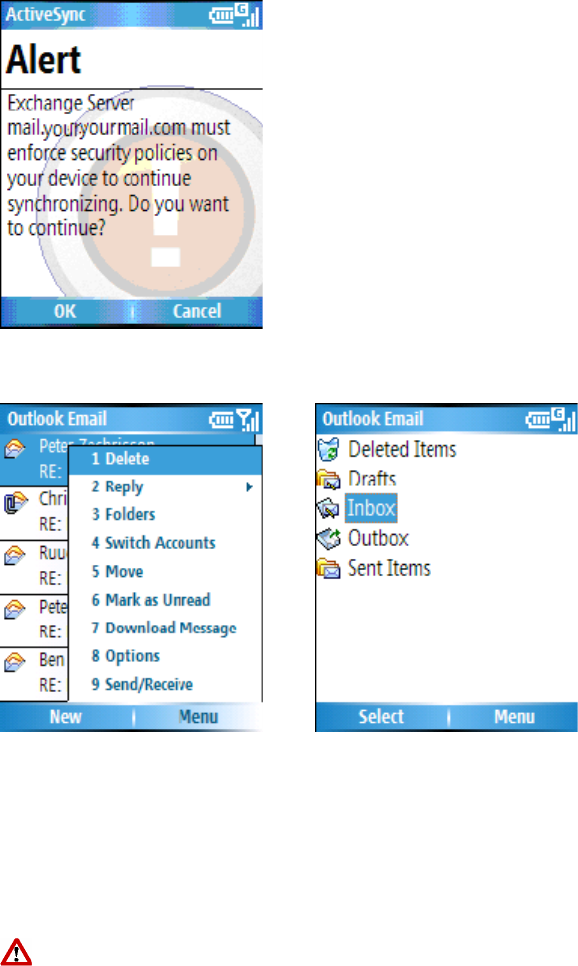
Once the ActiveSync completes successfully, click Start > Messaging > Outlook Email
> Menu > Folders and you should see e-mail folders similar to the Outlook client in a PC.
View the Inbox message list
On the Home screen, click Start > Messaging, and select an account. The Inbox
message list displays your received messages.
To quickly view new messages, click the message notification area on the Home
screen.
Create an e-mail message
1. On the Home screen, click Start > Messaging .
2. Select an e-mail account.
3. Click New.
4. In To, Cc , and/or Bcc field, enter recipient’s e-mail addresses. Insert a semicolon (;)
between multiple addresses.
5. In Subject field, enter a subject.
6. Enter a message.
TBD

7. Click Send. E-mail messages are stored in Outbox and are sent to recipients the next
time you synchronize or connect to your e-mail server and send and receive mail.
You can quickly enter e-mail addresses from your contact list. In the To field, press
ENTER and select a recipient from the list. Then, select the recipient’s e-mail address.
The semicolon separator is automatically inserted if you enter multiple recipients.
To set the priority of the mail (i.e. to appear as a Low, Normal or High priority in the
recipient’s inbox), click Menu > Message Options.
To cancel a message ,click Menu > Cancel Message.
Insert predefined text into message
As described in Section 5.1 Text Message, please refer to the section for details for how
to use this facility. You can use it when creating a new message or replying to an e-mail.
When the message screen appears, click Menu > My Text
Create and add a signature to message
For each account in Messaging, you can specify a signature to be automatically inserted
into messages that you send.
1. On the Home screen, click Start > Messaging and select an account.
2. Click Menu > Options > Signatures.
3. Scroll to the account for which you are creating the signature.
4. Select Use signature with this account.
5. To insert a signature in every message you send, select Include when replying and
forwarding . Otherwise, a signature is inserted only in new messages.
6. Click the Signature box, enter your signature, and click Done.
Reply to a message
1. From an open message, click either the softkey Reply or Menu > Reply All
2. Enter a message in the message area.
3. Click Send.
If you are replying to an e-mail in the Outlook E-mail account, you will send less data if
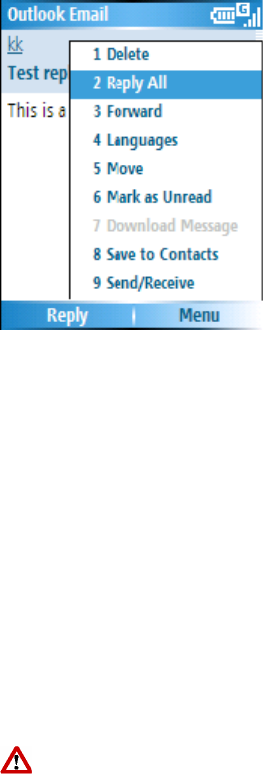
you do not edit the original message. This may reduce data transfer costs based on your
rate plan.
Send and receive Internet e-mail messages
1. On the Home screen, click Start > Messaging.
2. Select the Internet e-mail account for which you want to send and receive messages.
3. Click Menu > Send/Receive. The phone connects to your Internet e-mail server and
sends and receives your messages.
Download a complete e-mail message
1. On the Home screen, click Start > Messaging and select an account.
2. Select the message to download.
To stop this process, click Menu > Stop Send/Receive.
If your Exchange Server is qualified to install the feature call MSFP - Microsoft Messaging
and Security Feature Pack, one of the benefits is the ability for the Server to push new
e-mail as they arrive to your phone, for example, exchange Server 2003 with SP2 has the
option to install this feature.
3. Click Menu > Download Message . The complete message is retrieved the next time
you synchronize or connect to your e-mail server to send and receive e-mail.
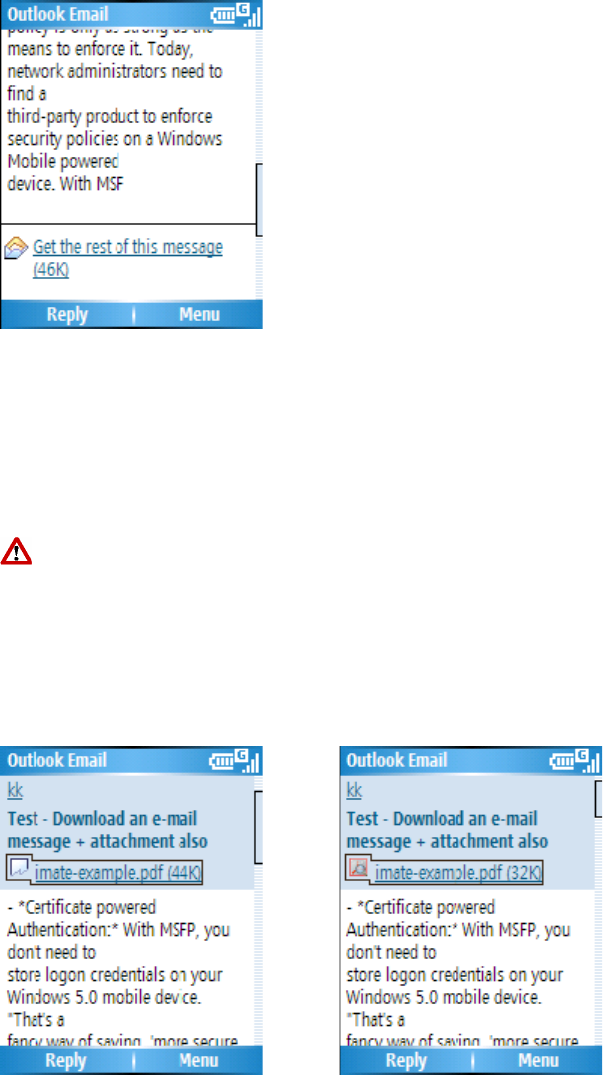
Download an attachment
In an open message with an attachment to download, click the attachment. The
attachment is downloaded the next time you synchronize or connect to your e-mail server
and send and receive e-mail.
Alternatively, you can scroll down to the bottom of the message and click “Get the
rest of this message”. The message will be downloaded the next time your phone
connects to the Server to send/receive e-mail. The frequency of this is determined by the
Schedule setup during your ActiveSync configuration described in Chapter-6.
After you scroll down to the filename shown, click again and the attachment file will be
downloaded when your phone connects to your server to send/receive e-mails again.
Once the file has been downloaded into your phone, the screen will look as shown.
View an attachment
In an open message containing a downloaded attachment, click the attachment.
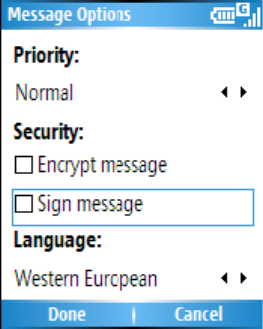
Add a picture to an e-mail message
1. In the message area of an e-mail message, click Menu > Insert > Picture.
2. Click the picture you want to add.
Note: If there are multiple attachments in the message, all attachments are downloaded.
You can view attachments only for file types that are supported by the phone.
Digitally Sign a message
Digitally signing a message applies your certificate with the public key to the message.
This proves to the recipient that the message is from you and not from an imposter, and
that the message has not been altered.
1. In the message list, click Menu > Switch Accounts > Outlook Email.
2. Click New .
3. Click Menu > Message Options.
4. Select Sign message and click Done.
Change between e-mail folders and accounts
1. Click Start > Messaging > Outlook Email
2. Click Folders
3. You can select the new folder you wish to view
Note: S/MIME encryption and digital signatures for Windows Mobile-based devices are
available only with Exchange Server 2003 Service Pack 2 or a later version that supports
S/MIME. If you aren’t using one of these products, or have not yet synchronized, these
options are unavailable.
5.3 MMS
MMS is a way of sending messages that include picture sound and text. You can send
MMS messages to other mobile telephones or to email addresses.
Note: MMS is subject to your mobile operator supporting the service, and your account
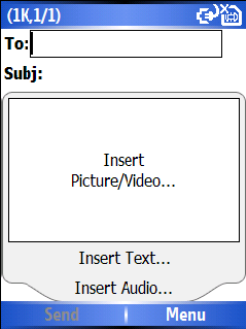
being enabled for the service.
An MMS can be made of many pages, also known as ‘slides’. Each slide can hold an
image, a sound and text, but you do not need to set all of these for each message. The
maximum amount of content that can be sent in a message is set by your service
provider.
Running the MMS program
To start the MMS program from the Home Screen, press Start > Messaging and choose
the MMS option.
Creating and sending MMS
On the MMS main screen, press ‘ New’ to create a new MMS. You will be presented with
the screen below:
Add a recipient
You should add a recipient to your message. You can directly enter a phone number into
the ‘To’ field, or you may select a contact from your contact list. To choose a contact
select Menu > Recipients > Add. The MMS composer is able to deliver the message to
more than one user, just input a semicolon ‘;’ between recipients.
Adding a Picture or Video
To add an image to the message, highlight the ‘Insert Picture/Video…’ area and press
Enter, you will be presented with the preview of all pictures and videos in the current folder
. You may select one of these pictures, or you can choose Menu > Capture > Picture or
Menu > Capture > Video to launch the camera application.
Once you have selected the image, you will be returned to the main message.
Note: If you add a video to the message, then you cannot add any further audio to this
slide.
Adding text to the message
Click on the ‘Insert Text…’ area and enter the message you wish to send. You can also
choose from some predefined text if you wish to use this by clicking on Menu > Insert
Media > My Text while you are in this box.
Template
Click on Menu > Template you could choose a template to use or create a new one
yourself.
Selecting a message background colour
The background colour of the message may be set by choosing Menu > Option >
Background. A list of colours will be displayed for you to choose.
Additional items
Just as email, you may add people in copy (cc) or blind copy (bcc) to your message. You
may also set the urgency of the message, a delivery time delay for the sending of the
message, an expiry time for the message, and request delivery and read report.
To set these requirements, go to Menu > Options > Send Options and set all these op-
tions as required
Receiving MMS messages
The device will alert you when a new MMS arrives. Depending on your settings, the MMS
contents may download a few moments later and will be ready to view in your MMS
Inbox.
The MMS inbox works in an identical way to email and text message inboxes.
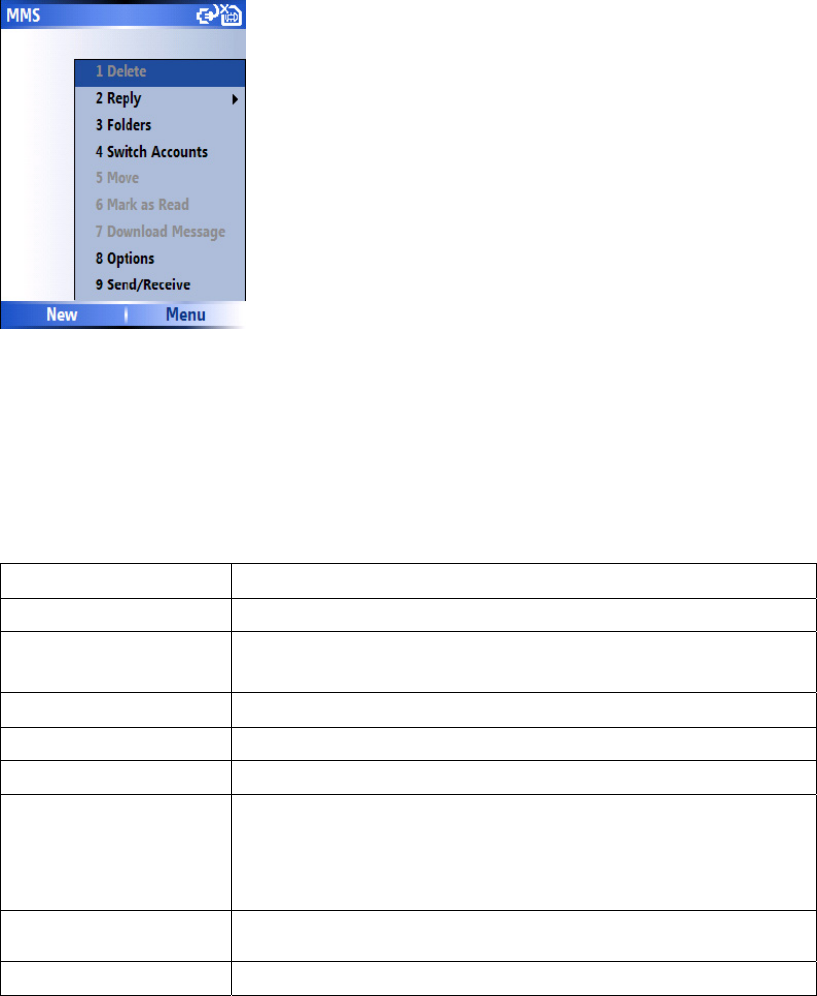
Setting up the MMS account
If your device has not been preconfigured, then you will need to manually enter the
details of the MMS. This is a two-stage process : In stage one you will set up the data
connection, and in the second stage you will define the address of the MMS server on the
internet.
Delete Delete current message
Reply Reply to all and Forward current message
Folders Switch to other folders (including Drafts, Outbox, Inbox, Sent
Items and deleted items)
Switch accounts Switch between Text message, Outlook Email and MMS
Move Move current message into other folders
Mark as read/unread Mark current item as an unread/read one
Download Messages If you have chosen only to take notification of MMS messages
(and not to download the whole message), you can mark a
message for download. At the next Send / Receive the mes-
sage will be downloaded
Options Change the account options for the MMS account
Send/Receive Force a Send or Receive of MMS messages that are pending
Setting up a data connection
First you will need to set up a data connection. You should refer to the ‘Getting
Connected’ section of this manual for more information on setting this up. You will need
the name of the MMS APN and any associated username or password. When you set up
the ‘Connects to’ description , we suggest you set this to ‘Secure WAP Network’ so as to
avoid conflicts with other applications.
Defining the server
From the Home Screen, click Start > Messaging . Highlight the MMS entry, and press
Menu > Settings
On the next page, choose Menu > MMSC Settings, and on the following page choose
Menu > New.
In the Name Field, enter a name for the server details (for example, “My MMSC”)
MMSC URL: Enter the address of the server, as supplied by your mobile service provider
WAP gateway: Enter the WAP gateway to be used for this connection, as supplied by
your mobile serve provider
Port: enter the port number provided to you
Connect Via: You should point the MMS server towards the correct connection point. If
you set the MMS up through ‘Secure WAP network’, then this is what you should also
select here.
Max sending size: You will be advised by your service provider for this value
WAP Version: This also will be given to you by your service provider.
Press Done when you have entered all these details.
On the screen shown next, select your MMS entry by name and choose Menu > Set as
Default. A tick will appear next to its name.
Now press the Home key to return to the Home Screen. Your device is now configured for
MMS.
5.4 Pocket MSN
Pocket MSN on your mobile device provides almost instant access to your MSN Hotmail
inbox, your MSN Messenger contacts list, and options for customizing your Pocket MSN
experience.
MSN Messenger is an instant messaging service hosted by MSN through the Internet. At
the time of writing this User Guide, this service is free of charge.
With Pocket MSN you get:
• MSN Hotmail. Read, write, and send e-mail, or manage your Hotmail folders.
• MSN Messenger. See who’s online. Send and receive instant messages. Subscribe to
status updates for selected contacts so you’re notified when they’re online.
• Options and settings you can use to create a custom Pocket MSN experience.
• To use it, click Start > Pocket MSN (you may have to click More a few times to scroll
thru)
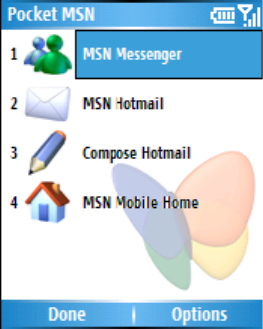
Note: You need to have either a Microsoft .NET Passport (from www.passport.com) or a
Hotmail account (www.hotmail.com) to use MSN Messenger.
Your phone needs to be connected to the Internet.
About MSN Hotmail
With MSN Hotmail on your smartphone, you have access to your Hotmail inbox even
when you’re mobile. Read, send, and reply to e-mail, and manage your folders. Mark
e-mail attachments for downloading so that you can view them.
Pocket MSN overview
With MSN Messenger you can send instant messages to your contacts’ mobile device or
computers. For instructions, select a task below.
Getting started with MSN Messenger
To use MSN Messenger, you need Microsoft Passport Network credentials. After
obtaining credentials, complete the following tasks:
1. Set up a connection with your phone, refer to Chapter-4 Getting connected, that
enables you to connect to the Internet.
2. Set up an MSN Messenger account. For more information, see Set Up an Account.
3. Sign in to MSN Messenger. For more information, see Sign In and Out.
To obtain a Passport, go to http://www.passport.com.
To create a Hotmail account, go to http://www.hotmail.com.
Sign in to Pocket MSN or Hotmail
The sign-in process helps to maintain secure access to your MSN Hotmail and MSN
Messenger accounts. Sign-in lasts for 24 hours, regardless of power or connection loss.
Just being signed in to Pocket MSN does not incur charges, but if you are also signed in
to Messenger, or if you are sending and receiving e-mail you can incur charges.
1. On the Pocket MSN home screen, click Start > More > More > Pocket MSN .
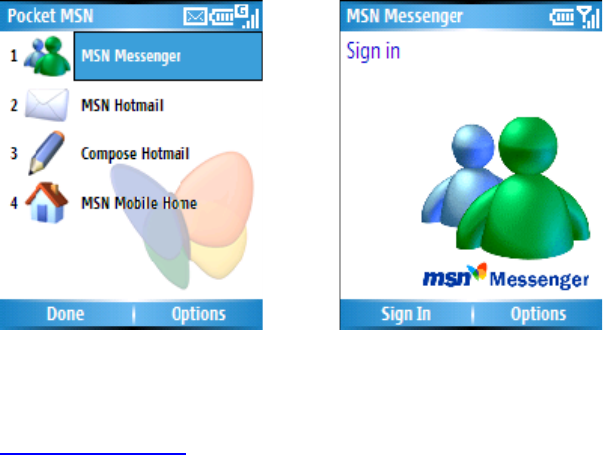
2. Click Messenger or MSN Hotmail , and then enter the e-mail address and password
you use to sign in to MSN Mobile. Click Save password to have Pocket MSN
automatically sign you in.
3. Click Sign in.
Caution This could be a security risk if your mobile device is lost or stolen, others may
gain access to MSN Messenger and Hotmail. If you mobile device is lost or stolen, go to a
computer and change your Microsoft Passport credentials by logging into
www.passport.com
Note: If you have signed into MSN Messenger, you can access to your emails in your
Hotmail account already without having to sign into Hotmail also.
View your Hotmail Inbox
1. In your Hotmail inbox, click Start > Pocket MSN > MSN Hotmail .
2. To synchronize your Hotmail inbox so you see your latest e-mail messages, click
Menu > Send/Receive mail.
Write and send E-mail
1. Click New at the bottom of the Hotmail inbox screen.
2. In the To : field, enter an e-mail address.
3. In Subject , enter the subject of the e-mail.
4. Enter a message in the body of the e-mail, and then click Send .
To write or reply to e-mail while offline, follow the steps above. Then, when you have an
open data connection, click Menu > Send/Receive mail .
Reply to an E-mail Message
1. Select a message in your Hotmail inbox.
2. Click Reply or if you wish to include replying to recipients in the CC field also, click
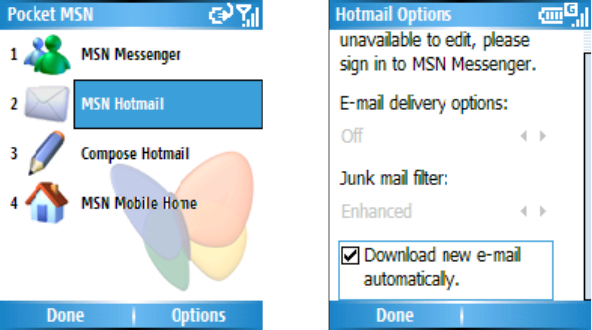
Menu > Reply All
3. Enter the text of your reply, and then click Send.
To write or reply to e-mail while offline, follow the steps above. Then, when you have an
open data connection, click Menu > Send/receive mail.
Keep your Hotmail Inbox always up-to-date
You can set your Hotmail inbox to automatically update with new e-mail whenever you
have an open data connection.
1. In Pocket MSN click Menu > Hotmail.
2. Click Download new e-mail automatically , then click Done .
Delete an E-Mail Message
1. Select a message in your Hotmail inbox.
2. Click Menu > Delete . The message is deleted immediately.
Note: You can also attach Picture and Voice Note files.
3. In Subject , enter the subject of the e-mail.
4. Click Menu > Insert > File, to select a file.
5. Enter a message in the body of the e-mail, and then click Send .
Option and Settings
With Pocket MSN Options you can manage your password settings. For instructions,
select the task below.
Clear the MSN password last saved on your device
When you clear the password that was last saved on this device, you can reenter your
credentials using a new password. You need to do this if you change the password on
your MSN account.
1. On the Home screen, click Start > Pocket MSN.
2. Click Options > General .
3. Click Clear saved password and click Done.
Set up an Account
Before you can use MSN Messenger, you must set up an instant messaging account. For
MSN Messenger Service, you must have Microsoft Passport Network credentials or a
Hotmail account. To use MSN Messenger Service, you need to create a connection to
the Internet.
1. In MSN Messenger, click Menu > Options > Messenger tab.
2. Click Enable MSN Messenger Service. Your sign-in name and password are
established the first time you sign in to Pocket MSN.
3. If necessary, select which account to sign in to first, under Sign in using this account
first.
To obtain a Passport, go to http://www.passport.com
To create a Hotmail account, go to http://www.hotmail.com
Add and Delete Contacts
After you have signed into Messenger, you will be able to perform the functions below.
• To add a contact, click Menu > Add Contact , and then follow the directions on the
screen.
• To delete a contact, select the contact, click Menu > Delete contact . Click Yes to
permanently delete the contact.
Manage Contacts
• To block a contact from seeing your status and sending you messages, select the
contact, and click Menu > Block .
• To unblock a contact, select the blocked contact from the list, and click Menu >
Unblock .
Change Your Display Name
1. In MSN Messenger, click Menu > Options .
2. In My display name, enter the name that you want to display to others in MSN
Messenger, then click Done.
Check your own Messenger Status
• Select your own name at the top of the page. Your current status is indicated in the
displayed list by a bullet point. You can change your status by selecting another status
description.
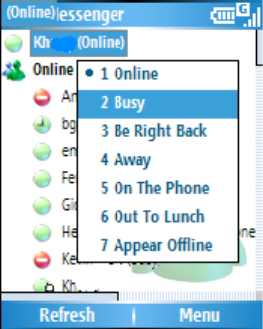
Subscribe to status updates for selected Contacts
When your device has an open data connection, status update notifications alert you
when contacts come online or change their MSN Messenger status.
1. Select the contact.
2. Click Menu > Auto update status .
Let Contacts know you are not available
Select your own name at the top of the page, and then click the desired status description
(such as Away).
Read a Message
• When you receive an alert that a new message has been received, click Chat to switch
to that chat, or Ignore to stay in the current chat.
• To switch between chats, click Menu > Chats , and then select the contact to resume
chatting.
Send a Message
1. Select the contact you want to send a message to.
2. Click Menu > Send message .
3. Enter your message in the text entry area at the bottom of the screen and click Send .
To quickly add common message, select Menu > My text, select a message in the list,
and click Insert.
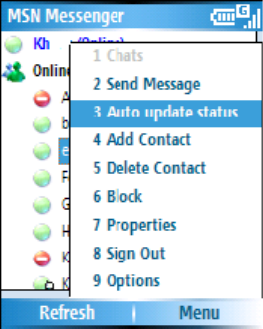
Sign In and Out
1. On the Home screen, click Start > Pocket MSN.
2. Click MSN Messenger > Sign in .
3. Enter the e-mail address and password for your Microsoft Passport Network
credentials or Hotmail account, and click Sign in.
Signing in to an account may take several minutes, depending on your connection speed
and how busy your mobile network is.
• To Signout ,click To sign out, Menu > Sign out .
Chapter 6 Synchronizing
6.1 About ActiveSync
ActiveSync allows you to create a synchronization relationship between your mobile
device and PC, and between your mobile device and your Exchange server. This means
that data shared between your mobile device and PC, or device and Exchange server is
always consistent. If you make a change in one place, the next time you synchronize, the
change is automatically made to the corresponding information on the other computer.
No matter where you are viewing the information, you know it’s up-to-date.
You may connect to your PC using a cable or Bluetooth connection. ActiveSync can also
make it possible for your device to connect to other resources through your PC. However,
you cannot synchronize remotely to a PC using a modem or network connection. The
synchronization relationship is created in order to manage the data that is copied
between your mobile device and PC.
You may connect to your Exchange server using a cellular connection, or you can
connect your device to your PC as a way of connecting back to the Internet.
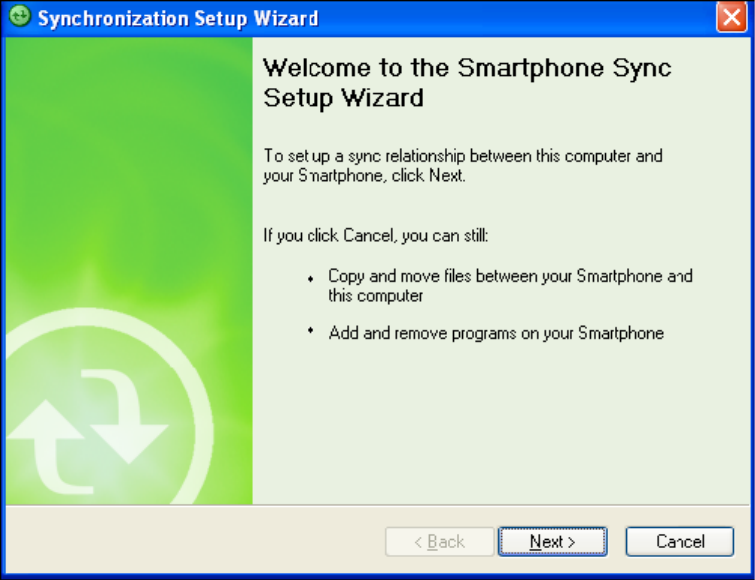
6.2 Install and set up ActiveSync
You can either install ActiveSync from your Windows Mobile Getting started CD or download
a copy of ActiveSync from http://www.microsoft.com/windowsmobile/addons/default.mspx
After the software has been installed and the USB cable is connected between your PC
and the phone, the ActiveSync setup wizard starts up. Click Next to continue.
Note: If you have a PC which is already fully synchronized with your Exchange Server,
then you should sync your phone to your PC the very first time instead of synchronizing
the phone with Exchange Server. Data will be downloaded via your PC and will save you
the charges for traffic volume over the cellular connection (in addition, syncing via your
mobile phone network will take longer than with your PC locally).
If you do not intend to sync directly with Microsoft Exchange Server, do not select the
option below (sync directly with a server). The alternative instead is to sync your phone
with your PC. You cannot do both at the same time. The next few steps are quite
self-explanatory to follow through from the screen information. Please select the
appropriate options required.
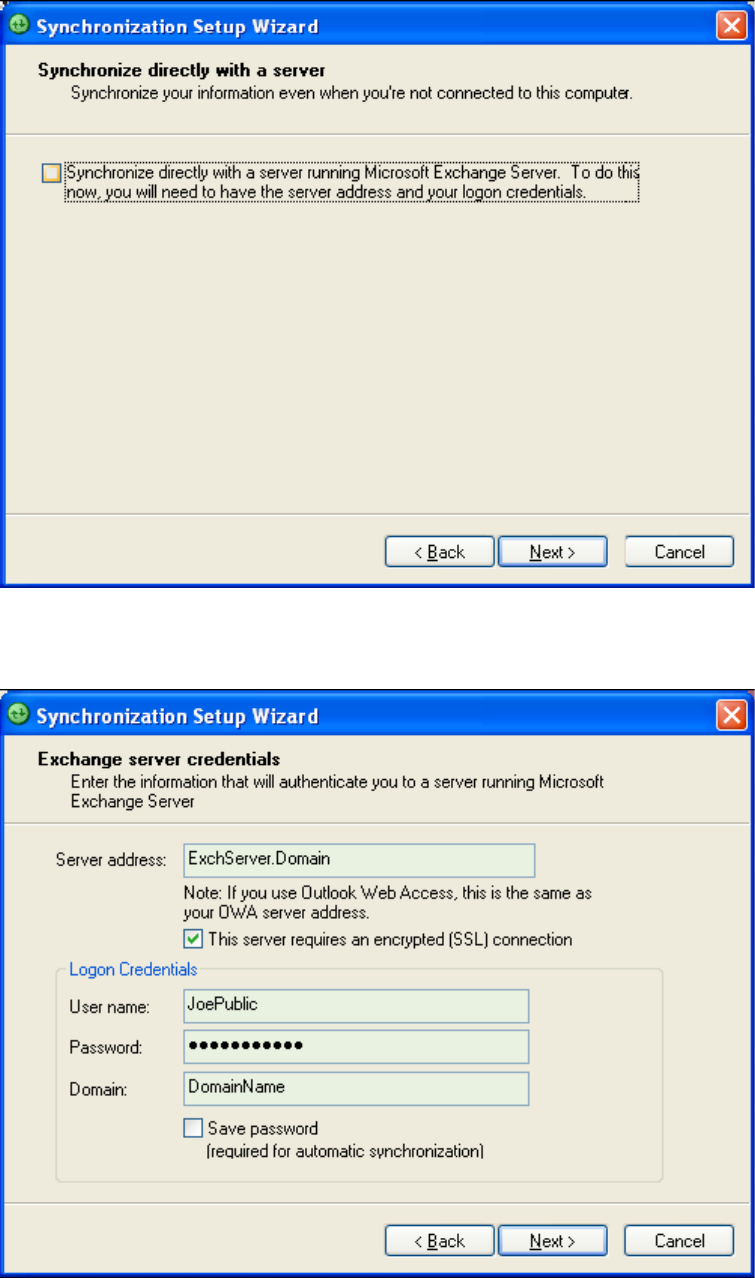
To sync with Exchange Server instead of your PC, click the box above and enter the
Exchange Server details as shown below –
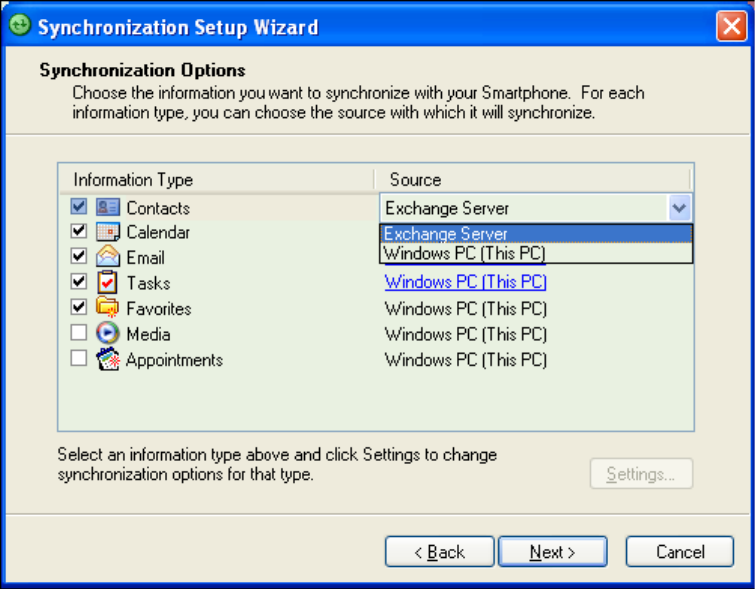
Please ensure that your PC has a connection which is accessible to the Server address
above as the setup will check the connection and that your User name / Password
settings above are valid also.
Note: Ensure that you select correctly in the drop down box for the sync Source below.
The remaining screenshots will sync with the option - Windows PC.
You can view additional settings information by selecting and clicking Settings below.
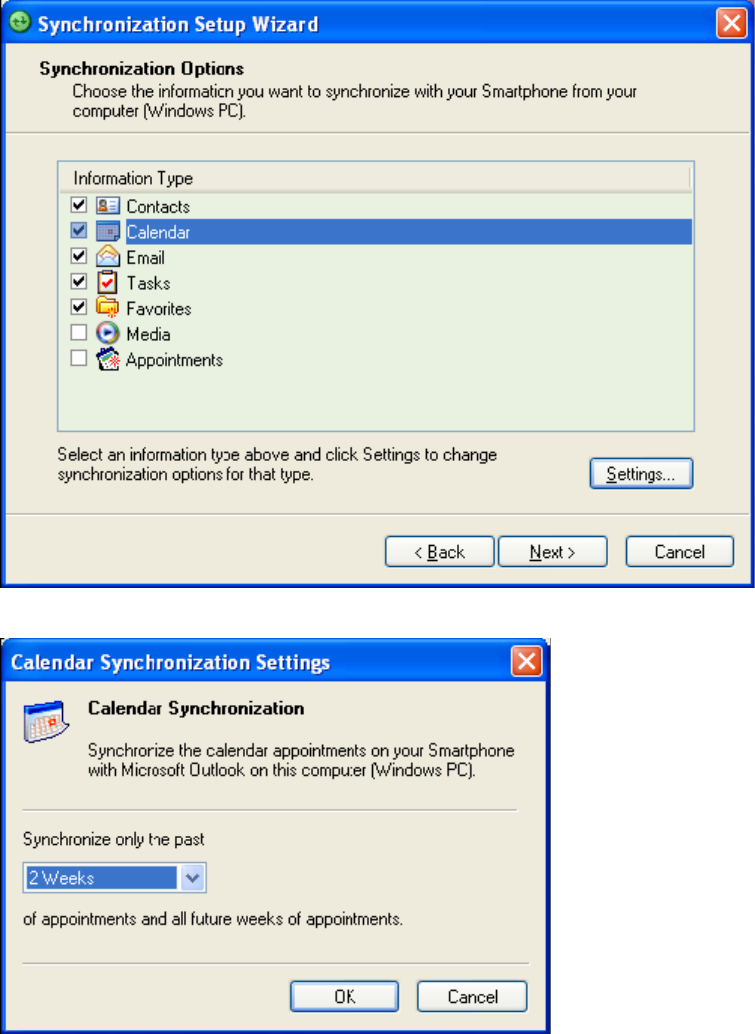
For example, you may choose to synchronize details of your Calendar for the past two
weeks only:
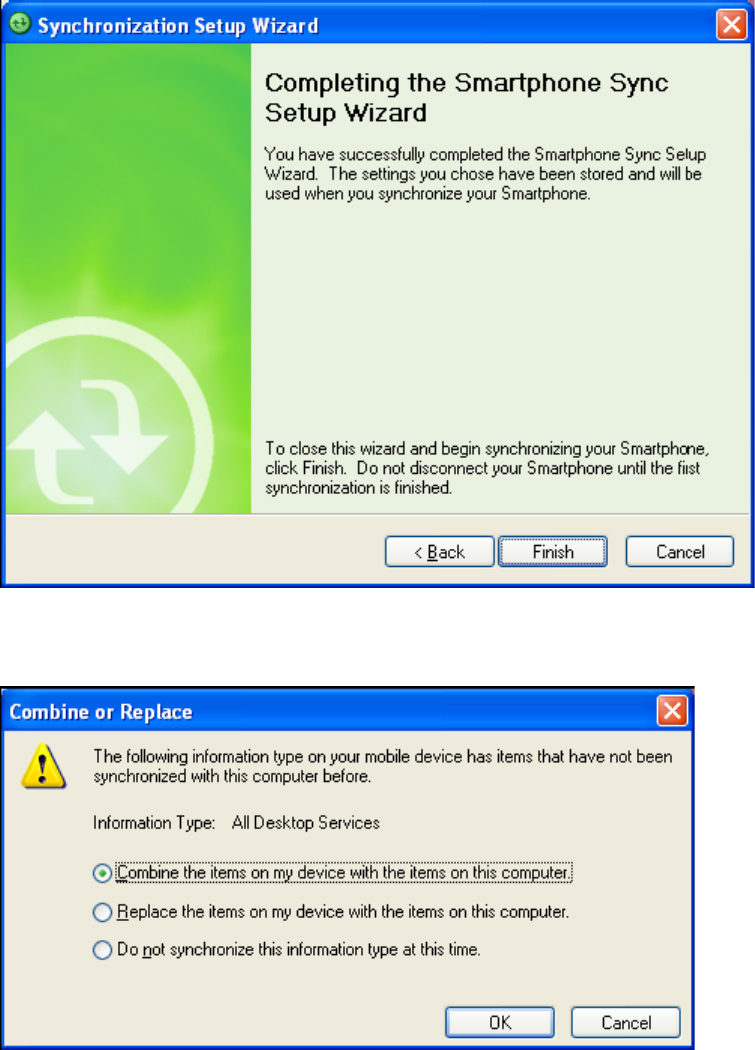
After you click Finish above, you should get a screen prompt as below. This needs to be
selected as appropriate to your own requirements depending on the state of your PC.
The time taken for the sync below depends on how much data is to be synchronize d.
Typically it should not take more than 2- 4 mins or even less depending on the data
volume and responsiveness of your PC.
Once the synchronization has completed successfully, details from your selected data
types will be shown on your home screen. For example in the diagram below, an
upcoming Calendar appointment and unread emails are displayed:
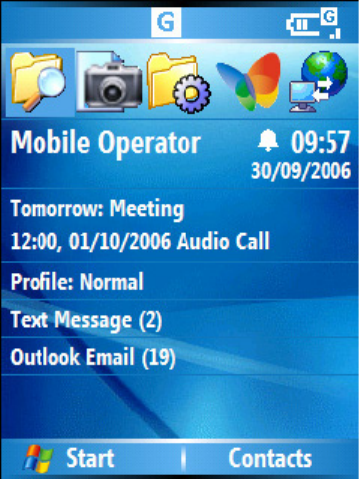
Change ActiveSync settings
Once you set up synchronization using the Sync Setup wizard on the PC, you can later
change your synchronization settings:
• If you want to change Active settings for synchronizing with a PC, use ActiveSync on the
PC. For more information, see “Changing the amount of information synchronized” in
ActiveSync Help on the PC.
• If you want to change ActiveSync settings for synchronizing with Exchange Server, use
ActiveSync on your phone, as described in “Change settings for an information type.”
Note: Before changing synchronization settings on the phone, disconnect it from your
PC.
1. On the phone Home screen, click Start > ActiveSync > Menu > Options.
2. Select one of the information types.
3. Do one of the following:
• To view or change settings for an information type (when available), click Settings.
• To view or change settings for a computer or Exchange Server, click Menu > Settings.
4. Change the amount of information to be synchronized or other settings.
5. Click Done (or Finish in the Exchange Server settings wizard).
Change settings for an information type
Note: To synchronize using ActiveSync, you must install ActiveSync on your PC before
connecting your phone to the PC.
1. Turn on the phone.
2. Connect your phone to your PC using a USB cable or Bluetooth. For more detailed
TBD
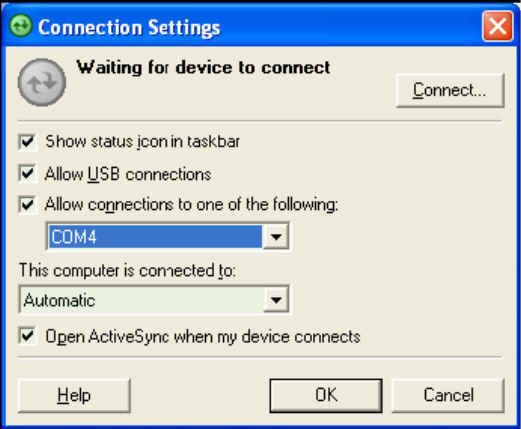
information, see “Connecting a mobile device to a PC” in ActiveSync Help on your PC.
Connect the phone
Connect to a PC using Bluetooth
1. Follow the instructions in ActiveSync Help on the PC for configuring Bluetooth on
your PC to support ActiveSync. Make sure that your PC’s Bluetooth is set to Visible
(also known as ‘Discoverable’), and that Activesync on the PC has the Bluetooth
COM port enabled – see below.
2. On the phone Home screen, click Start > ActiveSync .
3. Click Menu > Connect via Bluetooth . Ensure that the phone and PC are within
close range.
4. If this is the first time you have connected to this PC via Bluetooth, you must
complete the Bluetooth wizard on the phone and set up a Bluetooth partnership with
the PC before synchronizing.
5. Click Sync .
6. When finished, click Menu > Disconnect Bluetooth .
7. To preserve battery power, turn off Bluetooth.
Note: Ensure that the PC ActiveSync Serial port corresponds to the PC’s Bluetooth
Serial port configuration. In the example below the Bluetooth Serial Port has already
been set up COM 4 by the computer. Because COM 4 is allocated to Bluetooth, the
‘Allow connections to one of the following’ has been set to ‘COM 4’ to match this.
As a reference the PC’s Bluetooth Manager (Widcomm in this case) indicates the Blue-
tooth Serial Port as being set to COM4.
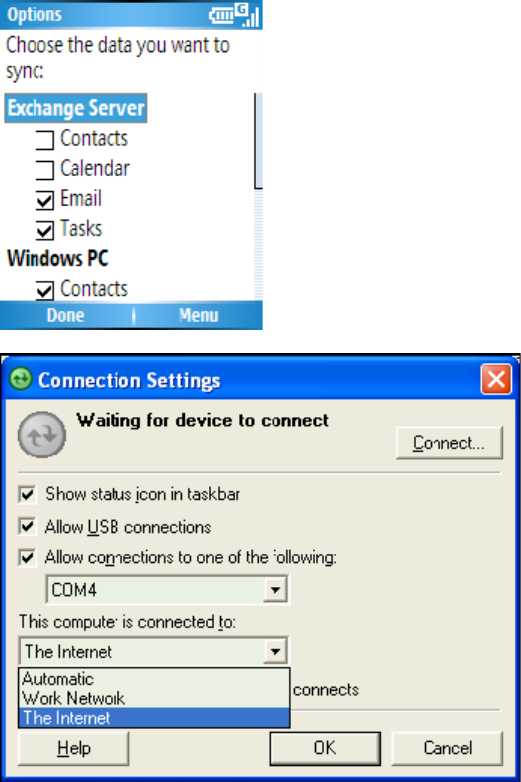
Mixed synchronization settings between Exchange Server and
PC
If you wish to sync your phone to Exchange Server for Email and Tasks, and to your PC
for Contacts and Calendar, from your phone, click Start > ActiveSync > Menu > Options
and select from the list as preferred (see example below).
Connect your phone to your PC via Bluetooth or USB cable next. In this example, you will
also need to setup your PC ActiveSync to select either The Internet for your phone to
contact your Exchange Server thru your PC.
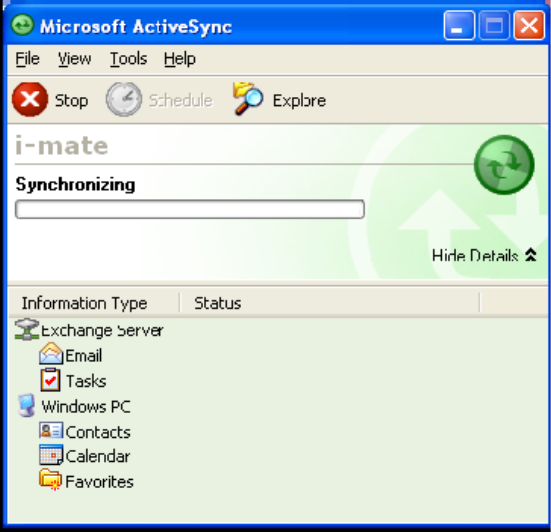
Set up an Exchange Server connection
You can synchronize your email, Calendar Appointment and Contacts directly with your
Exchange server. Tasks may also be synchronized if your company is running Exchange
Server 2003 with Service Pack 2.
The synchronization may be performed over the air using a cellular connection, or by
using your PC as a desktop passthrough. In this final method, you connect your device to
your PC and use the PC’s connection to the internet as the connection for your device
back to the Exchange Server.
To complete this configuration, you will need to get the name of the server and the server
domain name from your service provider or system administrator. You must also know
your Exchange user name and password.
Note: Before changing synchronization settings on the phone, disconnect it from your PC.
You can also refer to some of the screenshots in the previous section of Install and setup
ActiveSync (with Exchange Server).
1. On the phone Home screen, click Start > ActiveSync > Menu > Configure Server. If you
have not yet set up sync with Exchange Server, this will say Add Server Source.
2. In Server address, enter the name of the server running Exchange Server, and click
Next.
3. Enter your user name, password, and domain name, and click Next.
4. If you want the phone to save your password so that you will not need to enter it again
when connecting, select the Save password check box.
5. Select the check boxes for the types of information items that you want to synchronize
with Exchange Server.
6. To change available synchronization settings, select the type of information, and click
Menu > Settings.
7. To change the rules for resolving synchronization conflicts, click Menu > Advanced.
8. Click Finish.
You can start and stop synchronization only if your phone already has a sync relationship
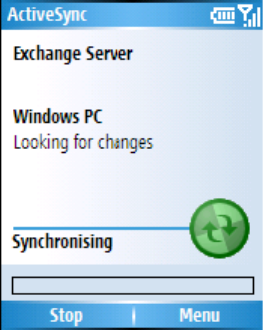
with a PC or Exchange Server.
Start and stop synchronization
1. On the Home screen, click Start > ActiveSync .
2. To start synchronization, click Sync .
3. To stop synchronizing, click Stop . (Note this menu only shows up during the
synchronization)
Synchronizing your Media
Your device is able to synchronize media from your PC, such as music and video. This is
described in detail in Chapter 7.
Note: You can start and stop synchronization only if your phone already has a sync
relationship with a PC or Exchange Server.
Chapter 7 Application & Multimedia
The phone is installed with some applications for you to make better use of your device.
The features and functions are described in the following sections.

7.1 Contacts
Contacts are names of people which you setup to make it easier for you to communicate
with either by phone, SMS or email. Further, you can customize each contact by adding a
picture or a ring tone for example to identify that person who is phoning you.
Create a new contact
1. On the Home screen, click Start > Contacts > New.
2. Enter information for the new contact.
3. Click Done.
If someone who isn’t in your list of contacts calls you or sends you a message, you
can create a contact from Call History or from the message by clicking Menu > Save to
Contacts.
To save an existing contact to your SIM, open the contact and click Menu > Save to SIM.
Create a SIM contact
Contacts can be created and stored on a subscriber identity module (SIM.) If you move
the SIM to another phone, your SIM contacts are moved as well.
1. On the Home screen, click Start > Contacts.
2. Click Menu > New SIM Contact.
3. Enter the contact’s information and click Done.
To save an existing contact to your SIM, open the contact and click Menu > Save to
SIM.
View and edit a contact information
1. On the Home screen, click Start > Contacts.
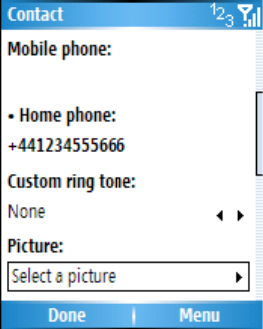
2. Click the contact whose information you want to view.
3. To edit the information, click Menu > Edit .
4. When finished making changes, click Done.
Delete a contact
1. On the Home screen, click Start > Contacts.
2. Scroll to the contact to delete.
3. Click Menu > Delete Contact.
Add a picture to a contact
1. On the Home screen, click Start > Contacts.
2. Click the contact.
3. Click Menu > Edit.
4. Click Picture.
5. Do one of the following:
• Click the picture you want to add.
• Click Camera and take a picture.
6. Click Done
Remove a picture from a contact
1. On the Home screen, click Start > Contacts.
2. Click the contact.
3. Click Menu > Edit.
4. Click Menu > Remove Picture.
Assign a ring tone to a contact
To easily identify who is calling you by the ring tone, you can assign a custom ring tone to
each contact.
1. On the Home screen, click Start > Contacts .
2. Click the contact you want to assign a ring tone to.
3. Click Menu > Edit.
4. Click Custom ring tone and select the ring tone you want.
5. Click Done.
Send contact information
Using a text message, you can quickly send someone information about a contact in your
contact list.
1. On the Home screen, click Start > Contacts.
2. Select the contact.
3. Click Menu > Send Contact > Text Message.
4. Select the contact information that you want to send and click Done.
5. In the new text message, enter the address of the person to whom you are sending the
contact information and click Send.
Assign a category to a contact
You can use categories to help you organize and group your contacts.
1. On the Home screen, click Start > Contacts.
2. Click the contact.
3. Click Menu > Edit.
4. Click Categories – this appears further down the list of items for the contact selected.
5. Select the category you want and click Done.
Note: Categories are shared between your appointments, contacts, and tasks. A
category will remain in the list of shared categories as long as it is assigned to at least
one appointment, contact, or task.
7.2 Calendar
This application works like an electronic diary – it allows you to setup and organise your
events like appointments, meetings and any time- based entry. These entries can then be
displayed as reminders on your phone when this event occurs. Further, if you also use
Outlook from your PC, you can synchronize the information between your PC and phone.
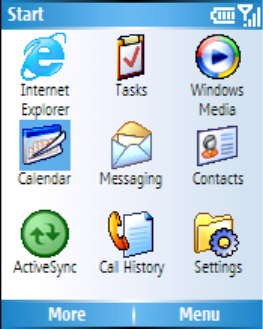
Schedule an appointment
1. On the Home screen, click Start > Calendar.
2. Click Menu > New Appointment.
3. Enter information about the appointment. To schedule an all-day event, under End
time , select All day event .
4. Click Done.
Note: All-day events do not occupy blocks of time in Calendar; instead, they appear in
banners at the top of the calendar.
Make an appointment recurring
1. On the Home screen, click Start > Calendar.
2. Click the appointment and click Edit.
3. Scroll down to Occurs and click one of the recurrence options.
4. Click Done
Update an appointment
1. On the Home screen, click Start > Calendar.
2. Click the appointment and click Edit.
3. If the appointment is recurring, click Yes to edit only the current occurrence, or click No
to edit the series.
4. Make your changes, and click Done.
Delete an appointment
1. On the Home screen, click Start > Calendar.
2. In Agenda view, select the appointment to delete.
3. Click Menu > Delete Appointment.
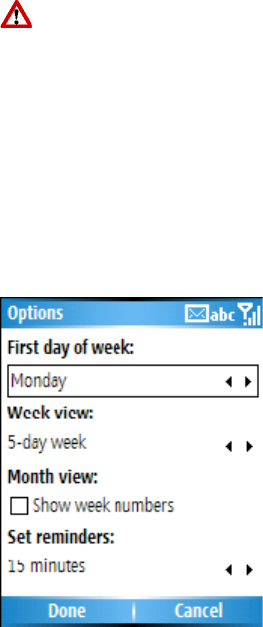
4. If the appointment is recurring, click Yes to delete the series, or click No to delete only
the current occurrence.
Note: When you delete an appointment in Calendar on your phone, it is also deleted on
your PC the next time you synchronize. If the appointment has not been synchronized
with a PC, it will be deleted only from the phone.
Calendar items can be deleted only from Agenda view or from an open calendar
appointment. To delete from other views, open the appointment, and click Menu > Delete.
To cancel a deletion, press BACK.
Change the display of the work week
1. On the Home screen, click Start > Calendar .
2. Click Menu > Options and do one of the following:
• To specify the first day of the week , in First day of week, click Sunday or Monday .
• To specify the number of days you want to appear in a week, in Week view , click
5-day week , 6-day week , or 7-day week.
3. Click Done
Change the reminder time
By default, the reminder time is set 15 minutes prior to an appointment.
1. On the Home screen, click Start > Calendar .
2. Click Menu > Options.
3. Scroll to Set reminders and change the time.
4. Click Done
View today’s agenda
1. On the Home screen, click Start > Calendar.
2. Click Menu > Go to Today .
3. From Week or Month view in Calendar, click Menu > Agenda View.
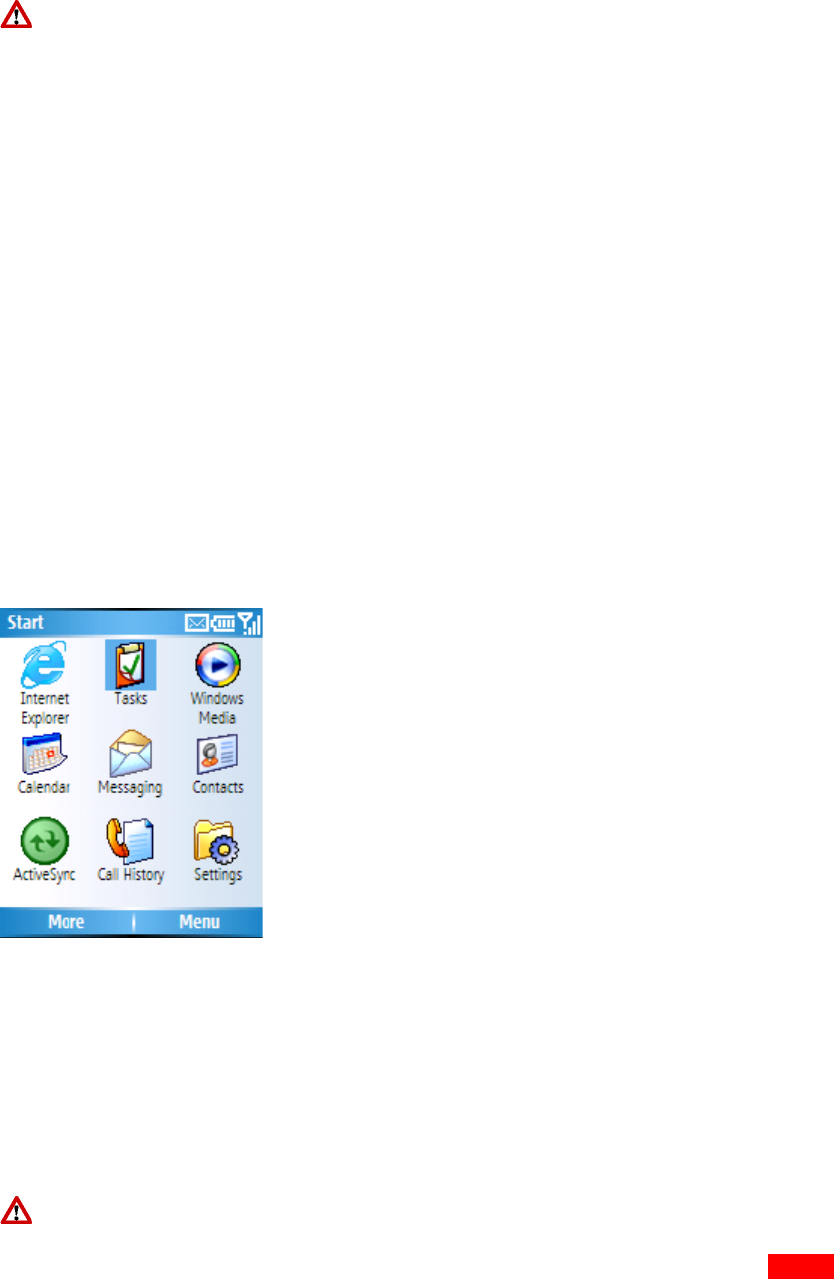
To view previous or approaching dates, scroll left or right, or click Menu > Go to Date.
To quickly view today’s agenda, on the Home screen, click an upcoming appointment (if
one is present).
View your agenda for a specific date
1. On the Home screen, click Start > Calendar.
2. Click Menu > Go to Date.
3. Enter the date to view, and click Done.
View your schedule for the month
1. On the Home screen, click Start > Calendar.
2. Click Menu > Month View.
7.3 Tasks
This application allows you to manage things which need to be done. This can be a
one-off or a recurring task and reminders can be set to display a message when the task
needs to be done by.
Create a task
1. On the Home screen, click Start > Tasks.
2. In the Enter new task here box, press the enter key first and the box will be blanked
out for you to enter the task name. When finished with entering the task name, press
ENTER. A new task item will appear underneath the box.
If you have a PC with Outlook installed and the PC is synchronised with your phone
with tasks included (see Chapter 6 – Synchronization), you will be able to include
additional parameters like dates and reminders in the tasks. These parameters cannot be
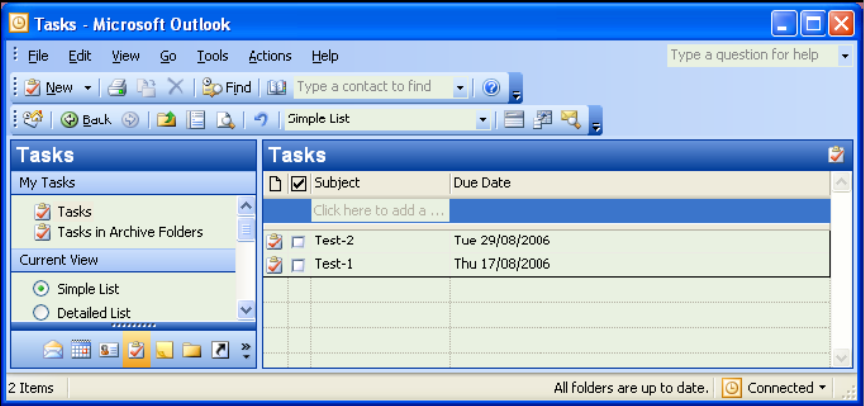
set up in the phone but the tasks
Note: You can synchronize information on your phone with your PC to keep your task list
up to date in both locations.
If you create a new task with a reminder on your PC and then synchronize tasks with your
phone, the reminder will play at the time it was set on your PC.
Delete a task
1. On the Home screen, click Start > Tasks.
2. Select the task, and click Menu > Delete Task.
Mark a task as complete
1. On the Home screen, click Start > Tasks.
2. Select the task, and click Complete.
Change a completed task to incomplete
1. On the Home screen, click Start > Tasks
2. Select the task, and click Activate .
Locate a task
1. On the Home screen, click Start > Tasks.
2. In the task list, do one of the following:
• To sort the list, click Menu > Sort by , and click a sort option.
• To filter the list by category, click Menu > Filter , and click the category you want
displayed.
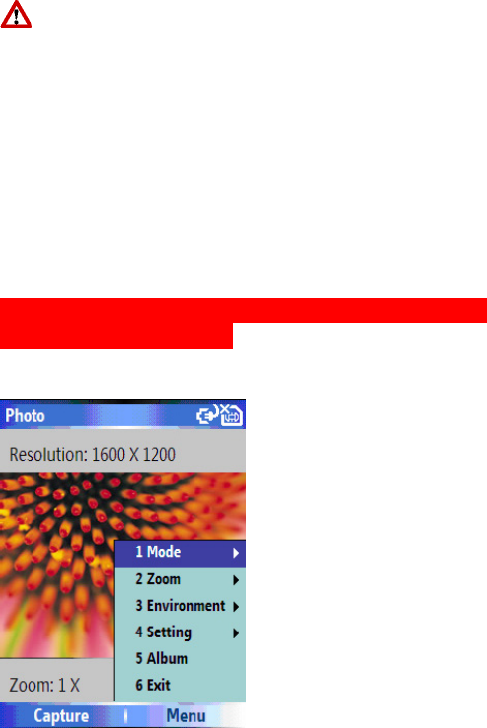
Note: Categories only appear in tasks that are synchronized with your PC.
To filter your task further, click Active Tasks or Completed Tasks.
7.4 Camera and Video Recorder
Your phone is equipped with a digital camera which can be used to capture photos and
video clips.
Capturing a photograph
You can launch the camera application in 2ways –
1. Click Start > Camera
2. Press the camera button on the side of the device.
The camera application will launch.
To take a picture
Point the camera at the subject and either:
• Press the ‘Capture’ button at the bottom left of the screen.
• Press the camera button on the side of the device.
• Press Menu to bring up the list of options.
Mode: here you can set the camera mode. Choose from:
• Photo – Select from single, timer and burst
• Video – Recording videos
Album: This launches the Pictures and Videos application where you can review the
images you have captured.
Zoom: Select different zoom levels, the amount of zoom possible is dependent on the
size of the picture being taken. A picture at resolution 1600 x 1200 cannot be zoomed in,
while a picture at 160 x 120 can be zoomed in to 4 times.
TBD

Landscape: Taken photos or videos horizontally.
Front camera: Taken photos or videos with camera lens face to you.
Environment: To set the colour correction of the camera in order to show the best effect
at the current light. You may also choose to manually set up the correction.
Effect: Choose photo effect like: normal, black & white, ancient, cool color, warm color .
Settings: You can set the resolution for the size of picture to be captured and the naming
convention of the files that are stored.
About: Detail information about the camera.
Exit: Quits the Camera application.
Capturing a video
The phone can also capture videos which you can play back with Windows Media Player
Mobile.
To start the video recorder
Press the camera key on the side of the device and then press Menu > Mode > Video
Press Capture to start recording, and Stop Capture to finish. The total length of video is
determined by the amount of free memory in your device.
Location for Storing Pictures and Videos
All pictures and video files taken with this phone are saved onto the phone’s memory.
However, you can set the smartphone to save them onto a miniSD card.
To do this:
1. Ensure that a miniSD card has been inserted into the phone;
2. Press Menu > Setting > General
3. Choose for the Store Position either ‘Device’ or ‘Storage Card’
Precautions when using the Camera
• Fingerprints or grease sticking to the lens may result in problems such as picture
blurring or the obscuring of images. You should wipe the lens clean with a lens tissue.
• Try not to shake your phone capturing pictures. When capturing pictures, keep the
camera as still as possible. Movement of your device may lead to picture blurring.
• Avoid pointing the camera at bright light sources as this will affect the quality of the
picture.
• Please be considerate of others’ privacy when capturing pictures with your phone.
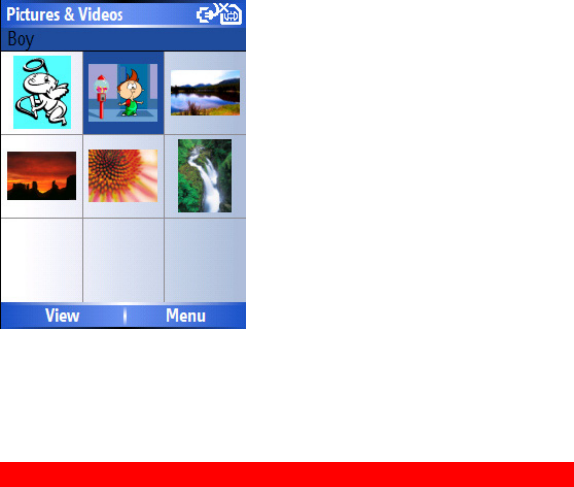
7.5 Pictures and videos
You can view pictures stored in your phone or memory card using the Pictures and
Videos application.
You can also set a picture to be your Home Screen background from here, or you can
send an image to another user.
To use Pictures and Videos
From the Home Screen go to Start > Pictures and Videos
Previewing pictures
On entering the application you will see preview pictures for the items stored in your \My
Pictures folder of your Smartphone. You can press the navigation keys to preview
previous/next picture in turn on the preview screen.
Functions in Pictures & Videos
Press the Menu key to see the options available in the application.
Send: Send pictures to other recipients by means of MMS or email.
Beam: transfer pictures to other users using Bluetooth
Save to Contact: Set a picture as an icon representing a specified contact which is
shown within the details of contact.
Delete: Delete pictures
Edit: allows you to move and copy picture and video files between folders
Play Slide Show: View all pictures in the current folder as a slide show
Folders: you can choose to view pictures stored in other folders on this smartphone.
Options: Configure the Pictures and Videos application .
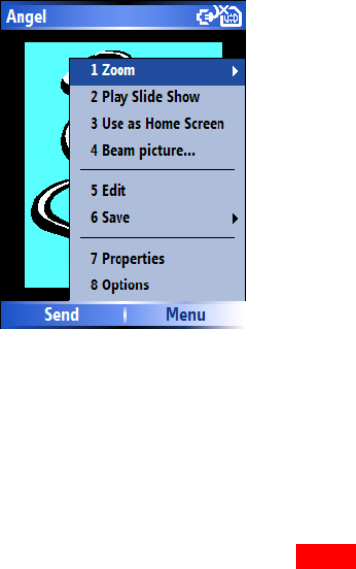
To open a picture
Highlight a picture and press View to open the picture.
To Send the image to another user, press Send, and choose the account by which you
will send it.
For other options, press Menu
Zoom: zoom in or out of the picture detail;
Play slide show: View all pictures as a slide show
Use as home screen: Set the picture as wallpaper for the Home Screen.
Beam picture: Send pictures into other memories by means of Bluetooth.
Edit: Edit pictures;
Save: Associate a picture with a phone contact or rename the image
Properties: View picture properties like file name, size etc;
Options: Sets the properties of the pictures and videos application
7.6 Windows Media Player
Overview of Windows Media Player Mobile
You can use Windows Media Media 10 Mobile for Smartphone to play digital audio and
video files that are stored on your phone or on the Web.
By default, Windows Media Player Mobile can play the following types of files:
• Windows Media Audio (WMA)
• Windows Media Video (WMV)
• Mo tion Picture Experts Group-2 Audio Layer-3 (MP3)
This includes files with the extensions .asf, .wma, .wmv, and .mp3. The phone can also
play back H.263(.3gp) and .mp4 files.
In addition to Windows Mobile- based Smartphones, Windows Media Player is available
on other operating environments, including Windows Mobile-based Pocket PCs and
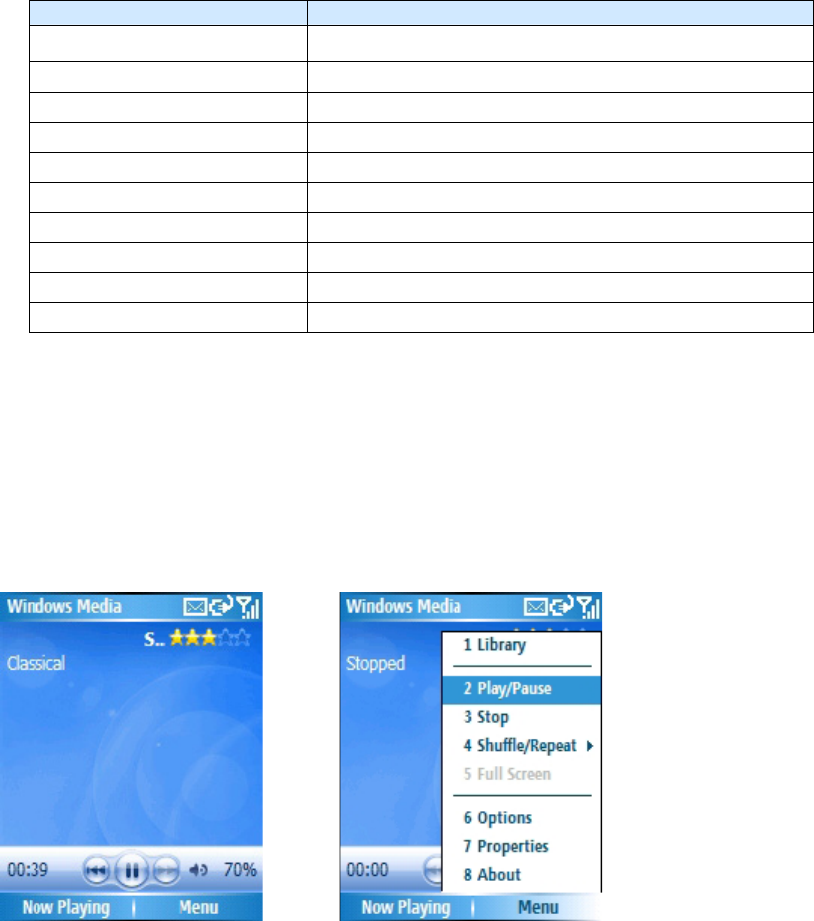
desktop computers running the Windows or Macintosh operating systems.
In this documentation, the version of Windows Media Player for Windows- based desktop
or notebook computers is called the desktop Media and the version for Smartphone is
called the Smartphone Media.
Overview of the controls
By default, these hardware buttons are assigned to Windows Media Player Mobile
functions.
P R E S S T O D O T H I S
ENTER Play or pause a file
NAVIGATION left Skip to a previous file
NAVIGATION right Skip to the next file
NAVIGATION up Increase the volume
NAVIGATION down Decrease the volume
# Turn the sound on or off quickly (mute)
0 Switch to full screen during video playback
* Change rating
NAVIGATION right (hold) Fast-forward a file
NAVIGATION left(hold) Rewind a file
Overview of screens and menus
Windows Media Player Mobile has three primary screens:
Playback screen. The screen that displays the playback controls (such as Play, Pause,
Next, Previous, and Volume), the star rating of the current file, the album art window, and
the video window. You can change the appearance of this screen by choosing a different
skin.
Now Playing screen. The screen that displays the Now Playing playlist. This special
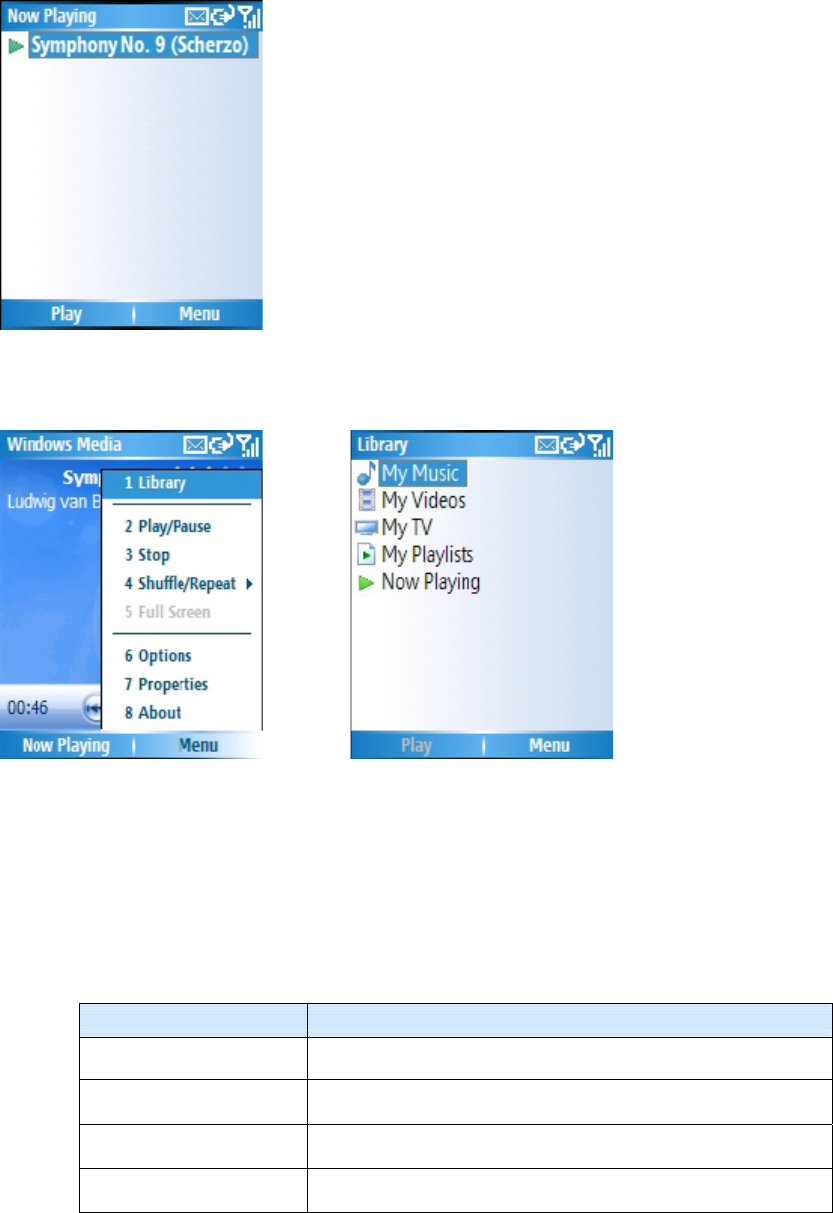
playlist indicates the currently playing file and any files that are queued up to play next.
Library screen. The screen that lets you quickly find your audio files, video files, and
playlists. It contains categories such as My Music, My Video, My TV, and My Playlists. It
also includes a link that lets you switch to the Now Playing screen.
At the bottom of each screen is a menu called Menu. The commands on this menu
change depending upon which screen you are viewing.
• Overview of the Playback screen commands
• Overview of the Now Playing screen commands
• Overview of the Library screen commands
Overview of Now Playing screen commands
THIS COMMAND DOES THIS
Library Displays the Library so you can choose a file to
play.
Move Up Moves the selected item up in the playlist order.
Move Down Moves the selected item down in the playlist order.
Remove from
Playlist Removes the selected item from the playlist.
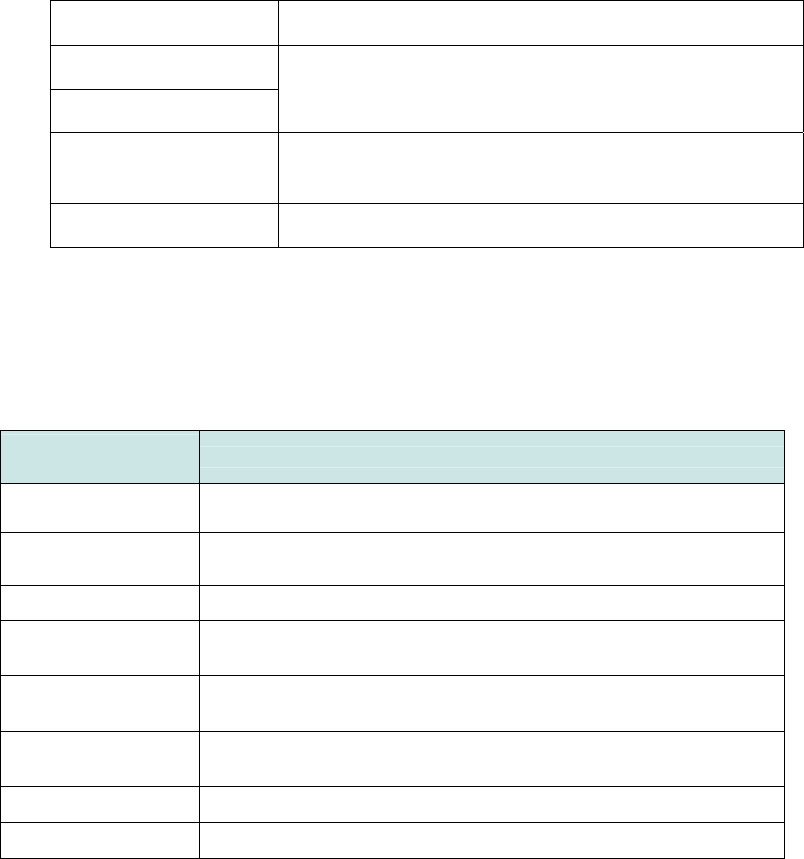
Shuffle/Repeat >
Shuffle
Plays the items in the Now Playing playlist in a
random order.
Shuffle/Repeat >
Repeat
Clear Now Playing
Plays the items in the Now Playing playlist
repeatedly.
Removes all items from the Now Playing playlist.
Error Details
Displayserror information about the selected item
(an exclamation mark appears before the item
name if error details are available).
Properties Displays information about the selected file.
Overview of Library screen commands
When you are viewing the Library screen, these commands appear on Menu.
THIS
COMMAND DOES THIS
Queue Up Adds the selected item to the end of the current (Now
Playing) playlist.
Delete from
Library Deletes the selected item from the library.
Now Playing Displays the Now Playing playlist.
Library > library
name
Lets you switch between libraries, such as between My
Device and Storage Card.
Update Library Adds new items to the library by searching your phone
or storage card.
Open File Lets you find and play files that are stored on your
phone or storage card but that are not in the library.
Open URL Lets you play a file on a network, such as the Internet.
Properties Displays information about the selected file.
Overview of licenses and protected files
Protected files are digital media files that are secured with a license to prevent
unauthorized distribution or playback.
The license specifies how you can use the file. For example, a license can specify
whether you can use the desktop Player to synchronize a file to your phone or how many
times you can play a file on your device. The terms of the license are specified by the
person or company that provided the file.
Licenses are created and managed by using a technology called digital rights
management (DRM). Because Windows Media Player 10.1 Mobile for Smartphone
supports Windows Media DRM 10, you can download and play protected files that you
have obtained from compatible online stores, such as MSN Music. If the license and your
phone permit it, you can even play subscription or rental content from some online stores.
For information about compatible online stores and devices, see the PlaysForSure Web
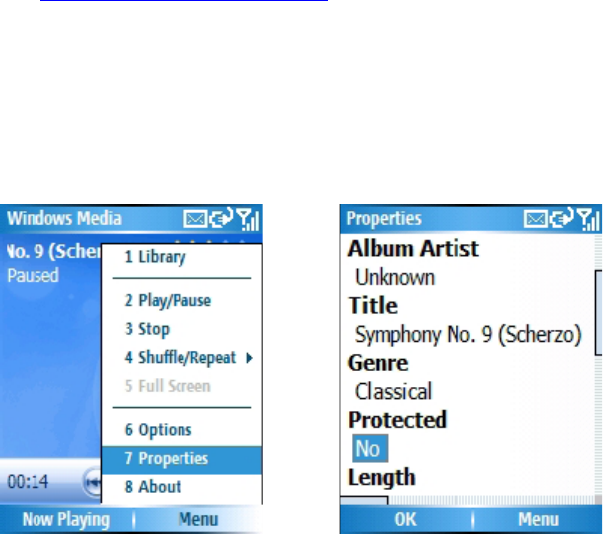
site http://www.playsforsure.com
When copying a protected file from your computer to your phone:
• Always use the desktop version of Windows Media Player 10 to synchronize (copy)
the file to your phone. For example, do not use Windows Explorer to drag and drop
files from your computer to your phone.
• Always synchronize the file to a storage card that is inserted into your phone. Do not
synchronize to a storage card that is inserted into a storage card reader.
Note: You can determine whether a file is protected by viewing its file properties.
Play items on your phone
Use the library to find and play songs, videos, and playlists that are stored on your phone
or removable storage card.
1. If you are not on the Library screen, click Menu > Library .
2. If necessary, on the Library screen, click Menu > Library , and then select the library
that you want to use (for example, Storage Card ).
3. Select a category (for example, My Music or My Playlists ), select the item that you
want to play (such as a song, album, or artist name), and then click Play .
Note: To play a file stored on your phone but that is not in a library, on the Library screen,
click Menu > Open File. Select the item that you want to play (such as a file or a folder),
and then click Play.
Play an item on a network
Use the Open URL command to play a song or video that is stored on the Internet or on a
network server.
1. If you are not on the Library screen, click Menu > Library .
2. Click Menu > Open URL.
3. In the URL box, enter a network address.
- or -
In the History box, select a URL that you have previously used.
Note: To play an item on a network, your phone must be connected to a network. For
more information about connecting your phone to a network, see Chapter 4 - getting
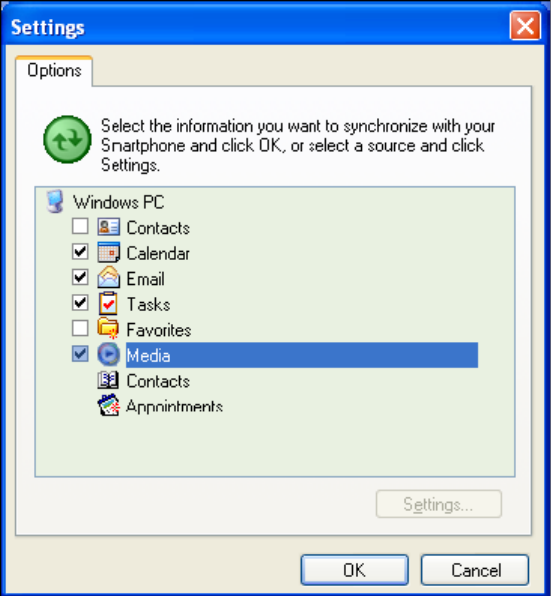
connected.
Copy files to your phone
You can either copy files to your phone manually or if you have a PC, automatically copy
(synchronize) files between your PC and your phone. The latter is described below.
Use the Sync feature in the desktop version of Windows Media Player 10 to synchronize
(copy) digital media files from your computer to your phone. Using Sync ensures that
protected files and album art are copied to your phone correctly.
(Please ensure that you have completed the one-off steps in Chapter-6 for ActiveSync
first and that the checkbox for Media Player has been ticked also in your PC ActiveSync
as shown below as one-off steps again for Media Player).
Select Media to get the next screen below.
Note : if this is greyed out for any reason, please see the Notes at the end of this
subsection about this issue.
At this stage, follow the instructions given here and insert a storage card into your phone
also before proceeding.
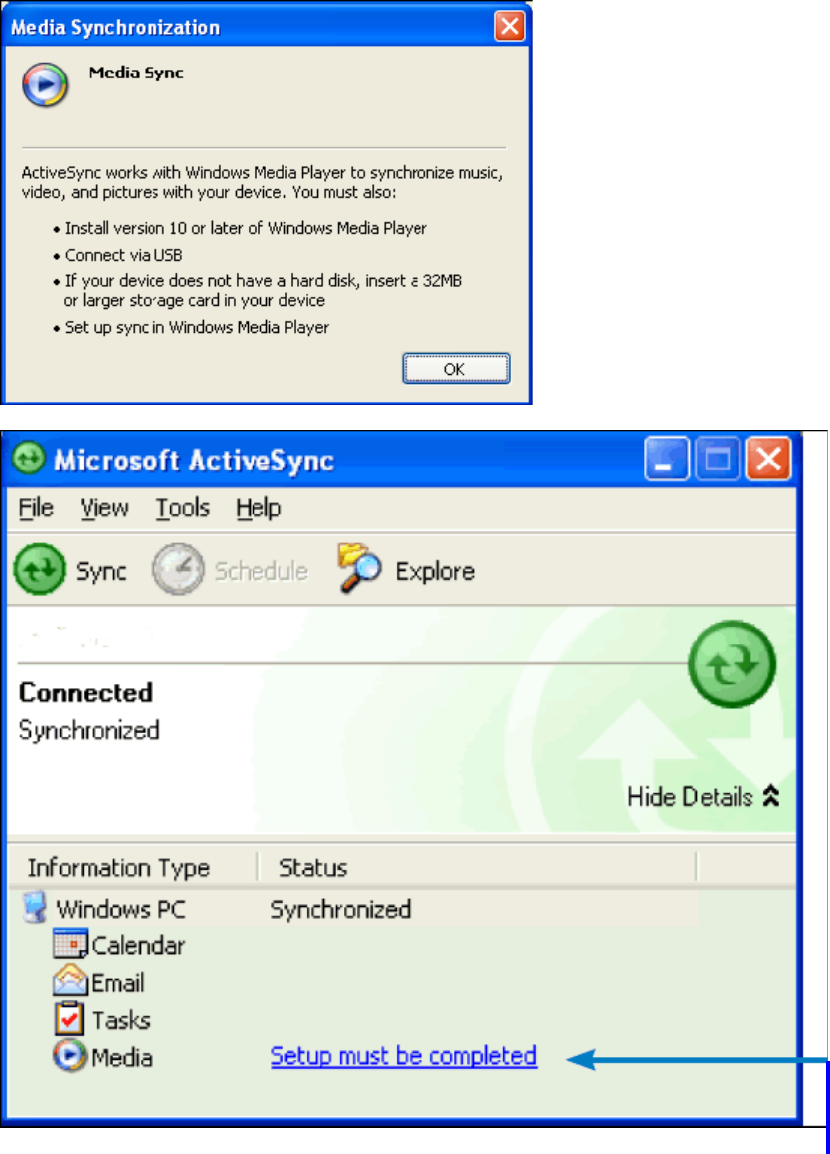
Click this now and follow thru the steps in screenshots
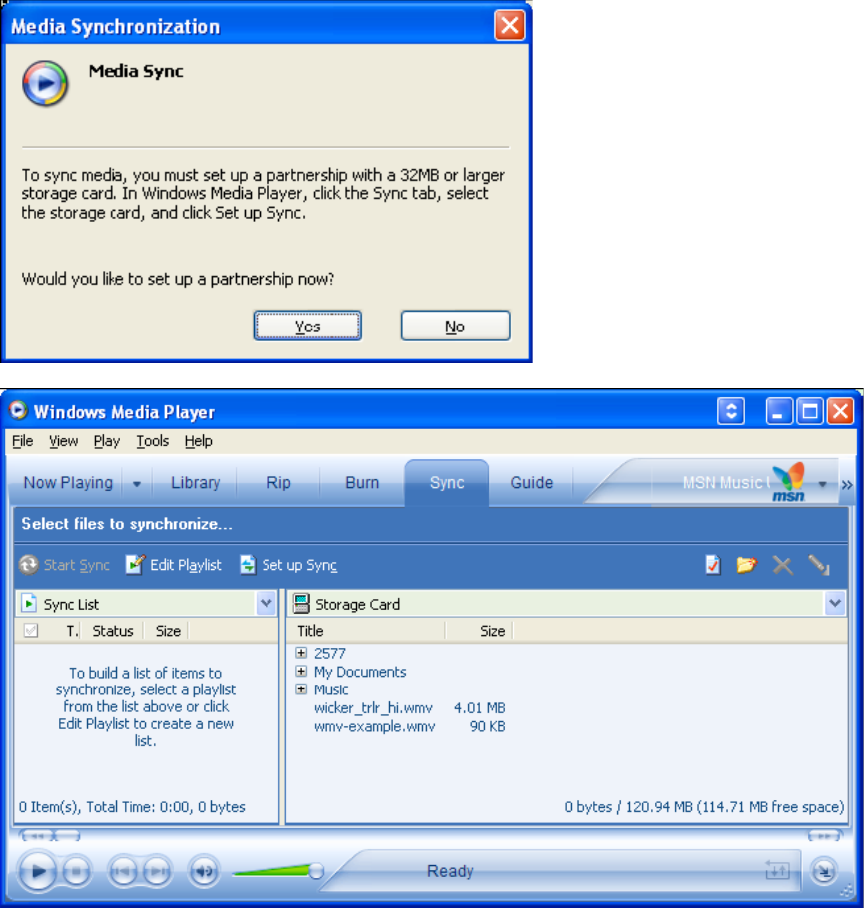
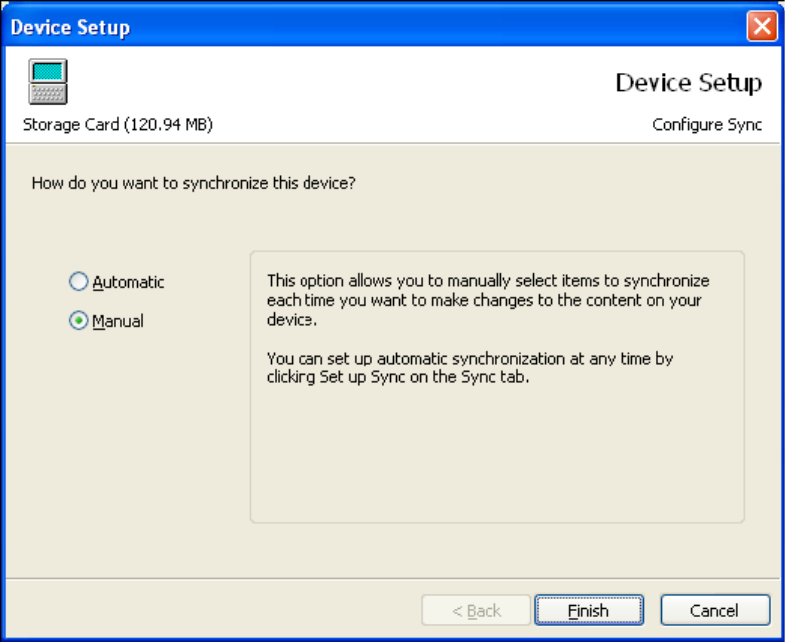
To synchronize content to your phone automatically, do the
following:
1. On your computer, start Windows Media Player 10.
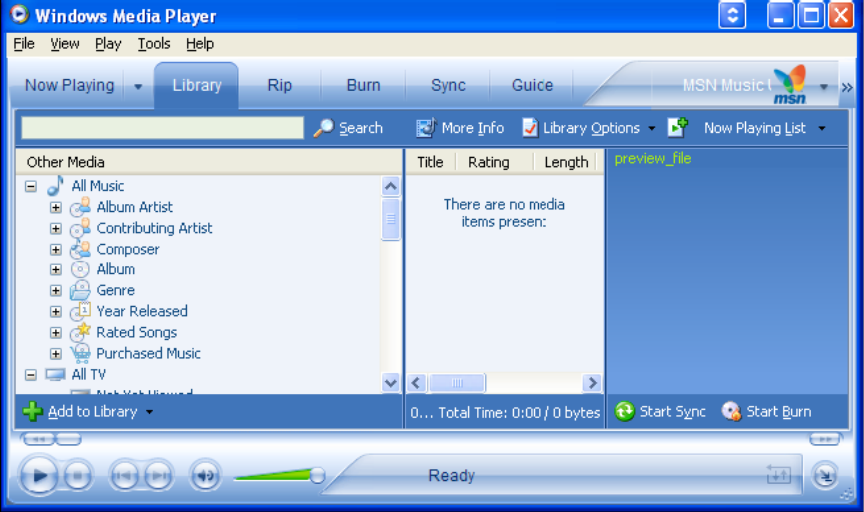
2. Insert a 32 MB or larger storage card into your phone, and then connect your phone
to your computer.
On your computer, the Device Setup Wizard opens.
3. In the wizard, click Automatic, select the Customize the playlists that will be
synchronized check box, and then select the playlists that you want to synchronize.
4. Click Finish.
The files begin synchronizing to your phone. The next time you connect your phone to
your computer while the desktop version of Windows Media Player 10 is running,
synchronization will start automatically.
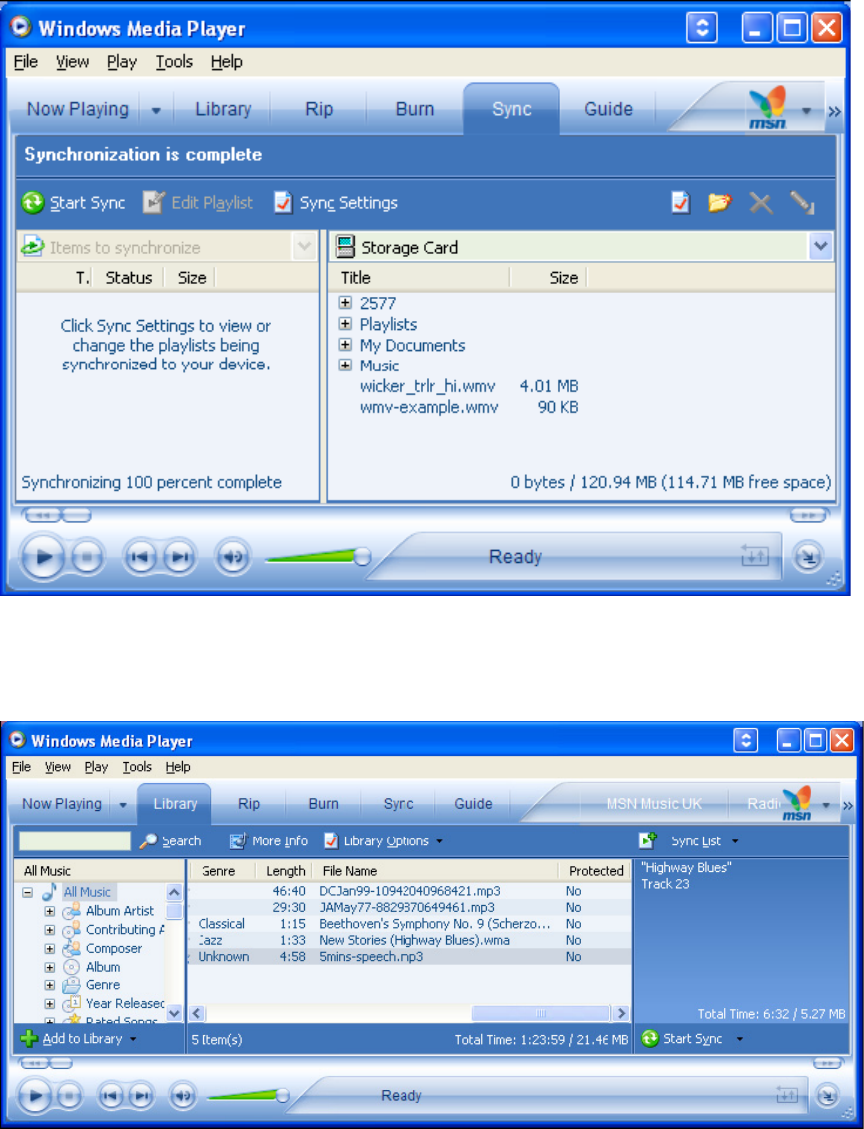
For more information about the Sync feature, start the desktop version of Windows Media
Player 10, and then press F1.
To sync manually, you can also drag and drop items into your Sync List as shown below
–
Note:
• Always use the desktop version of Windows Media Player 10 to synchronize (copy) files
to your phone. For example, do not use Windows Explorer to drag and drop files from
your computer to your phone.
• Always synchronize files to a storage card that is inserted into your phone. Do not
synchronize to a storage card that is inserted into a storage card reader.
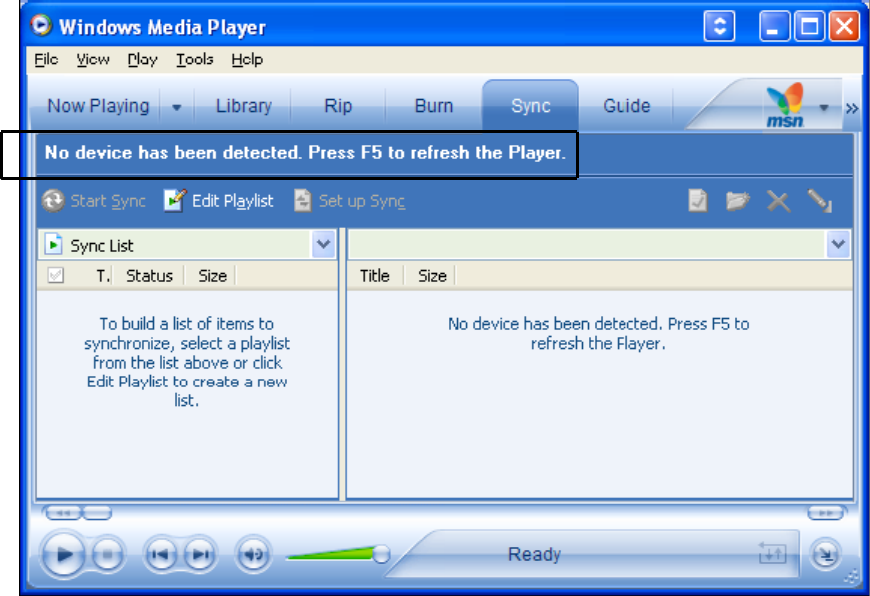
• The desktop version of Windows Media Player 10 is only available for computers
running Windows XP. If you are not running Windows XP on your desktop computer,
use the C opy to CD or Device feature of Windows Media Player 9 Series to copy your
audio files and video files to your phone.
The desktop version of Windows Media Player 9 Series is not as full-featured as the
desktop version of Windows Media Player 10. For example, the desktop version of
Windows Media Player 9 Series does not support automatic synchronization,
synchronization of playlists, synchronization of album art, or synchronization of TV
shows recorded by computers running Windows XP Media Center Edition.
For more information about the Copy to CD or Device feature, start the desktop version of
Windows Media Player 9 Series, and then press F1.
• Audio files copy faster if the desktop Player is configured to automatically set the quality
level for audio files copied to your phone. For more information, see the desktop Player
Help.
• If you get an error message in your PC Windows Media Player - No device has been
detected, you may need to reinstall either the ActiveSync or WMP software in your PC
to circumvent this issue.
Change Player appearance
You can change the appearance of the Playback screen by choosing a new skin.
1. If you are not on the Playback screen, press BACK to display the Playback screen.
2. Click Menu > Options > Skins.
3. To select a skin, press NAVIGATION left or right until you find the skin that you want to
use.
4. Click Done .
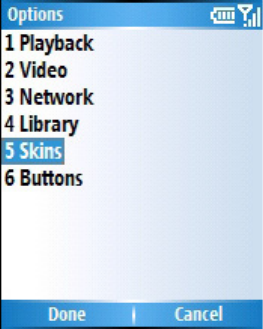
Note: To download new skins, see the WMplugins.com site (http://www.wmplugins.com).
After downloading a skin to your computer and unzipping it if necessary, use ActiveSync
to copy the .skn and .bmp files to your phone (such as to the location My
Smartphone\Program Files\Windows Media Player). To ensure that skins appear on the
Skins tab, do not store skin files in the Windows folder on your phone.
Troubleshooting
If you encounter any difficulty while using Windows Media Player Mobile, a number of
resources are available on the Web to help you troubleshoot the issue, including a list of
frequently asked questions (FAQ).
For more information, see the Troubleshooting Windows Media Player Mobile page at the
Microsoft Web site (http://go.microsoft.com/fwlink/? LinkId= 29195 ).
7.7 Internet Explorer Mobile
Open Internet Explorer
On the Home screen, click Start > Internet Explorer.
Go to a link
1. On the Home screen, click Start > Internet Explorer.
2. Scroll vertically or horizontally to see all available links.
3. Click the link.
Go to a Web page
1. On the Home screen, click Start > Internet Explorer.
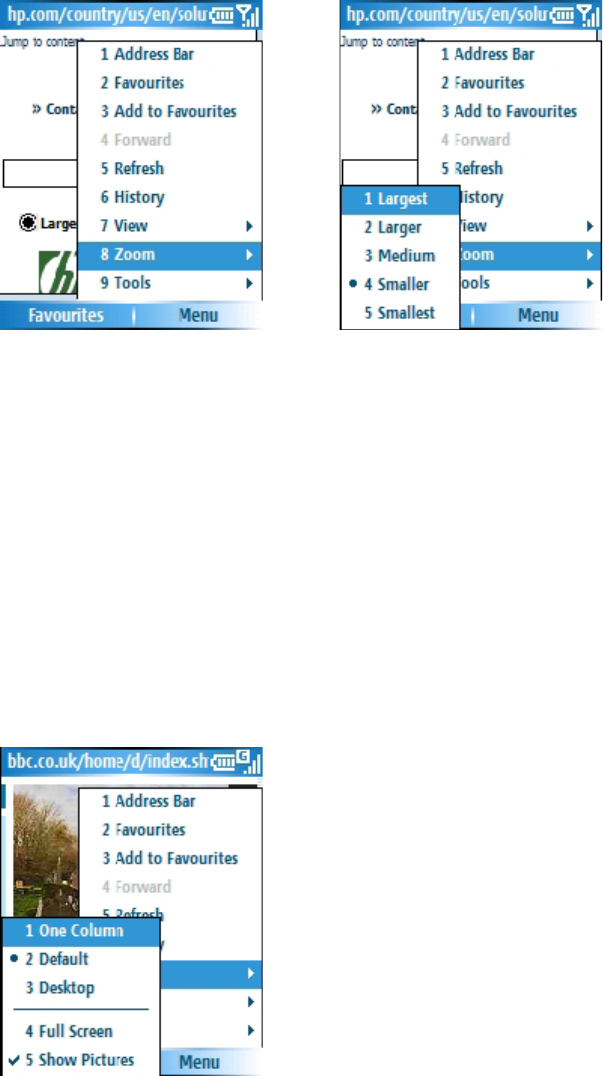
2. Click Menu > Address Bar.
3. Enter the address, and click Go.
Change the size of text on Web pages
1. On the Home screen, click Start > Internet Explorer.
2. Click Menu > Zoom and select the size you want.
Go to a Web page in the History list
1. On the Home screen, click Start > Internet Explorer.
2. Click Menu > History.
3. Select the Web page, and click Go.
Note: To return to the Web page you were viewing, press BACK.
Show or hide pictures on Web pages
1. On the Home screen, click Start > Internet Explorer.
2. Click Menu > View > Show Pictures.
A check mark next to Show Pictures indicates that pictures will be displayed on Web
pages.
View a favorite
1. On the Home screen, click Start > Internet Explorer.
2. Click Favorites.
3. Select a favorite, and click Go
Clear history, cookies, or temporary files
Through frequent use of Internet Explorer, your phone may accumulate lots of pages
which could use up storage space in your device gradually. Occasionally, it may be
advisable to clean this up in order to free up storage for your device.
1. On the Home screen, click Start > Internet Explorer.
2. Click Menu > Tools > Options.
3. Click Memory .
4. Select the type of memory to clear.
5. Click Clear , click Yes , and then click Done.
Send a link via email
1. On the Home screen, click Start > Internet Explorer.
2. Go to the Web page you want to send.
3. Click Menu > Tools > Send Link via E-mail.
4. Select Text Messages or Outlook E-mail .
A new message is created with the page address inserted in the message body.
7.8 Using Java
The phone supports Java applications (know as MIDlets ) that are written especially for
mobile devices. This includes games and utilities.
To start the Java program
From the Home Screen, go to Start > Java. After a few moments you will see the main
screen. Press the Menu key inside this screen to see the menu shown below: :
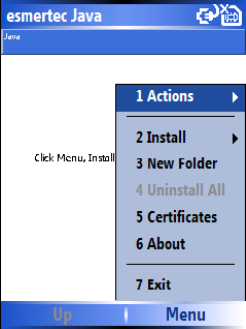
To install a Java application
Press Menu > Install
You can now choose where to find the MIDlets
• To install from a Web site choose ‘Browser’. This will launch Internet Explorer Mobile.
Now navigate to the web site where the Java MIDlet is kept. Select the file and it will be
loaded into the Java application.
• To install from a specific URL, choose ‘URL’. If the URL is already entered, highlight it
and press Go. If it doesn’t exist yet, press Add, then enter the URL description and then
the web address.
• To install from the device, choose ‘Local Files’. All unloaded MIDlets stored in the
\Mobile Device folder will be shown in the window. Choose one from this list to install it.
Selecting the Jad or Jar.
You will be shown the details of the MIDlet you are proposing to install. Press Continue to
proceed with the installation. If the java file is not signed with a trusted certificate, then
you will be prompted if you wish to install it.
Once the file has downloaded, you will be asked where you wish to store the download.
For ease of use you may choose to save this into <root>, which is the base folder of your
smartphone.
To run a Java MIDlet
First you must install the MIDlet using one of the methods described above. The installed
files will be shown on the Java main screen. Scroll down to the desired MIDlet and press
the Enter key to run it.
To Exit the JAVA application
From the main Java screen, choose Menu > Exit
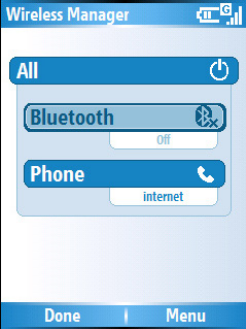
7.9 Wireless Manager
The wireless manager is an application that allows you to easily switch on and off the
Bluetooth and Telephony functionality of your phone.
To start the Wireless Manager, either
• Press and hold the Volume up key, and choose ‘Wireless Manager’ form the Quick List,
or
• From the Home Screen go to Start > Settings > Connections > Wireless Manager
If an item is active then it will be coloured white. If an icon is dark with a cross against it
then it is inactive. In the screenshot above, Bluetooth is switched off while the telephone
function is switched on, and a data connection called ‘internet’ is active.
To turn the telephony element on and off
You may switch off the telephony radio transmission element of the phone by highlighting
the Phone icon and selecting it. Alternatively you may press the ‘3 ’ key. When a cross
appears by the receiver icon, the device is in ‘flight mode ’ for the telephone element. You
will not be able to make or receive telephone calls, nor use the data network of your
operator. However Bluetooth may still be active while the telephone element is switched
off, if you so wish.
To turn the telephony element back on click on the option again, or press the ‘3’ key
again.
To disconnect the current active data connection
You may wish to disconnect the data connection without switching off the telephone. To
do this, go to Menu > Disconnect Cellular Data
Note: The data connection will automatically reconnect itself if you are using the
Direct Push email solution. This is by design as your device must have a connection
permanently open in order to receive emails pushed from the email server. If you
wish to disconnect the data connection under this scenario, first you must disable the
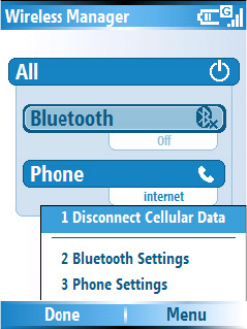
Direct Push email. To do this, from the Home Screen go to Start > Activesync. In
here go to Menu > Schedule. Change the ‘Peak times‘ and ‘Off Peak Times’ to
‘Manually’. When you wish to start the Direct Push email again, you should return to
the Activesync Schedule page and re-choose ‘As Items Arrive’
To turn Bluetooth On and Off
Highlight the Bluetooth option on screen and press in on the navigation pad. Or, you
may alternatively press the ‘2 ’ key.
To make your device visible to other Bluetooth users
Go to Menu > Bluetooth settings. This will take you to the Bluetooth screen
described in chapter 4.3.
To enable and disable all wireless elements
To switch both the Bluetooth and Telephony on or off at once, press the ‘All’
selection or press ‘1’ on the keypad.
7.10 TOSHIBA Sharing Application
TOSHIBA Sharing enables you to use two functions,Remote Keyboard and Remote
Screen. Using Remote Keyboard, you can scroll a PC application displayed on a PC
screen in the direction of four directions using mobile phone from the distant place. Using
Remote Screen, you can display the replica of a LCD screen of your device on PC screen.
Using the PC keyboard and Remote Screen GUI on PC, a keystroke can be carried out to
the device. You can operate the device from a PC.
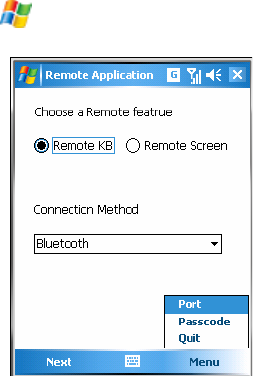
Preparation for using TOSHIBA Sharing Application
・ Sharing Application is beforehand pre-installed in your device
・ Please install Sharing Application to a PC. Sharing Application is recorded on
accompanying CD.
・ Sharing Application supports the communication using one network of USB, Bluetooth,
and Wi-Fi.
・ Please set beforehand to both phone and PC to be able to use the network before
using Sharing Application.
・ Click one of the buttons of Remote Key or Remote Screen on the main console of PC
side.
To start sharing
Then do the following steps on the phone side:
1. On the home screen, click Start > More > Sharing
2.
2. Click the radio button to choose a remote feature: keyboard or screen.
TOSHIBA Sharing Application main screen description:
Remote KB:
If the Remote KB feature is selected, the device could scroll a PC application using its
navigation keys. Shown below is the key assignment of phone.
The Device’s Up Navigation Button performs a Page Up.
The Device’s Down Navigation Button performs a Page Down.
The Device’s Right Navigation Button moves the PC’s cursor to the right.
The Device’s Left Navigation Button moves the PC’s cursor to the left.

Remote Screen:
Remote Screen plays a role as an assistance of a keystroke. You can input a text data
into your device comfortably using the large PC screen and wide pitched PC input device.
Connection method:
You could select the connection method of the device and PC. Those methods are:
Bluetooth, USB and Wi-Fi.
Port:
To set the port of TOSHIBA Sharing click Menu > Port. Shown below is the port setting
screen.
Passcode:
To set the passcode of TOSHIBA Sharing, click Menu > Passcode. Shown below is
the passcode setting screen.
Note:
In the TOSHIBA Sharing Application main screen, if you select “Next” without
setting passcode. This screen appears also, and asks you to set the passcode before
using the application
Hide:
To set the visibility of TOSHIBA Sharing click Menu > Hide
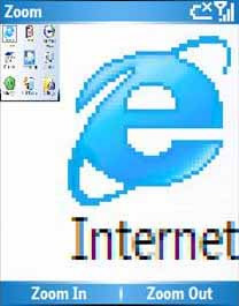
About:
To view the version of Toshiba Sharing click Menu > About
Quit:
To quit Toshiba Sharing click Menu > Quit
7.11 TOSHIBA Zoom Application
TOSHIBA Zoom Application enables you to magnify or decrease the current window
size. The window could be magnified to as large as 8 times of normal size.
You can use the Set Zoom Level dialog box to set a specific zoom level in the Viewer
or in Edit Mode. Zoom application is launched at level x2 (200%). It can be done at
various levels x2 (200%), x4(400%) and x8(800%).
The following operations can be performed:
Long press Volume Up key to lunch the application.
• Press End key to close the zooming application and back to the home screen
• Zoom-in (increasing zoom level) through LSK key. “Zoom In” menu will be disabled
on level “X8”.
• Zoom-out (decreasing zoom level) through RSK key. “Zoom Out” menu will be
changed to “End” on level “X2”.
• Scrolling up in the zoomed screen through Up navigational key
• Scrolling down in the zoomed screen through Down navigational key
• Scrolling right in the zoomed screen through Right navigational keys
• Scrolling left in the zoomed screen through Left navigational key
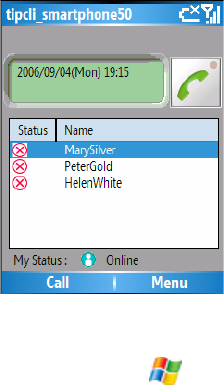
7.12 TOSHIBA VoIP Application
Toshiba VoIP for Smartphone enables you to:
- Call an IP phone (Toshiba VoIP for Smartphone)
- Use answering machine functions
- Check your buddies’ current status (offline, online, busy, or away)
- Notify your buddies of your current status (offline, online, busy, or away)
- Send and receive instant message while you’re talking
Launching an application
To launch Toshiba VoIP for Smartphone, press Start > More > Toshiba VoIP. When
you launch it for the first time, it opens configuration dialog automatically.
Calling an IP phone
To call an IP phone:
1) Open address book by selecting Menu ->Show->Buddy List
2) Choose a buddy on your buddy list.
3) Press Call button on the bottom left.
Answering a call
To answer a call while hearing ringing tone: Press Call button on the bottom left.
Answering a call automatically
In addition to answering a call by pressing Call button while hearing ringing tone, you can
let VoIP answer a call automatically, if you activate this function. When 10 seconds have
passed after a call is received, this application answers it and sends answer message to
a calling party. Your calling party can record his/her voice message after hearing answer
message. The length of recorded message is less than or equal to 20 seconds.
Holding a call
To hold a call, press Menu > User Voice Service > Hold while you’re talking. While
holding a call, if you press Menu > User Voice Service > Hold, you can talk again.
Hanging up
To hang up: Press Call button while you’re talking.
Redialing using outgoing call history
You can redial using outgoing call history. The maximum number of outgoing call history
stored at the same time is 20. If it exceeds the limit, the oldest outgoing call history is
deleted.
To redial using outgoing call history:
1) Open outgoing call history if it’s not by selecting Menu > Show > Outgoing Calls
2) Choose an outgoing call history.
3) Press Call button.
Calling back using incoming call history
You can call back using incoming call history. The maximum number of incoming call
history stored at the same time is 20. If it exceeds the limit, the oldest incoming call
history is deleted whether it has voicemail message or not.
To call back using incoming call history:
1) Open incoming call history if it’s not by selecting Menu > Show > Incoming Calls.
2) Select an incoming call history.
3) Press Call button.
Muting microphone
To mute microphone while you’re talking:
Press Menu > Use Voice Service > Mute
To restore microphone while you’re talking:
Press Menu > Use Voice Service > Mute again
Switching to handsfree mode
When you begin to talk, you can hear your party’s voice from your receiver.
To hear his/her voice from your embedded speaker as handsfree mode:
1) Press Menu > Use Voice Service > Handsfree
To hear his/her voice from your receiver again:
1) Press Menu > Use Voice Service > Handsfree again
Adding a contact to your buddy list
To add a contact: to your buddy list:
1) Press Menu > Edit Buddy List > Add Contact.
2) Enter contact
3) Press OK button if you add it. Otherwise press Cancel button.
Removing a contact from your buddy list
To remove a contact from your buddy list:
1) Open address book if it’s not by selecting Menu > Show > Buddy List.
2) Choose a buddy on your buddy list.
3) Press Menu > Edit Buddy List > Remove Contact.
4) Press OK button if you remove it. Otherwise press Cancel button.
Playing back a voicemail
To play back a voicemail:
1) Open incoming call history if it’s not by selecting Menu > Show > Incoming Calls.
2) Select an incoming call history with voicemail icon.
3) Press Menu > Use Voice Service > Playback Voice Msg.
Instant messaging (IM)
While you connect to another Toshiba VoIP, you can send and receive instant message
each other.
To start instant messaging:
1) Call another Toshiba VoIP user and wait to have the call answered.
2) Press Menu > Send Instant Msg after the call is connected.
3) Type your message in the second text box from the top.
4) Press Send button if you send your message.
All the messages including yours are displayed in the first message box from the top.
Change your current status by using presence service
You can notify your buddies of your current status.
Choose your current status (offline, online, busy or away) after pressing Menu > Change
My Status.
Configuring Toshiba VoIP for Smartphone
Press Menu > Configure Options
Enter your user name, password, server ip, and server port. In addition, if two or more
network adapters are shown, designate a network adapter to use.
If you check “Automatic answer” box, Toshiba VoIP answers a call automatically after
answering timer has expired. Your calling party can record his/her voice message after
hearing answering message.
Troubleshooting
Wrong User Name or Password
Make sure you set your user name or password properly.
Cannot call an VoIP
Make sure you log on to SIP Server.
Check contact information in your buddy list.
Confirm your party’s status is not offline.
Cannot call a phone
Make sure you log on to SIP Server. If you log on to it properly, your status (Online,
Offline, Busy, or Away) is shown.
You cannot hear your party’s voice
Check speaker volume on your Smartphone.
Your party cannot hear your voice
Check microphone volume on your Smartphone.
Make sure muting microphone is not activated.
7.13 SIM Manager
SIM manager enables you to copy your contacts’ information from phone to SIM card or
from SIM card to phone.
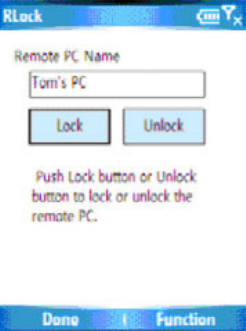
7.14 Remote Lock
To prevent your personal computer (PC) from being operated by others when
you are not at the place, you may lock your personal computer or logoff your
account, and when you come back to your personal computer, you may unlock it.
Usually these operations are troublesome and companied with the password
inputting. SP1 Remote PC Lock/Unlock application is to be designed to simplify
these operations only by pushing a button on the screen of SP1, if you are an Sp1
user. The communication between PC and SP1 is realized by bluetooth.
At the PC side, a service program is running, which waits lock and unlock
commands (requests) from SP1 side by monitoring bluetooth communication
status. If a lock or unlock command comes, the service program locks or unlocks
PC by calling the functions of Gina (Graphical Identification and Authentication).
There are three types of lock methods, Screen Lock, Screen Saver, Logoff.
There is a registration program in PC side that makes the linkage relation of PC
and SP1. By running this program, you can select a lock type, input the password,
make a PC name, and send that information to SP1 side. After having received
acknowledgement from SP1 side, and if acknowledgement is “Yes”, the
registration finishes and the linkage relation will be saved into the memory media
of 2 sides. Then you can lock and unlock your personal computer by pushing of
button on the screen of SP1.
The pictures are shown below to give you a brief outline of lock/unlock
mechanism.
Chapter 8 Maintaining your phone
8.1 Maintaining your phone
Your phone is a well-designed and engineered product and the following tips and
suggestions will enable you to obtain the best use of your phone for many years.
• Keep the phone is a dry environment. If the phone or battery were to get wet due to
misuse, this can invalidate the manufacturer’s warranty.
• Do not use the phone with wet hands to avoid any shocks and risk of water entering
into the device, thereby increasing the risk of damage to internal circuits. This applies
also if you have to replace the SIM or mini SD card inside the phone for whatever
reason.
• Keep the phone and its accessories out of reach of young children and pets. They
may accidentally damage the phone or risk swallowing the smaller components.
• Avoid storing the phone in hot environments as high temperatures can shorten the
life of electronic components. There is the risk that the plastic casings can warp or
melt if the temperature is high enough.
• Also, please avoid storing the phone in cold environments. When the phone is
switched on and warms up to its normal operating temperature, moisture can form
inside the device which may damage the circuit boards internally.
• Avoid dropping or any hard knocks to the phone as these shocks can damage the
internal circuit boards.
• If you need to clean the phone, wipe it with a soft clean cloth – avoid use of cleaning
solvents or detergents. DO NOT use water to clean the LCD screen.
• Do not attempt to respray or paint the phone.
• Do not keep the phone in or near heat sources such as a radiator or microwave oven
– this can cause the battery inside the phone to overheat and explode.
• Ensure that the volume is turned down if you are using headphones.
• If the phone has a flash unit, do not operate the flash too close to the subjects’ eyes
as this may cause damage to their eyes.
• If the phone does not work carry out some basic troubleshooting checks according
to the manual. If the problem still persists, please do not attempt to service or repair
the device yourself as this may invalidate the terms of the warranty with the device.
The repair should be carried out by an authorized service repairer.
8.2 Restarting your device
You may want to restart your phone, for example, when a program is not performing
properly or the phone does not respond to any key presses.
To restart the phone
1. Remove the battery.
2. Reinsert the battery and turn on your phone.
WARNING! If the phone is restarted while a program is running, data that you have
not saved will be lost.
Hard Resetting your Device
If your phone starts to perform badly, you may try to Hard Reset the device to clear the
issue. Note that this will delete all applications you have installed, plus all your
personal data including music, ringtones, pictures etc. You are advised to back up all
of your data before proceeding with this operation.
Note: Use this procedure as a last resort. If you are finding an application is not
running properly, this is most likely to be a conflict between installed programs.
We recommend un-installing the most recently added program first. Follow the
section on ‘removing programs’ in order to do this. Also verify that the program is
designed to be run on this telephone by comparing the requirements to the
information given in the phone under Start > Settings > About.
After a reset you will need to re-install all the programs you had previously.
To hard reset your phone
1. Click Start > Settings > More > Perform Hard Reset.
2. Follow the on-screen instructions to reset the phone.
The phone will restart after it has been reset.
Appendix Other Applications
A.1 Battery Information
Battery performance depends on many factors, including your wireless service
provider’s network configuration, signal strength, the temperature of the environment
in which you operate your phone, the features and/or settings you select and use,
items attached to your phone’s connecting ports, and your voice, data, and other
program usage patterns.
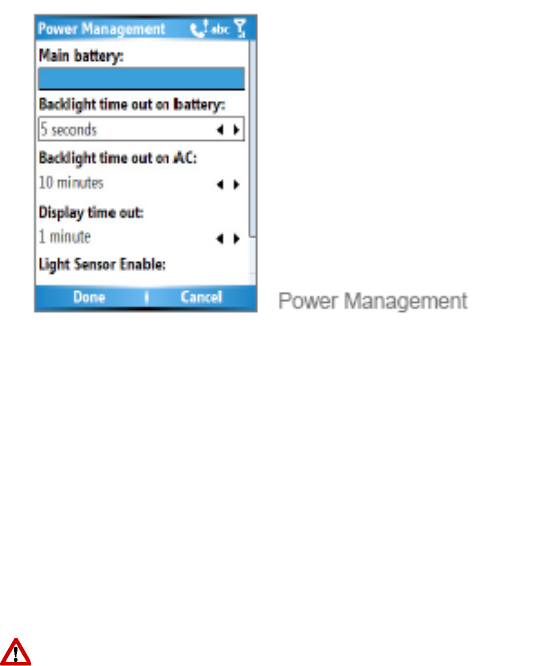
Battery life estimates (approximations)
• Talk time: 4 hours
• GPRS/Internet browsing: 1.5 hours
• Standby time: 150 hours
To check the battery power
• On the Home screen, click Start > Settings > Power Management.
To optimize the power performance
• On the Home screen, click Start > Settings > Power Management , and adjust the
backlight, display, and light sensor settings.
To manage a low battery
When the low-battery warning appears, do the following:
1. Immediately save your current data.
2. Synchronize with your PC to charge the battery.
3. Turn off your phone.
For information about charging the battery, see the Quick Start Guide. \
DANGER OF EXPLOSION IF BATTERY IS INCORRECTLY REPLACED. TO REDUCE
RISK OF FIRE OR BURNS, DO NOT DISASSEMBLE, CRUSH, PUNCTURE, SHORT
EXTERNAL CONTACTS, EXPOSE TO TEMPERATURE ABOVE 60°C (140°F), OR DISPOSE
OF IN FIRE OR WATER. REPLACE ONLY WITH SPECIFIED BATTERIES. RECYCLE OR
DISPOSE OF USED BATTERIES ACCORDING TO THE LOCAL REGULATIONS OR
REFERENCE GUIDE SUPPLIED WITH YOUR PRODUCT.
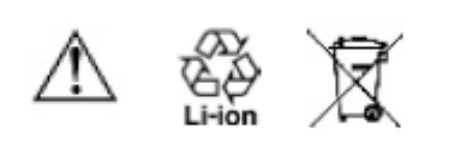
A.2 PC requirements to run ActiveSync 4.2
At the time of writing this manual, the requirements for this were published from M icrosoft’s website for
ActiveSync 4.2 – http://www.microsoft.com/windowsmobile/downloads/as-sysreq42 .mspx
Supported Operating Systems
• Microsoft Windows 2000 Service Pack 4;
• Windows Server 2003 Service Pack 1;
• Windows Server 2003 Service Pack 1 for Itanium powered Systems;
• Windows Server 2003, Datacenter Edition for 64-Bit Itanium-Based Systems;
• Windows XP Professional 64-Bit Edition (Itanium);
• Windows XP Service Pack 1;
• Windows XP Service Pack 2;
• Windows XP Tablet PC Edition;
• Microsoft Windows XP Media Center Edition;
• Microsoft Outlook 2000, Microsoft Outlook XP, or Microsoft Outlook 2003 messaging
and collaboration clients required for synchronization to the desktop or portable
computer of e-mail, Calendar, Contacts, Tasks, and Notes. (Outlook 2003 is
recommended)
• Microsoft Office 2000, Microsoft Office XP or Microsoft Office 2003
• Microsoft Internet Explorer 6.0 or later (required)
• Microsoft Systems Management Server 2.0
The following mobile device operating systems are supported
by ActiveSync 4.2
• Microsoft Windows Mobile 5.0
• Messaging and Security Feature Pack for Microsoft Windows Mobile 5.0
• Microsoft Windows Mobile 2003 Second Edition
• Microsoft Windows Mobile 2003
• Microsoft Pocket PC 2002 , Microsoft Windows CE OS version 3.0
• Microsoft Smartphone 2002 , Microsoft Windows CE OS version 3.0
A.3 Regulatory Notices
Agency identification numbers
To ensure continued reliable and safe operation of your Smartphone, use only the
accessories listed in this document.
This produc t is intended to be used with a certified class 2 limited power source, rated
5.6 volts DC, maximum 750mA power supply unit.
European Union Notice
Products with CE marking comply with the R&TTE Directive (99/5/EC), the EMC
Directive (89/336/EEC) and the Low Voltage Directive (73/ 3/EEC) issued by the
Commission of the European Community.
Compliance with these directives implies conformity to the
following European Norms:
• EN 60950 -1 (IEC 60950) – Safety of Information Technology Equipment.
• ETSI EN 301 511 V9.0.2 (2003-03) for Mobile communications (GSM); Harmonized
standard for mobile stations in the GSM 850 and DCS 1800 bands covering essential
requirements under article 3.2of the R&TTE directive (1999/5/EC)
• ETSI TS 151 010 – 1 V7.0.1(2006-02) Digital cellular telecommunications
system(Phase 2+) Mobile Station (MS) conformance specification; Part 1 :
Conformance specifications
• EN 50360 - 2001 – Product standard to demonstrate the compliance of mobile
phones with the basic restrictions related to human exposure to electromagnetic fields
(300 MHz ~ 3 GHz).
• EN 50361 - 2001 – Basic standard to demonstrate the compliance of mobile
phones with the basic restrictions related to human exposure to electromagnetic fields
(300 MHz ~ 3 GHz).
• ETSI EN 301 489-1 Electromagnetic compatibility and Radio spectrum Matters
(ERM); ElectroMagnetic Compatibility (EMC) standard for radio equipment and
services; Part 1: Common technical requirements.
• ETSI EN 301 489-7 – Electromagnetic compatibility and Radio spectrum Matters
(ERM); ElectroMagnetic Compatibility (EMC) for radio equipment and services; Part 7:
Specific conditions for mobile and portable radio and ancillary equipment of digital
cellular radio telecommunications systems (GSM and DCS).

• ETSI EN 301 489-17 Electromagnetic compatibility and Radio spectrum Matters
(ERM); ElectroMagnetic Compatibility (EMC) standard for radio equipment and
services; Part 17: Specific co nditions for 2.4 GHz wideband transmission systems.
• ETSI EN 300 328 Electromagnetic compatibility and Radio spectrum Matters (ERM);
Wideband Transmission systems; data transmission equipment operating in the 2.4
GHz ISM band and using spread spectrum modulation techniques.
Important Health and Safety Information
Safety Guidelines
Retain and follow all product safety and operating instructions. Observe all warnings
on the product and in the operating instructions.
To reduce the risk of bodily injury, electric shock, fire and damage to the equipment,
observe the following precautions.
General
• Use your phone in the intended manner (holding it to your ear). Incorrect usage may
affect its performance. Only qualified service personnel should install or repair the
phone and its accessories.
• Use only compatible batteries and accessories. Using incompatible items may
permanently damage the phone.
• Do not connect the phone to any other device without reading the provided
documentation. The other device may be incompatible.
• When making emergency calls from your phone, ensure that the phone is switched
on and in service.
• Interference may affect your phone’s performance. Once you move away from the
source of the interference, the phone should operate as usual.
• When the phone is used for extended periods of time, especially in high temperature
conditions, the phone surface could become hot.
Please use caution when touching the phone under such conditions.
Operating environment
• Do not use a hand-held phone while driving or otherwise operating machinery. If
using a hand-held phone, park the vehicle before conversing. If using an integrated
hands-free device, make sure the phone is securely in its holder.
• Switch your phone off if you are entering a hospital or other such institution. Medical
equipment may be affected by the phone so you should observe any building
regulation governing phone usage.
• Switch your phone off when on an aircraft. The aircraft’s systems may be affected by
the phone signal. You are legally obliged to comply with this recommendation.
• Switch your phone off in any facility where posted notices so require.
• Do not use your phone when refueling. You should keep your phone away from fuel
and chemicals.
• Switch your phone off when blasting is in progress. Observe any provided guidelines
or regulations.
• Switch your phone off when in an area with a potentially explosive atmosphere (for
example fuel storage areas, spray paint facilities etc.).
• Only qualified personnel should install the device in a vehicle. Faulty installation or
service may be dangerous and may invalidate any warranty. For more information,
check with the manufacturer or its representative of your vehicle.
Electronic devices
• If you wear a pacemaker, or are in the company of someone who does, you should
be aware that there is small risk of your phone interfering with the operation of the
pacemaker. Only certain types of pacemaker are affected and only if the mobile
phone is placed next to it. You should contact your doctor or the manufacturer of the
pacemaker for more information.
• Your phone may interfere with some hearing aids. If this happens you should contact
your service provider or doctor.
• Your phone may interfere with the functionality of inadequately shielded medical
devices. Consult a physician or the manufacturer of the device to ensure safe
procedure.
• Your phone may interfere with the functionality of any inadequately shielded
electronic system in a motor vehicle. Examples of this type of system include air-bags
and fuel injection. You should contact the manufacturer of the vehicle to ensure that it
is properly shielded.
Battery safety
Your device is powered by a rechargeable battery. The full performance of a new
battery is achieved only after two or three
complete charge and discharge cycles. The battery can be charged and discharged
hundreds of times but it will eventually wear out. When the talk and standby times are
noticeably shorter than normal, buy a new battery.
• A new battery or one that has not been used for a long time could have reduced
capacity the first few times it is used. The battery can only be charged in temperatures
between +5°C (+41°F) and +35°C (+95°F).
• Only use batteries approved by Toshiba and only recharge the battery with the
recommended charger supplied by Toshiba.
• When the charger is not in use disconnect it from the power source.
• Do not leave the battery connect to the charger and power source for longer then
necessary as overcharging it will shorten its life.
• Do not short-circuit the battery. Accidental short-circulating can occur when a
metallic object causes a direct connection between the + and - terminals of the
battery.
• Do not leave the battery in a cold (for example, a fridge) or hot place (for example, in
a car exposed to direct sunlight) as this will effect its performance.
• Do not dispose of the battery in a fire.
• Do not dispose of the battery in an ordinary bin. The battery contains toxic chemicals
and must be disposed of in the correct manner. Contact your local authority for more
information.
Emergency Calls
Calls cannot be made to emergency services while data communication is being
performed within a GSM area. If the system mode is set to UMTS Only or GSM Only,
calls cannot be made to emergency services if the selected network is unavailable.
Also, calls may not be able to be made to emergency services depending on the
network services of some service providers. You can still make calls to emergency
services when the SIM card is not inserted, the SIM card is locked, the phone lock is
set, Fixed Dialing Numbers is set, flight mode is set or call barring service is set.
However, there is no guarantee that a connection can be established in all countries
and areas because operation of your phone differs depending on the wireless network,
wireless signal and your phone’s setting status. Do not rely on just your mobile phone
when you need to make important calls such as calls to emergency services.
FCC RF Exposure Information
Your handset is a radio transmitter and receiver. It is designed and manufactured not
to exceed the emission limits for exposure to radio frequency (RF) energy set by the
Federal Communications Commission of the U.S. Government.
The guidelines are based on standards that were developed by independent scientific
organizations through periodic and thorough evaluation of scientific studies. The
standards include a substantial safety margin designed to assure the safety of all
persons, regardless of age and health.
The exposure standard for wireless handsets employs a unit of measurement known
as the Specific Absorption Rate, or SAR. The SAR limit set by the FCC is 1.6W/kg.
The tests are performed in positions and locations (e.g., at the ear and worn on the
body) as required by the FCC for each model. The highest SAR value for this model
handset when tested for use at the ear is 0.218 W/kg and when worn on the body, as
described in this user guide, is 1.439 W/kg. Body-worn Operation; This device was
tested for typical body worn operations with the back of the handset kept 1.5cm from
the body. To maintain compliance with FCC RF exposure requirements, use
accessories that maintain a 1.5cm separation distance between the user's body and
the back of the handset. The use of belt clips, holsters and similar accessories should
not contain metallic components in its assembly. The use of accessories that do not
satisfy these requirements may not comply with FCC RF exposure requirements, and
should be avoided.
The FCC has granted an Equipment Authorization for this model handset with all
reported SAR levels evaluated as in compliance with the FCC RF emission guidelines.
SAR information on this model handset is on file with the FCC and can be found under
the Display Grant section of http://www.fcc.gov/oet/fccid after searching on FCC ID
SP2-RG4-E01.
Additional information on Specific Absorption Rates (SAR) can be found on the
Cellular Telecommunications & Internet Association (CTIA) website at
http://www.phonefacts.net.
European RF Exposure Information
Your mobile device is a radio transmitter and receiver. It is designed not to exceed the
limits for exposure to radio waves recommended by international guidelines. These
guidelines were developed by the independent scientific organization ICNIRP and
include safety margins designed to assure the protection of all persons, regardless of
age and health.
The guidelines use a unit of measurement known as the Specific Absorption Rate, or
SAR. The SAR limit for mobile devices is 2 W/kg and the highest SAR value for this
device when tested at the ear was ????? W/kg*. As mobile devices offer a range of
functions, they can be used in other positions, such as on the body as described in
this user guide**. In this case, the highest tested SAR value is ????? W/kg*. As SAR
is measured utilizing the devices highest transmitting power the actual SAR of this
device while operating is typically below that indicated above. This is due to automatic
changes to the power level of the device to ensure it only uses the minimum level
required to reach the network.
The World Health Organization has stated that present scientific information does not
indicate the need for any special precautions for the use of mobile devices. They note
that if you want to reduce your exposure then you can do so by limiting the length of
calls or using a ‘hands-free’ device to keep the mobile phone away from the head and
body. Additional Information can be found on the websites of the World Health
Organization (http://www.who.int/emf).
* The tests are carried out in accordance with international guidelines for testing.
* Please see the <FCC RF Exposure Information> section about body worn operation.
Heed service markings
Except as explained elsewhere in the Operating or Service documentation, do not
service any product yourself. Service needed on components inside these
compartments should be done by an authorized service technician or provider.
Use product with approved equipment
This product should be used only with personal computer and options identified as
suitable for use with your equipment.

Cleaning
Unplug the product from the wall outlet before cleaning. Do not use liquid cleaners or
aerosol cleaners. Use a damp cloth for cleaning, but NEVER use water to clean the
LCD screen.
WEEE Notice
The Directiv on Weste Electrical and Electronic Equipment (WEEE), which entered
into force as European law on 13th F ebruary 2003, resulted in a major change in the
treatment of electrical equipment at end-of-life.
The purpose of this Directive is, as a first priority, the prevention of WEEE, and in
addition, to promote the reuse, recycling and other forms of recovery of such wastes
so as to reduce disposal.
The WEEE logo (shown on the top) on the product or on its box indicates that this
product must not be disposed of or dumped with your other household waste. You are
liable to dispose of all your electronic or electrical waste equipment by relocating over
to the specified collection point of recycling of such hazardous waste. Isolated
collection and proper recovery of your electronic and electronical wates equipment at
the time of disposal will allow us to help conserving natural resources. Moreover,
proper recycling of the electronic and electrical waste equipment will ensure safety of
human health and environment. For more information about electronic and electrical
waste equipment disposal, recovery, and collection points, please contact your local
city centre, household waste disposal service, shop from where you purchased the
equipment, or manufacturer of the equipment.
RoHS Compliance
This product is in compliance with Directive 2002 /95/EC of the European Parliament
and of the Council of 27 January 2003, on the restriction of the use of certain
hazardous substances in electrical and electronic equipment (RoHS) and its
amendments.
A.4 Screen Resolution
Type . 2.2” QVGA TFT-LCD
64K colours